MARVEL STORIES PRODUCED IN THE UK
Marvel
overseas central page; Marvel
overseas stories by character list
Jump to: Americas;
Asia;
Europe;
Oceania
Jump to: Australia;
Brazil;
China;
France;
Germany;
India;
Indonesia; Italy;
Japan;
Mexico;
Netherlands;
Portugal;
South
Korea; Spain;
Turkey;
UK
U.K.
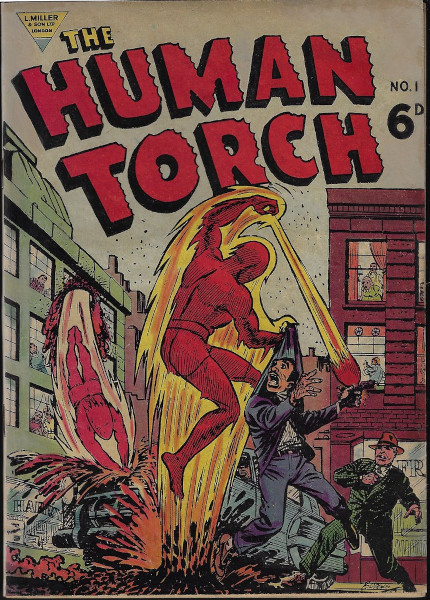
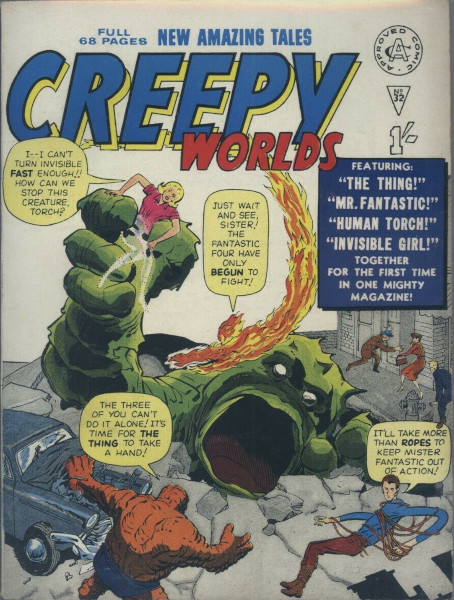 A preamble: Of all the countries
outside the United States, the U.K. is probably the most well known for
producing new stories, largely because the British branch of the company,
Marvel U.K. not only produced some iconic tales by noted writers and
artists (c.f. Moore and Davis' Captain Britain) that were then referred
back to in the American comics, but also because they had an entire line
of comics that were distributed in the States. However, the history of
Marvel comics in the U.K. goes back further than the 1970s founding of
Marvel U.K., and is far more extensive than most people realize. Having
now tried to catalogue all the new material related to Marvel that was
produced all around the world, and discovered that there was so much more
than most people were aware of, I think it's still fair to say that the
U.K. has generated more new Marvel-related content than any other country
outside the U.S.A., and possibly more than all the other non-U.S.
countries combined.
A preamble: Of all the countries
outside the United States, the U.K. is probably the most well known for
producing new stories, largely because the British branch of the company,
Marvel U.K. not only produced some iconic tales by noted writers and
artists (c.f. Moore and Davis' Captain Britain) that were then referred
back to in the American comics, but also because they had an entire line
of comics that were distributed in the States. However, the history of
Marvel comics in the U.K. goes back further than the 1970s founding of
Marvel U.K., and is far more extensive than most people realize. Having
now tried to catalogue all the new material related to Marvel that was
produced all around the world, and discovered that there was so much more
than most people were aware of, I think it's still fair to say that the
U.K. has generated more new Marvel-related content than any other country
outside the U.S.A., and possibly more than all the other non-U.S.
countries combined.
During World War II the direct importation of American
periodicals, not just comics, was banned, in an effort to help promote
homegrown products which were struggling to survive with paper shortages
and the general woes of a country at war. American comics still made it
over, but as ballast on ships or brought over by American G.I.s. Even
after the war, the import ban remained in place as the British economy
struggled to recover, and so the stage was set for enterprising British
comic companies to pursue getting licenses to reprint the American stories
U.K. readers could not otherwise get their hands on. In the mid-1950s,
well prior to the formation of Marvel U.K., L. Miller and Son became (to
the best of my knowledge) the first UK company to reprint Marvel strips in
Britain, in titles such as "Human Torch"; though the superhero revival in
the U.S. proved short, abruptly ending L. Miller's reprints of same, the
U.K. company carried on with reprints of Atlas Comics' horror and Western
titles, continuing on into the 1960s. During the latter part of the 1950s
creator Mick Anglo, who was already providing L. Miller with Marvelman
stories, was put in charge of the company's Western titles, and he added
some new stories for Atlas' Western titles alongside the reprints,
producing what are, afaik, the earliest original U.K. material set in
Atlas Comics' continuity (not yet known as the Marvel universe). As
Marvel's superheroes gained new life in the early 60s, L. Miller began
reprinting some of those tales too. However, L. Miller apparently didn't
have an exclusive license, and rival company Alan Class also began
reprints (Class also reprinted ACG, Charlton and Tower comics around this
time). Alan Class was known for having a slew of titles which would
randomly reprint different series from different companies from one issue
to the next - for example, Uncanny Tales#21 through 30 reprinted
Spider-Man, a Charlton space story, an Atlas monster story, an ACG monster
story, a Charlton horror story, Thor, ACG's superhero Nemesis, Spider-Man,
Thor and Charlton superhero Son of Vulcan respectively. Alan Class was
also famous for very deliberately putting no dates on their comics, to
prolong shelf life - unsold copies returned from shops would be sent back
out to different shops months or even years later.
In 1959 the import ban was finally lifted, though it still
remained difficult to get hold of American comics directly. By the
mid-1960s L. Miller had wound down, and another publisher, Odhams, took up
the Marvel reprints, starting with Smash! (and yes, the apostrophe is part
of the title). That series launched on 5th February 1966, but it wasn't
until #16 (21st May 1966) that the Marvel reprints began, with the
Incredible Hulk. The second U.S. reprinted strip in Smash! wasn't a Marvel
one, but Batman, from his syndicated newspaper strip. In #27 (6th August
66) the Hulk was joined by the Fantastic Four - but only for two weeks.
Simultaneous with appearing in Smash!, the FF also started up in her elder
sister title, Wham! (#112, 6th August 66) - during the two weeks that the
FF was appearing in both titles, each title carried the same reprinted
story, after which the FF story continued on in Wham! (until #183). Of
more significance was the appearance of an original Hulk strip, "The
Monster and the Matador", in Smash! #38 (22nd October 1966), which was
apparently hastily produced as a filler when the reprint material fell
through. Though not the very first original tale (see paragraph above),
this nevertheless marked the first U.K. produced strip set in what was now
definitively the Marvel universe. In January 1967 Pow! was launched,
followed a month later by Fantastic. The percentage of Marvel reprint
content grew with each new title in the line. In April Terrific was
launched, bringing the line to five. Together these five titles were
collectively known as "The Power Pack", and each gained the sub-title "A
Power Comic." Having bought out rival publisher Hulton Press, Odhams also
published Eagle at this time, and included Marvel's Tales of Asgard in
that title for a while.
This boom time for Marvel reprints wasn't to last. In
November 1967 Wham! dropped its sole Marvel story, the Fantastic Four,
reverting purely to original UK strips. In January 1968 Wham! gave up the
ghost and merged into Pow!, becoming Pow! and Wham! and continuing the
numbering from the younger title. A month later Fantastic and Terrific
merged to become Fantastic and Terrific (numbering carried on from
Fantastic), the first UK anthology title to be composed entirely of Marvel
reprints. In September Smash! and Pow! (having dropped Wham! from the
title) combined, becoming Smash! and Pow! (with both exclamation marks in
the title), and only two months later, in November, this new title
amalgamated again, to become the awkwardly named "Smash! and Pow!
incorporating Fantastic." From five titles at the start of the year, the
Power Pack collapsed into one. On 8th March 1969, issue #162 of S&PiF
printed the last of its Marvel reprints, as I.P.C. had absorbed Fleetway
and Odhams; they soon transformed Smash! into a standard British title,
virtually indistinguishable in style from all their other comics, dropping
all their Marvel reprints.
Needing a new reprint publisher, Marvel jumped across to
City Magazines, a company best known for working with Gerry Anderson's
Century 21 Productions to produce tie-in comics for Anderson's various
Supermarionation shows (Thunderbirds, etc.), as well as strips based on
other TV series. In 1970 Marvel reprints surfaced in the ailing TV21,
which by then had lost most of its lucrative TV licenses (with only Star
Trek remaining); however, their Marvel content was a somewhat unusual mix
- Spider-Man and Silver Surfer were reprinted alongside western strips
Ghost Rider and Ringo Kid and humor comic Homer the Happy Ghost. When
I.P.C. bought TV21, they again dropped the U.S. reprints, and merged the
title into Valiant.
As in the States, comics also often had yearly Annuals,
though in the U.K. these were generally hardcover editions rather than the
U.S. norm of resembling regular monthly comics albeit with additional
pages. There were a handful of publishing companies, including Grandreams
and World Distributors, who didn't produce weekly comics, instead focusing
solely on annuals based on licensed products, and since Annual licenses
were often separate from those for weekly reprints, World Distributors
began printing hardback Marvel Annuals contemporaneous with the same
characters being reprinted in Odhams titles, and would continue to do so
when Marvel U.K. was active. And some of these would contain new,
non-reprint, stories.
In 1972, Marvel created its British branch with the intention
of printing its own titles, rather than licensing their characters out to
other companies. Initially these titles were weekly anthology titles, like
most U.K. comics and unlike their U.S. counterparts. More importantly,
they were reprints of the ever growing U.S. back-catalogue. With very few
British specialist comic shops, U.S. titles were generally available in
larger newsagents such as W.H.Smiths and (in Scotland) John Menzies, but
such titles arrived in the U.K. several months after their U.S.
publication, and there was no guarantee each month that a given title
would be available. So at this point, black-and-white reprints in a U.K.
title were a viable alternative for comic fans. The first, launched in
October 1972, was The Mighty World of Marvel. It featured reprints of
Spider-Man, the Hulk and the Fantastic Four. Around the end of the year
Marvel Annual became the first British-published Marvel Comics Annual. On
the 17th February 1973 Spider-Man was spun off into his own title,
Spider-Man Comics Weekly, which would have an impressive 666 issue, 13
year run, albeit under a number of changing titles.
Great news for all readers!: Speaking of changing titles,
it might help with understanding some of the comics listed below to
elaborate on U.K. comic titles. In the U.S. failing titles tended to get
cancelled, but in the U.K. companies would usually try to transfer over
some of the readership of the dying title to another, sister title by
merging the two. British readers came to dread the tagline on the cover of
their favorite comic stating "Great news for all readers inside!", as what
it actually meant was "This is the last issue. Check inside to see which
title we're merging with, and which two or three strips will survive to
continue in the new merged title." The next week the combined comics would
have a double-barreled title "Successful comic and (in smaller lettering)
dead-man-walking", and that combined title would last for a period of time
before the second comic's name was quietly dropped from the cover without
fanfare. Some titles were cannibalistic powerhouses - IPC's Buster gobbled
up no less than twelve stablemates across a run of nearly forty years. For
Marvel U.K., Spider-Man was one such title, absorbing ten less successful
comics, and hence repeatedly rebranding itself during its run.
And speaking of L. Miller and Son, they were the first publisher to
produce new, Marvel-related material, albeit only retroactively with
Marvel's 2009 purchase of Mick Anglo's most famous creations for that
company.
|
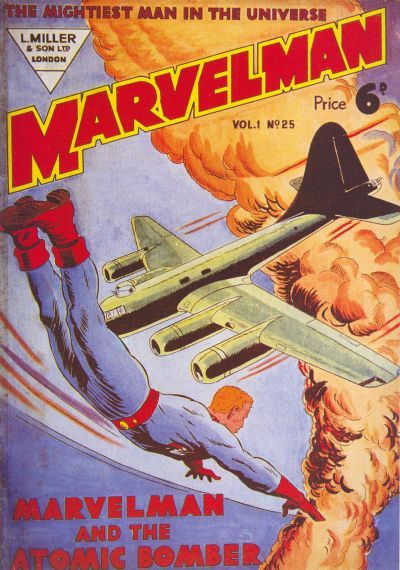 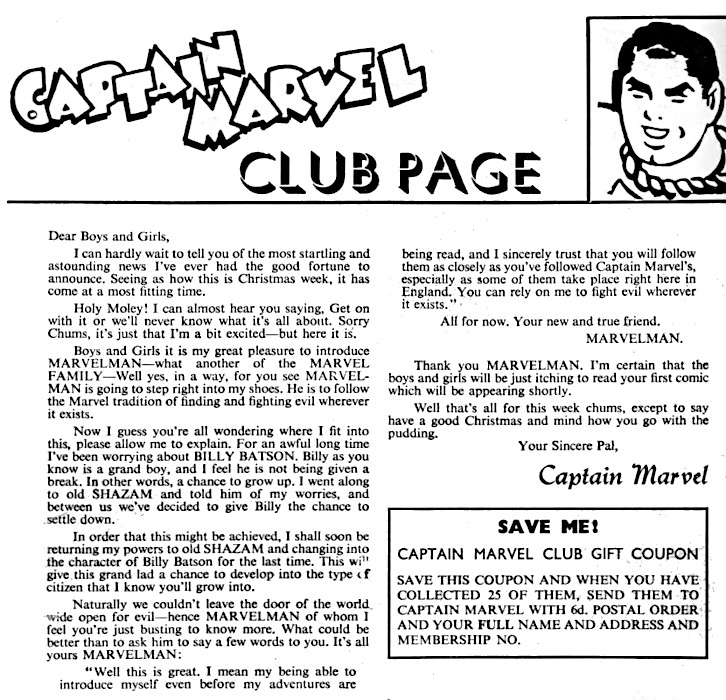 Title/issues:
Marvelman#25-370 (3rd February
1954-February 1963); Marvelman Annual 1964-1960; Marvelman
Adventures (annuals) 1961, 1963; Marvelman Magic#1-3 (1954) Title/issues:
Marvelman#25-370 (3rd February
1954-February 1963); Marvelman Annual 1964-1960; Marvelman
Adventures (annuals) 1961, 1963; Marvelman Magic#1-3 (1954)
Where: U.K.
Featuring: Marvelman
616?: No.
Summary: To follow.
Reprinted in U.S.?: A very small percentage.
Comments: L. Miller and Son had been reprinting Fawcett's
Captain Marvel since 1944, and the hero's line of comics had been
consistently good sellers for them, so the decision by Fawcett to
close the line in 1953 thanks to a decline in U.S. sales and the
protracted, expensive lawsuit with National Comics Publications
(a.k.a. DC Comics) over claims Captain Marvel was infringing
Superman's copyright posed a problem for Miller. Unlike Fawcett's
American sales, Miller's U.K. sales remained strong, so they
didn't want to cancel their title, but their supply of new stories
was about to abruptly dry up. Miller handled it the only way they
could - they decided to make their own stories, with a hero who
was similar enough to retain the current readers, but different
enough to hopefully avoid any lawsuits.
L. Miller was Leonard Miller; the Son was Arnold Miller,
who also ran his own separate comic company, Arnold Book Company.
Both companies had previously employed writer/artist Mick Anglo,
for series such as the SF strip Captain Valiant, Ace Malloy of the
Special Squadron, and Space Commander Kerry; notably, Anglo had
also created an early and successful superhero character, Wonderman,
for rival company Paget Publishing. Thus Anglo was an obvious
option to approach to resolve the Captain Marvel drought about to
hit L. Miller and Son. As Anglo later told Dez Skinn (former
Marvel U.K. editor-in-chief and then publishing Marvelman's
revival in Warrior - see below) "One day Leonard Miller phoned and
said he wanted to see me urgently. His supply of the American
material for the Captain Marvel series had suddenly been cut off.
Had I any ideas? ... So I quickly told him I had plenty of ideas,
and for my trouble I received a regular supply of work for the
next six years."
Anglo came up with virtually identical replacement
characters for Captain Marvel and the Marvel Family. Young newsboy
Billy Batson who became the adult hero Captain Marvel by saying
Shazam was replaced by young newsboy Micky Moran who became the
adult hero Marvelman by saying Kimota; Captain Marvel Jr. was
replaced by Young Marvelman; and Mary Marvel by Kid Marvelman,
presumably because it was felt a male hero would appeal more to
their mostly male readership.
With their Captain Marvel title coming out weekly,
the changeover was announced in Captain Marvel#19's Club Page (see
right), and subsequent issues continued to remind the readers of
the forthcoming handover, giving them about six weeks notice of
the change. Captain Marvel#24 was the last issue to feature
Fawcett's hero, and with #25 the comic changed its name to
Marvelman. With usually a couple of Marvelman stories per issue,
Anglo's newly established Gower Street Studios, which used a
stable of artists including future icons Don Lawrence and Ron
Embleton, went on to produce over six hundred tales for the new
hero before his series finally ended in 1963.
|
|
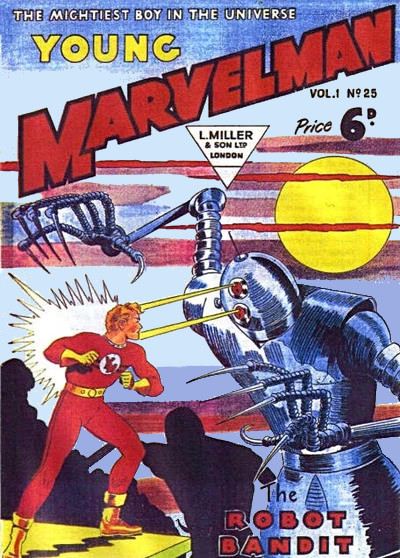 Title/issues:
Young Marvelman#25-370 (3rd February
1954-February 1963); Young Marvelman Annual 1954-1961; Young
Marvelman Adventures (annuals) 1962-1963; Marvelman Jr Annual
1963; Young Marvelman Magic 1-4 (1954) Title/issues:
Young Marvelman#25-370 (3rd February
1954-February 1963); Young Marvelman Annual 1954-1961; Young
Marvelman Adventures (annuals) 1962-1963; Marvelman Jr Annual
1963; Young Marvelman Magic 1-4 (1954)
Where: U.K.
Featuring: Young Marvelman
616?: No.
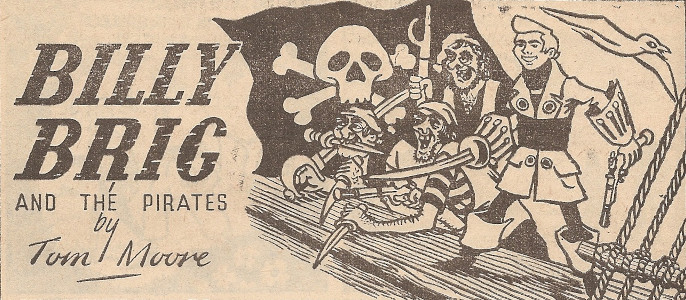 Summary:
To follow Summary:
To follow
Reprinted in U.S.?: No.
Comments: As well as Captain Marvel, L. Miller and Son
were also publishing a Captain Marvel Jr. title. With #25 this
became Young Marvelman. Like the sibling title, each issue tended
to carry multiple stories, usually at least two Young Marvelman
adventures alongside another, unrelated strip - for at least the
first couple of hundred issues this was the swashbuckling tale
Billy Brig and the Pirates by Tom Moore, whose strip began no
later than #43 (the earliest issue I have access to is #44, and
his story was already underway) and finished in #318. Other short
strips came and went, but the only other ongoings that I know of
were Captain Zip Morgan of Space Patrol and space adventurer
Johnny Galaxia, the latter a character originally published in
Spain. Since Marvel bought the rights for Marvelman from Mick
Anglo, rather than the long defunct L. Miller and Son, I'm
assuming Billy Brig was not part of the deal and is not now a
Marvel character.
|
|
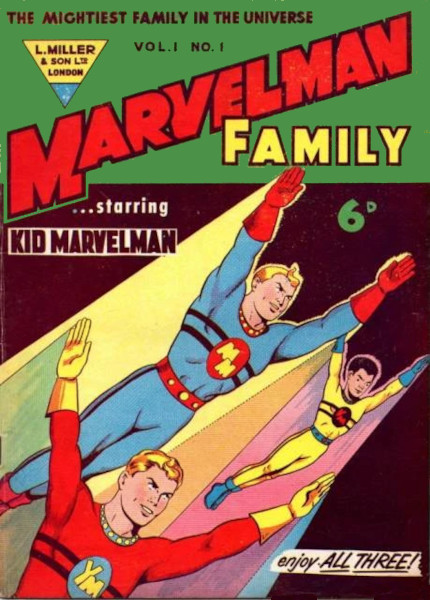 Title/issues:
Marvelman Family#1-30 (October 1956-November
1959), Marvelman Family Annual 1963 Title/issues:
Marvelman Family#1-30 (October 1956-November
1959), Marvelman Family Annual 1963
Where: U.K.
Featuring: Marvelman, Kid Marvelman
616?: No.
Summary: To follow
Reprinted in U.S.?: No.
Comments: The third Marvelman title, and the shortest
lived, lasting only thirty issues, plus an annual in 1963. Unlike
its fellows it was a monthly rather than weekly title.
|
|
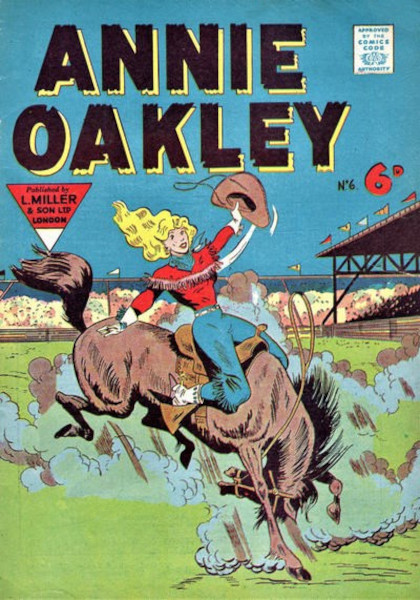 Title/issues:
Annie Oakley#6-8, 11-18 (1957) Title/issues:
Annie Oakley#6-8, 11-18 (1957)
Where: U.K.
Featuring: Annie Oakley
616?: No.
Summary: To follow
Reprinted in U.S.?: No.
Comments: After being given responsibility for providing
content for L.Miller and Son's line of Western titles, Marvelman
creator Mick Anglo had his studio of British and Spanish artists
produce some new Annie Oakley stories to publish alongside the
reprints taken from Atlas Comics' titles. While I can only
personally confirm the final issue, #18, to be one of these,
allegedly several earlier issues also contained new
material.
|
|
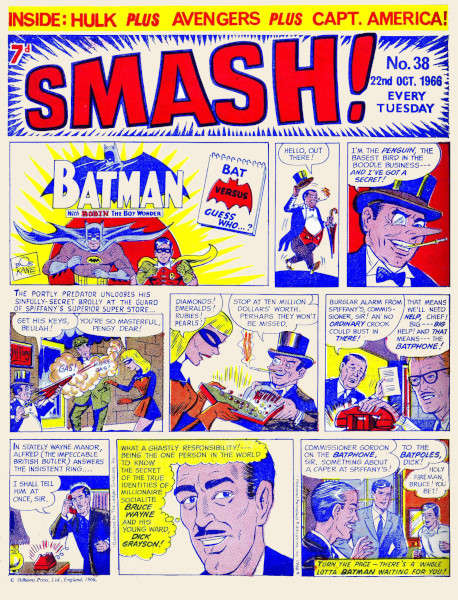 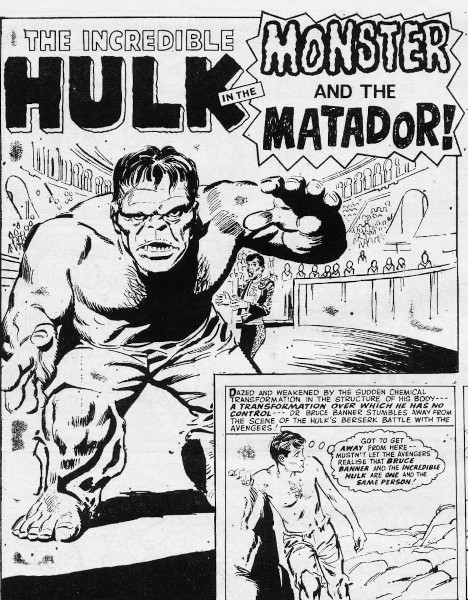 Title/issues:
Smash!#38 (22nd October 1966); see also Smash!
incorporating Fantastic#152 Title/issues:
Smash!#38 (22nd October 1966); see also Smash!
incorporating Fantastic#152
Where: U.K.
616?: Hulk - yes; referenced in Matador's Handbook entry.
Others - no, due to presence of multiple non-Marvel characters.
Featuring: Hulk,
Nick Fury, Spider-Man
Summary: (Smash!#38)
- After fighting alongside Namor against the Avengers, the Hulk
wanders into Spain, where he encounters a villainous matador, El
Supremo.
(Smash! incorporating Fantastic#152) - A large number of Marvel
characters attended the Special Squad Christmas party (see
next entry for comments)
Reprinted in U.S.?: Yes for the Hulk story, in Hulk: From
the Marvel UK Vaults.
Comments: The first U.K. produced strip set in the Marvel
Universe, pre-dating the creation of Marvel U.K. In 1966 Marvel
strips were being licensed for reprint in serial format in titles
owned by Odhams Press. For some reason the Hulk strip in Smash!
was unable to use a reprint story for#38, and so a quick filler
was produced (though the story was produced for a non-Marvel
title, there was a small copyright notice in the comic noting that
the strip belonged to Marvel Comics, not Odhams). Set immediately
after the Hulk and Sub-Mariner's fight with the Avengers in
Avengers I#3, it saw Bruce Banner fleeing that battle. Realizing
he was in Gibraltar, he hid in a truck which crossed into Spain,
which in turn led to him hiding in a pen in the bull fighting
arena in Seville. After humiliating El Supremo, the Hulk departed
Spain, setting off to swim the Atlantic.
There's no credit in the issues, but a discussion of
the strip by a group of former Marvel UK staff (editors, writers
and artists) on a Marvel UK facebook group, also trying to figure
out who drew it, suspected it was Spanish artist Jose Garcia
Pizarro.
|
|
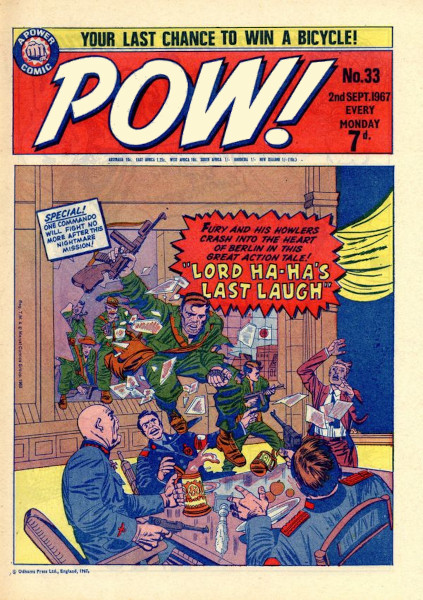 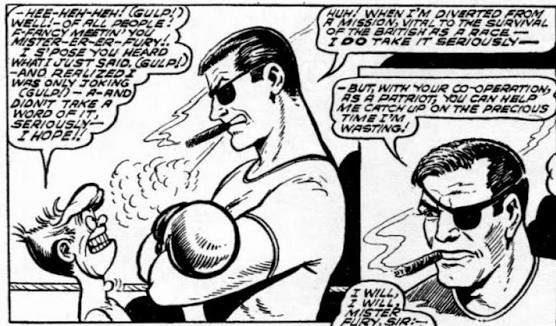 Title/issues: Pow!#33
(2nd September 1967); see also Pow!#21, 50 Title/issues: Pow!#33
(2nd September 1967); see also Pow!#21, 50
Where: U.K.
Featuring: Nick Fury, Spider-Man
616?: No, due to presence of non-Marvel characters.
Summary: (Pow!#21) - Nick Fury visited the Special Squad
HQ.
(Pow!#33) - Nick
Fury was ordered to help young Dare-A-Day Davy complete a
dare, to whit a challenge to last six rounds in a ring with the
spy.
(Pow!#50) - Nick Fury and Spider-Man attended the Pow! staff
Christmas party.
Reprinted in U.S.?: No.
Comments: Odhams' Power Pack titles - Fantastic, Pow!,
Smash!, Terrific! and Wham! - mixed US reprints with non-Marvel UK
material, and adventure strips with comedy ones. And since comedy
strips always had a looser definition of the boundaries between
strips/realities, characters from a given strip could and did
sometimes turn up unexpectedly in other strips, including the
licensed Marvel ones on a handful of occasions. Spider-Man (and
Nick Fury) were both being reprinted in Pow!, so that was the
starting point for their cameos elsewhere. Nick Fury's encounter
with Dare-a-Day-Davy in Davy's single page strip was a full
appearance, but the rest of Nick (and Spider-Man)'s appearances
above are from the strip "The Cloak" by Mike Higgs, whose titular
hero was a superhero-like secret agent working for the "Special
Squad." Nick And Spider-Man were presumably members of this squad,
as they were mostly seen in the background at their headquarters.
I don't have a full run of Pow!, so it's entirely possible that I
might have missed other cameos; if so, they will be added as and
when I learn about them.
The Cloak strip moved to the combined Smash! and
Pow!, and stayed there when Fantastic was also absorbed to create
Smash! incorporating Fantastic. As a result the final cameo for
Marvel characters in the Cloak strip appeared in Smash!
incorporating Fantastic (listed in the prior entry), where they
appear alongside not only cameos of characters Odhams owned or
were licensing, but also many unrelated to the company. It was
near the end of the Cloak's run in Odhams titles, so I can only
guess that Mike Higgs figured he had nothing to lose throwing in
any character he felt like.
|
|
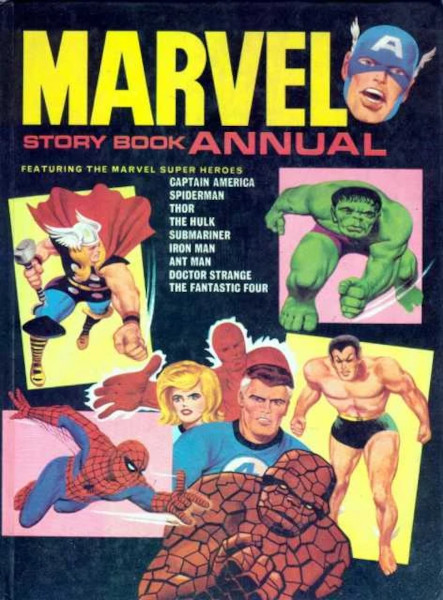 Title/issues:
Marvel Storybook Annual (Autumn 1967) Title/issues:
Marvel Storybook Annual (Autumn 1967)
Where: U.K.
Featuring: Ant-Man, Namor, Fantastic Four, Spider-Man,
Iron Man, Captain America, Doctor Strange, Thor, Hulk
616?: Potentially
Summary: Ant-Man: Fightin' Fury
Sub-Mariner: Howl in the Night
Fantastic Four: The Chains of Abdul Rey
Spider-Man: The Fire Raisers
Iron Man: The Cushioned Clash
Captain America: Tomb of Terror
Iron Man: The Ghost of Ned Kelly
Dr. Strange: Guardians of the Tomb
Fantastic Four: The Bull of Minos
Thor: North Sea Wolf
Dr. Strange: Flight into Danger
Hulk: The End of the Hulk
Reprinted in U.S.?: Only the Hulk story, in Hulk: From the
Marvel UK Vault
Comments: Though Marvel characters had appeared in some
Odhams annuals, the first annual solely devoted to them was the
Marvel Storybook Annual. Published by World Distributors, one of
the companies that specialized in annuals based on licensed
products, the Marvel Storybook Annual carried a dozen text stories
written by Douglas Enefer, A. Tyson and John W. Elliott and
illustrated by M.K. Powell, J. Leeder and P. Limbert. The next two
years World Distributors released the Marvel Comics Annual, but in
these two instance, and indeed most subsequent Marvel-related
annuals until the late 1970s, the interiors only contained
reprints of American Marvel strips.
For anyone interested in the U.K.'s Marvel related
annuals, including the ones that were purely reprints, complete
cover galleries can be found at the excellent Tony's
Trading. In fact, you can find the covers of the vast majority of
U.K. annuals of any description on that site.
|
|
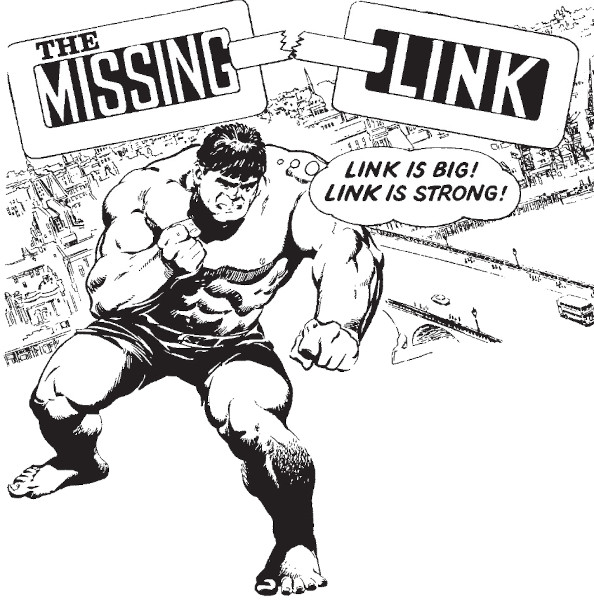 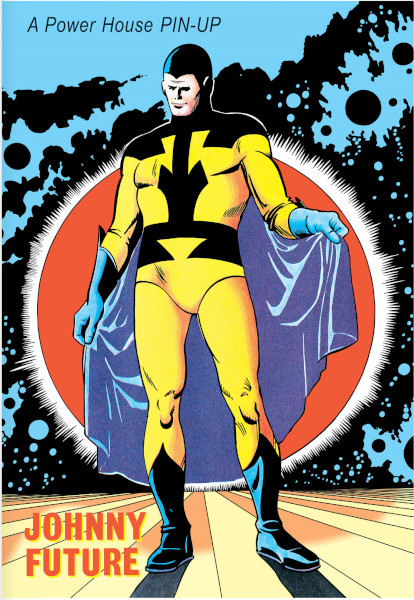 A
quick note: At launch Odhams' Fantastic had the highest
percentage of of Marvel reprints of any of the Power Pack, with
Thor, the X-Men and Iron Man taking up three quarters of the
title. The final story was the Missing
Link, a character who was virtually a clone
of the Hulk in both appearance and mannerisms. So much so
that after only eight issues the Link got exposed to radiation and
mutated into a normal looking human with superpowers, reinventing
himself and his strip as Johnny Future. Meanwhile, starting from
the second issue, the back page of the comic began displaying "A
Power House Pin-Up" featuring different Marvel characters. The
only non-Marvel character to be featured was the aforementioned
Johnny Future. So with this in mind, it's not surprising that some
people mistakenly believed Johnny Future to be another Marvel
character, and though the misconception is far less common now
than it was in the early days of the internet, some sites
erroneously list (or used to list) his tales as new Marvel
universe material originating in Britain. That's not the case. He
was Odhams' property, and with Odhams being subsequently bought
out his ownership has shifted a few times over the intervening
decades and is currently held by Rebellion, the publishers of
2000A.D., who recently released a collected volume of Johnny
Future's tales. A
quick note: At launch Odhams' Fantastic had the highest
percentage of of Marvel reprints of any of the Power Pack, with
Thor, the X-Men and Iron Man taking up three quarters of the
title. The final story was the Missing
Link, a character who was virtually a clone
of the Hulk in both appearance and mannerisms. So much so
that after only eight issues the Link got exposed to radiation and
mutated into a normal looking human with superpowers, reinventing
himself and his strip as Johnny Future. Meanwhile, starting from
the second issue, the back page of the comic began displaying "A
Power House Pin-Up" featuring different Marvel characters. The
only non-Marvel character to be featured was the aforementioned
Johnny Future. So with this in mind, it's not surprising that some
people mistakenly believed Johnny Future to be another Marvel
character, and though the misconception is far less common now
than it was in the early days of the internet, some sites
erroneously list (or used to list) his tales as new Marvel
universe material originating in Britain. That's not the case. He
was Odhams' property, and with Odhams being subsequently bought
out his ownership has shifted a few times over the intervening
decades and is currently held by Rebellion, the publishers of
2000A.D., who recently released a collected volume of Johnny
Future's tales.
|
|
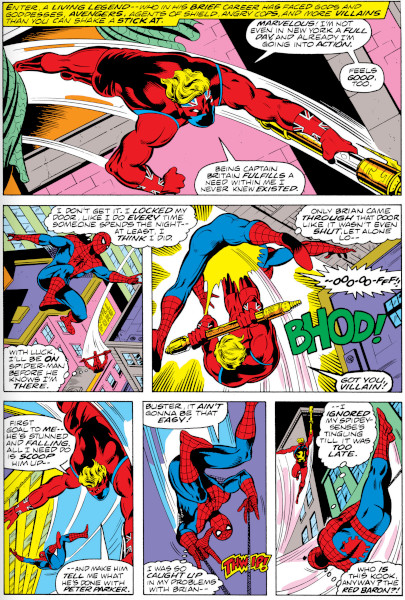 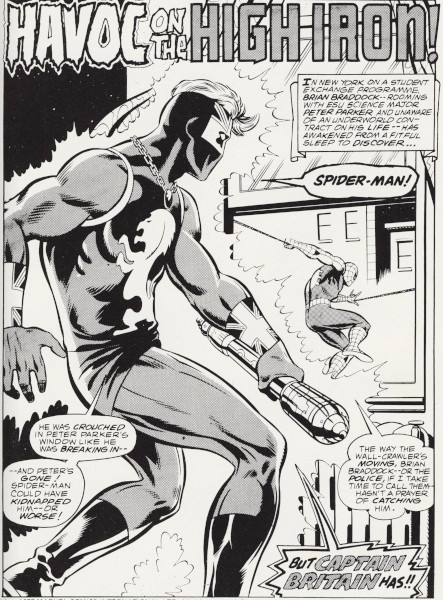 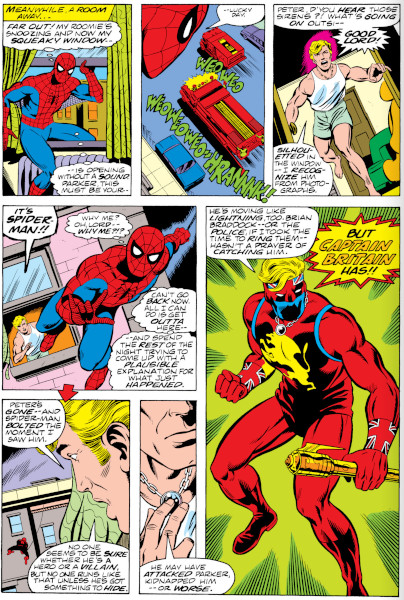 With the arrival of Marvel U.K. in 1972 far more
of Marvel's output began to be reprinted in Britain. Although the
Marvel universe (not counting the pre-FF Timely and Atlas era
material) had a ten year head start on the British titles
reprinting them, the weekly schedules of the British anthologies
still meant that it wouldn't be long before some titles would
begin to run short of available reprint materials, the same
problem that had prompted so many other overseas publishers to
begin producing their own stories. With the arrival of Marvel U.K. in 1972 far more
of Marvel's output began to be reprinted in Britain. Although the
Marvel universe (not counting the pre-FF Timely and Atlas era
material) had a ten year head start on the British titles
reprinting them, the weekly schedules of the British anthologies
still meant that it wouldn't be long before some titles would
begin to run short of available reprint materials, the same
problem that had prompted so many other overseas publishers to
begin producing their own stories.
Since an average American issue would be split
across three to four U.K. issues, the "middle" sections often
needed new chapter titles and splash pages to introduce the latest
installment - see for example the page to the right from Super
Spider-Man and Captain Britain#249, intended to slot between the
two color pages from Marvel Team-Up#65.
|
|
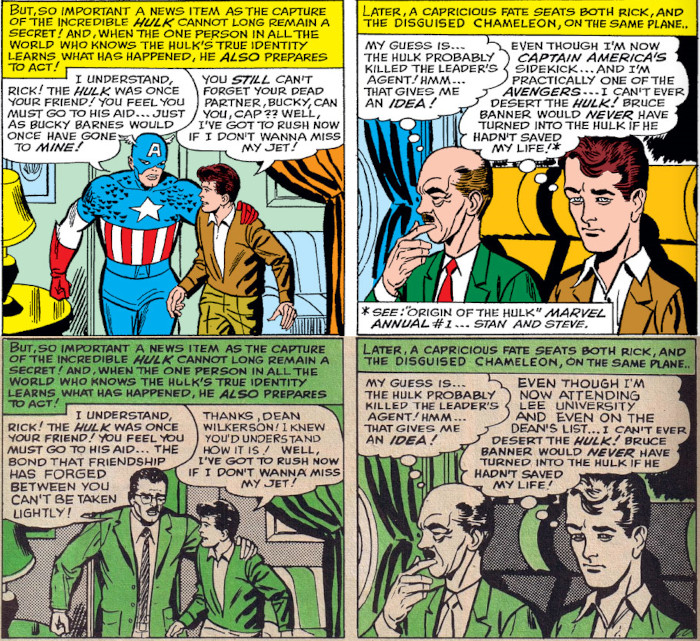  On other occasions changes were made to
avoid confusing the U.K. audience. For example, when Mighty World
of Marvel#15 reprinted the Hulk story from Tales
to Astonish I#62, Marvel U.K. had not yet reprinted the
Avengers stories where the Hulk's pal Rick Jones left the Hulk's
side to become Captain America's sidekick. Thus a panel where Rick
tells a supportive Captain America of his need to take a break in
order to rush to the aid of the Hulk was deemed potentially
confusing to readers who might not even know who Captain America
was. Thus instead of having a costumed character the readers might
not recognize and references to Rick having joined a team that
readers might not have heard of, the editors decided to suggest
Rick had left the Hulk's side to attend college, a much more
mundane scenario that could be explained to readers in minimal
time. On other occasions changes were made to
avoid confusing the U.K. audience. For example, when Mighty World
of Marvel#15 reprinted the Hulk story from Tales
to Astonish I#62, Marvel U.K. had not yet reprinted the
Avengers stories where the Hulk's pal Rick Jones left the Hulk's
side to become Captain America's sidekick. Thus a panel where Rick
tells a supportive Captain America of his need to take a break in
order to rush to the aid of the Hulk was deemed potentially
confusing to readers who might not even know who Captain America
was. Thus instead of having a costumed character the readers might
not recognize and references to Rick having joined a team that
readers might not have heard of, the editors decided to suggest
Rick had left the Hulk's side to attend college, a much more
mundane scenario that could be explained to readers in minimal
time.
Other changes were made to accommodate perceived
differences between British and American sensibilities, most
notably what was considered overly jingoistic references to "Reds"
and the "Iron Curtain." Thus references to same were modified to
mention a fictional nation, Bodavia, and Hammer and Sickles were
swapped out for more generic lightning bolt emblems. Bodavia which
would eventually be namechecked in the U.S. comics in Marvel
Premiere#49 (1979).
|
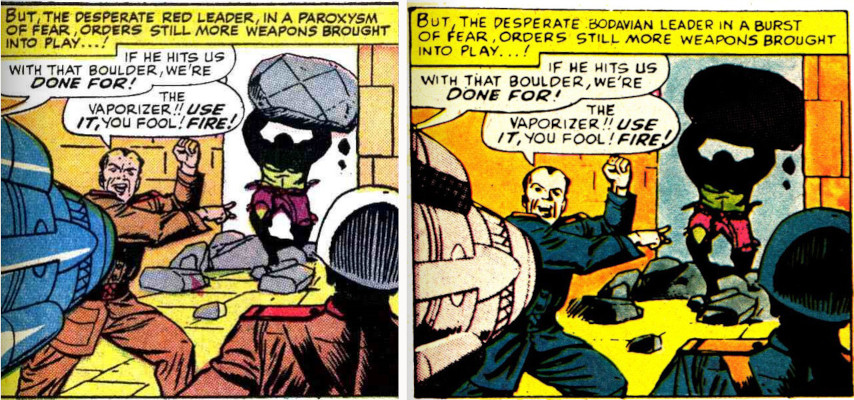
|
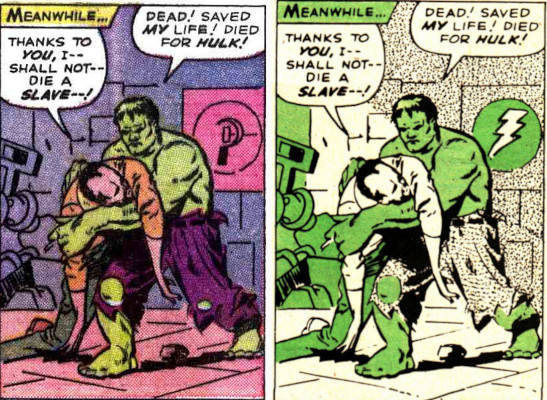
|
Note that below I only intend to discuss titles that contained original
content that was not licensed - in other words, I'm leaving out purely
reprint titles and comics that had original content but only for licensed
properties (e.g Blake's 7). If you want to check out a complete list (of
ongoing titles, if not one shots), then check out the excellent Rusty
Staples Marvel U.K. timeline.
|
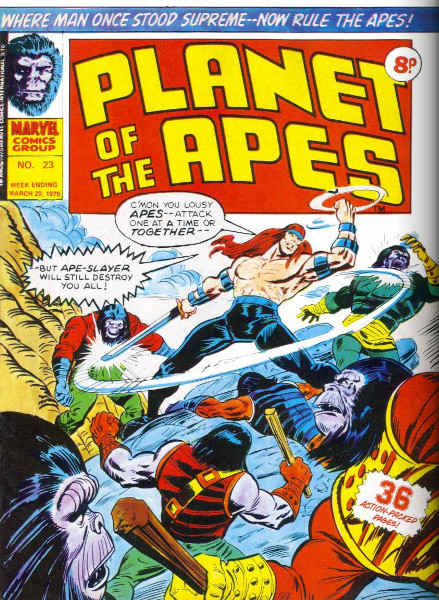 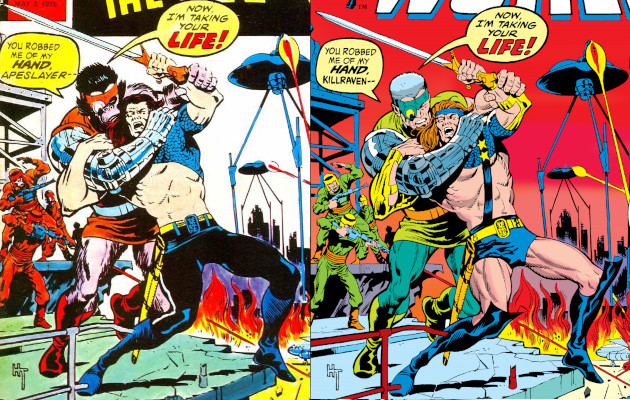 Title/issues: Planet
of the Apes#23-30 (29th March-17th May 1975) Title/issues: Planet
of the Apes#23-30 (29th March-17th May 1975)
Where: U.K.
Featuring: Apeslayer
616?: No. Set on Earth-7481.
Summary: To follow
Reprinted in U.S.?: No
Comments: One of the first titles to run short on
available reprint material was Planet of the Apes. Series such as
Avengers, Hulk and Spider-Man had a decade's worth of catalogue to
burn through; Savage Sword of Conan could stave off problems
because they were drawing their material from two American titles;
and any series that was not in the title of the U.K. comic they
were being reprinted in could simply be put on hiatus. However,
Planet of the Apes was drawing from an American title only a few
months older than the U.K. reprint, so it was only a matter of
time before the well ran dry. The solution was a novel one.
Figuring it would be easier to modify an existing story than make
a new one, the title's U.S. editor Marv Wolfman decided to convert
an entirely different series into a Planet of the Apes story,
something he later explained in an interview published in Back
Issue#121 (see below). Thus the warrior Killraven's battle against
the Martian invaders from Amazing Adventures became the warrior Apeslayer's
battle against the Ape dictators. 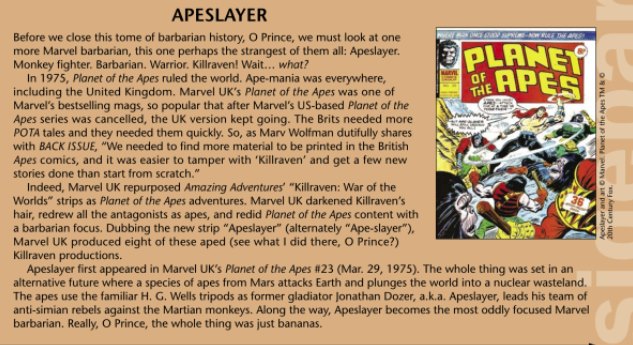
|
|
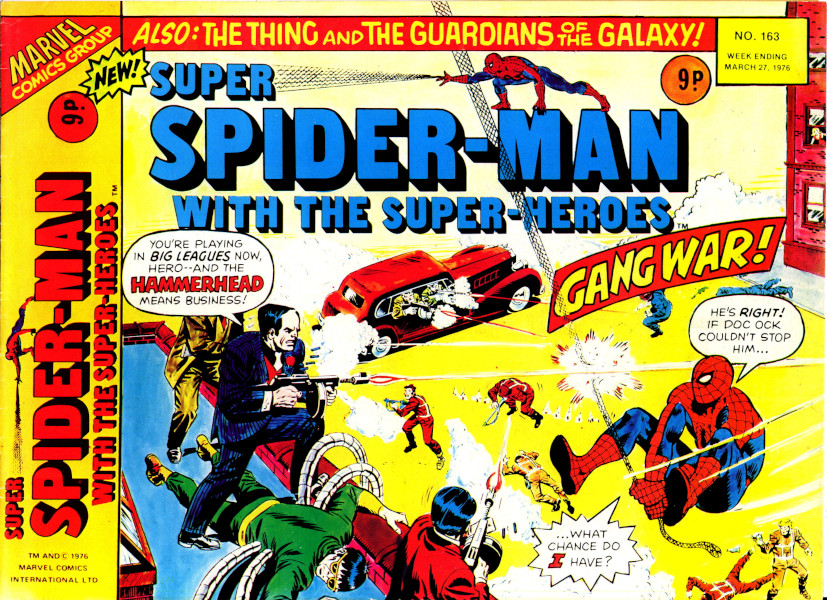 Title/issues:
Super Spider-Man with the Superheroes#163
(22nd March 1976) Title/issues:
Super Spider-Man with the Superheroes#163
(22nd March 1976)
Where: U.K.
Featuring: Spider-Man, Thing
616?: No. Set on Earth-59462
Summary: When aliens invade London, Spider-Man, the Thing
and Hulk come to the rescue.
Reprinted in U.S.?: No
Comments: On 25th October 1975 Marvel U.K. began an
experiment with the launch of a new title, The Titans. The content
wasn't particularly unusual - reprints of the Inhumans, Captain
America, Nick Fury Agent of SHIELD, Sub-Mariner and Captain
Marvel, but the layout was, as unlike every other Marvel U.K.
title, and indeed pretty much every other comic on the market, it
was published in a landscape format. A few months later, on 21st
February 1976, Spider-Man Comics Weekly made the first of many
name changes when it merged with The Super-Heroes to become Super
Spider-Man with the Super-Heroes; bizarrely, given that both
pre-merger comics had been the more common portrait format, the
new merged version was also landscape, and would remain so from
SSMwtSH#158 (21st February 1976) through a merger with The Titans
to become Super Spider-Man and the Titans from #199, until #228.
From #229 SSM&tT reverted to portrait format, just two issues
before merging with Captain Britain (see below).
One consequence of the unusual landscape format was
that the reprinted art needed amending more frequently than it
otherwise might have done. Another was the inclusion of posters in
some center spreads. Most were simply art of a given character,
but two stood out because they together told
a brief story of alien invasion and the space war that followed.
Both were written and drawn by Frank Hampson, best known for being
the artist who created Dan Dare, the space-faring star of The
Eagle comic, each respectively among the most influential
characters and titles in British comics history, and they marked,
afaik, the only time Hampson worked for Marvel.
|
|
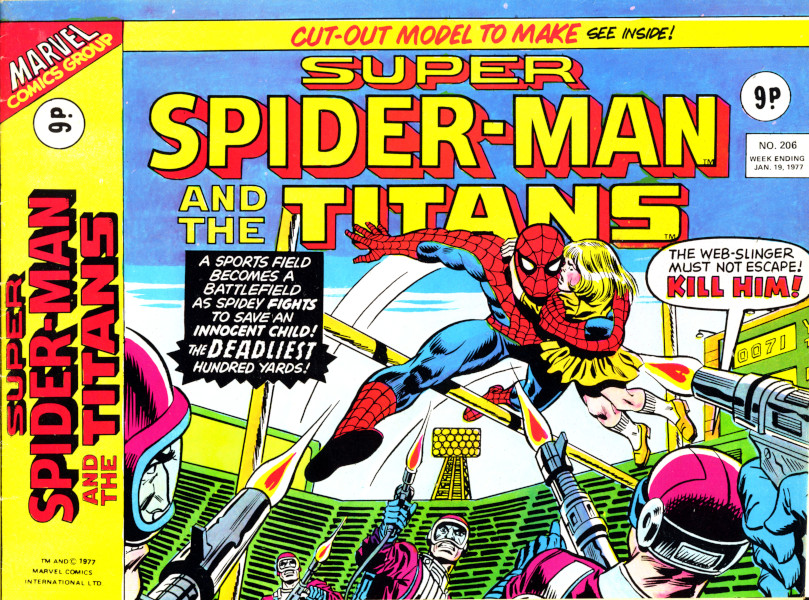 Title/issues:
Super Spider-Man with the Titans#206 (19th
January 1977) Title/issues:
Super Spider-Man with the Titans#206 (19th
January 1977)
Where: U.K.
Featuring: Terran Commando Sergeant Superdare
616?: No, set in Reality-59462
Summary: After the alien invaders were repelled back into
space, the SolPlanet League's forces drove them back out of the
solar system.
Reprinted in U.S.?: No
Comments: The second part of the brief story produced by
Frank Hampson.
|
|
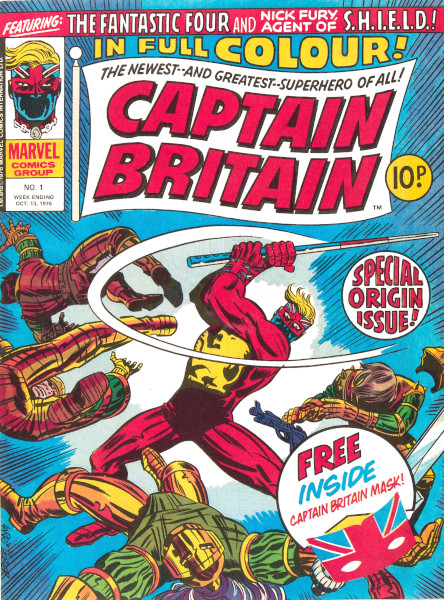 Title/issues:
Captain Britain I#1-39 (13th October
1976-6th July 1977) Title/issues:
Captain Britain I#1-39 (13th October
1976-6th July 1977)
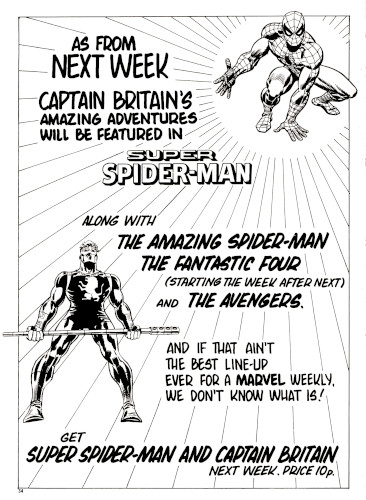 Where:
U.K. Where:
U.K.
Featuring: Captain Britain
616?: Yes.
Summary: To follow
Reprinted in U.S.?: Yes, numerous times.
Comments: Marvel U.K.'s first venture into an actual full
new story began with Captain Britain#1, although it's debatable
whether it really counts as "stories produced in the U.K." since
the creative team was entirely American. Strictly speaking the
initial writer, Chris Claremont, is English, since he was born in
London, but he moved to America when he was three, while I believe
original artist Herb Trimpe was chosen because he'd once visited
the U.K. That's not to denigrate the groundwork they laid, as they
told some excellent stories, but there was definitely an
American-undertone to the depiction of Britain. To begin with
Captain Britain's strip was mostly in color, an uncommon feature
in British titles, but with Captain Britain#24 the strip abruptly
shifted to black and white, and just four months later the title
came to an end with #39, which carried an announcement that the
title was going to be merged with Super Spider-Man "just to see if
you're paying attention."
|
|
On a separate note, the final issue of Captain Britain also
included this response to a reader's letter:
To which I can only say "Time will
make fools of us all." See right.
The 1981 special (furthest right) is
just a reprint of Captain Britain's encounter with Spider-Man from
Marvel Team-Up, but the 1980 one has some new content that we'll
come back to later.
|
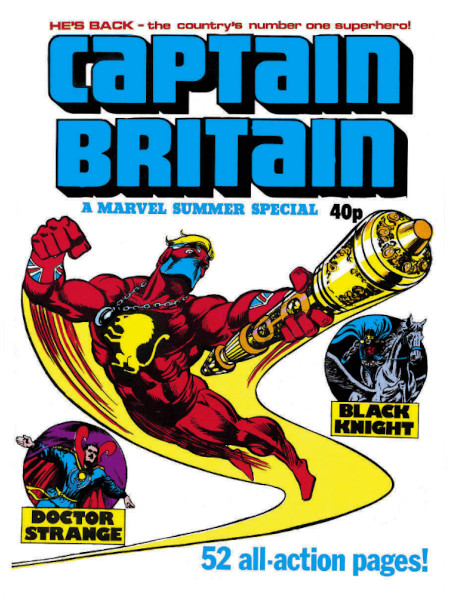 |
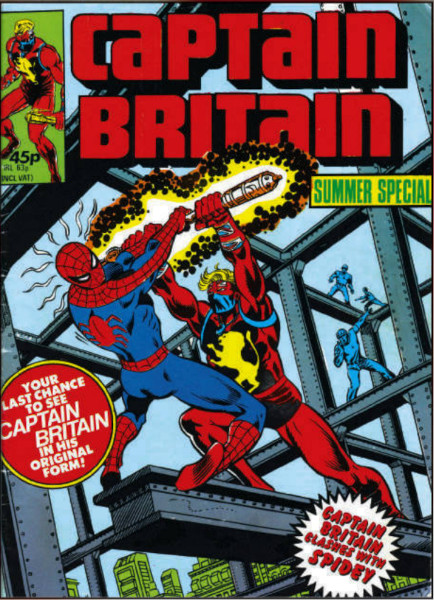 |
|
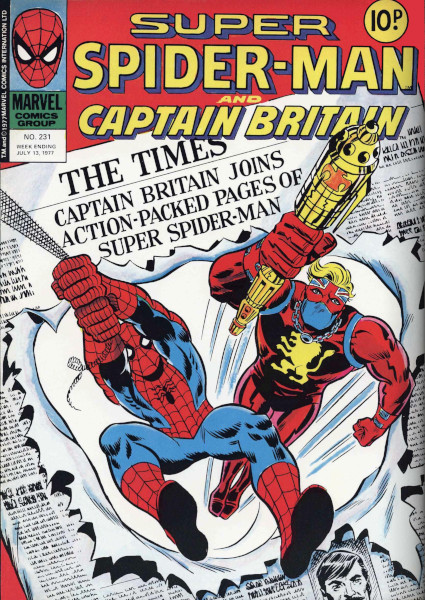 Title/issues:
Super Spider-Man and Captain
Britain#231-247 (13th July-2nd November 1977) Title/issues:
Super Spider-Man and Captain
Britain#231-247 (13th July-2nd November 1977)
Where: U.K.
Featuring: Captain Britain
616?: Yes
Summary: To follow
Reprinted in U.S.?: Yes
Comments: With the cancellation of Captain Britain, the
title merged with Marvel U.K.'s Spider-Man title, ousting the last
victim similarly absorbed, The Titans, to take second billing on
the cover. For the next seventeen issues Britain's own hero
continued to enjoy new adventures, then Super Spider-Man and
Captain Britain#248-253 published the team-up between Spider-Man
and Captain Britain that also appeared in Marvel Team-Up I#65-66;
I say published rather than reprinted because while I believe MTU
came out first, it's a very close call. MTU#65 was cover dated
January 1978, but American comics are cover dated a few months
ahead to help prolong shelf-life, while U.K. weeklies are cover
dated up to six days ahead for the same reason; it's hard to find
data pinning down with certainty the exact day MTU#65 came out,
but using the dates for later issues of that title provided in
early issues of Marvel Age, titles cover dated January actually
hit the shelves in the last week of September or the first three
of October; if the dates remained consistent over the years, MTU
tended to be on sale the Tuesday of the third week of any given
month (including any partial weeks in that count), which would
make the release date of MTU#65 the 18th October 1977 and MTU#66
the 15th November 1977. Meanwhile Super Spider-Man and Captain
Britain#248 was cover dated November 9th 1977, which means it
probably hit shelves on the 5th (the Saturday of that week, a
common U.K. release date), while #251 (which reprinted the first
part of MTU#66) would have been on sale 26th November. Not much of
a gap between them!
The crossover story between Captain Britain and
Spider-Man had replaced Captain Britain's solo outing but not
Spidey, who still enjoyed his solo adventure elsewhere in the
issue. With the end of the crossover Captain Britain was
unceremoniously dropped from the title. The letters page of
SSM&CB#253 consisted of two letters bemoaning what they
perceived as the British hero's poor treatment in the comic of
late, and got semi-placatory editorial responses that failed to
mention the character was about to vanish, while the end of the
actual story included a note that Captain Britain was going on
"holiday" and would be replaced from next week by Captain America.
The next issue was titled simply Super Spider-Man, making it clear
that Captain Britain wouldn't be back...at least not in the pages
of Spidey's title.
|
|
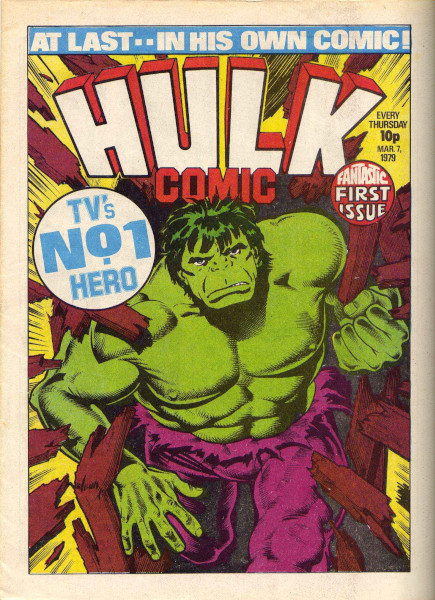 Title/issues:
Hulk Comic#1-46; Incredible Hulk Weekly#47-55,
57-63 (7th March 1979-15th May 1980) Title/issues:
Hulk Comic#1-46; Incredible Hulk Weekly#47-55,
57-63 (7th March 1979-15th May 1980)
Where: U.K.
Featuring:
- Ant-Man: #48-49
- Black Knight (and Captain Britain): #1, 3-30, 31-41 (reprints
of Captain Britain and Black Knight's origins, but with small
amounts of new information added), 42-55, 57-63
- Hulk: #1-6, 9-20, 26-28
- Nick Fury, Agent of S.H.I.E.L.D.: #1-19
- Night Raven: #1-20
616?: Yes - all bar Ant-Man have been referred back to in
Handbook entries and subsequent stories, and Ant-Man hasn't only
because it was too minor an incident to warrant mention in the
limited space available for his entry.
Summary: To follow
Reprinted in U.S.?:
- Black Knight/Captain Britain Otherworld saga - yes, multiple
times
- Hulk - yes, in Hulk: From the Marvel UK Vaults
- Night Raven - yes, in the Night Raven Graphic Novel (not to be
confused with Night Raven: House of Cards, listed below), and in
Night Raven: From the Marvel U.K. Vaults
- Nick Fury and Ant-Man stories - no.
Comments: By 1978 Marvel U.K.'s sales were in decline, so
while on a visit to the U.K. Stan Lee headhunted Dez Skinn, a
former editor at IPC (International Publishing Corporation, one of
the U.K.'s two largest comic publishers) who was then running
Williams Publishing's comics section as well as self-publishing
the successful SF news monthly Starburst. Taking over Marvel U.K.
in August 1978, Skinn set about revamping Marvel U.K.'s titles to
make them more competitive against their home-grown British
rivals. One change was to speed up the pace of the stories - while
a U.S. comic might have twenty pages per issue, the U.K. ones
might only have three to five pages, and still needed to ensure
that each episode moved the tale forward while being compelling in
its own right. For some U.S. stories simply cutting them into
three to five page segments didn't produce the required effect, so
U.S. panels began to be resized and repositioned to fit more
panels per page (see below).
With the Hulk TV show was very popular in Britain,
the decision was taken to launch the character in his own title,
with new stories deliberately designed to feel more akin to the TV
version than the U.S. comic version. Since U.K. titles tended to
lean towards a mix of story types, and superheroes had never been
the strongest sellers there, Skinn decided to fill the title with
characters who could fit tales leaning towards other genres, and
where possible/necessary produce new home-grown stories that would
better fit these genres and a British audience's sensibilities.
Thus the first issue of Hulk Comic included brand new Nick Fury
tales playing up the spy thriller motif, new Black Knight series
that leaned heavily into British mythology and fantasy, as well as
bringing back Captain Britain from the "holiday" he'd gone on
after his last appearance, and noir crime-thriller Night Raven,
whose titular star was a brand new character cut from the same
cloth as Pulps era icons such as the Spider or Shadow. The only
actual reprint in the first issue was the origin story of Ant-Man,
who for early issues would remain the titles' only out and out
superhero strip.
Sales were good, but costs were also obviously
higher for a title with more original material and fewer reprints,
and very quickly the percentage of reprint to new story began to
rise, until only Black Knight remained - and even that took a
hiatus for #31-41 to be replaced by reprints of the origins of
Black Knight and Captain Britain, albeit with amendments and
additions to reveal heretofore undisclosed ties between their
origins and the current story. Nevertheless, Hulk Comic was a
groundbreaking change for Marvel U.K., paving the way for Marvel
U.K. to become a major producer of new tales.
Below: A comparison between Hulk Comic#4's opening of The
Eternals, and the U.S. comic it came from, compressing nine and a
third pages of U.S. material into three U.K. pages.
|
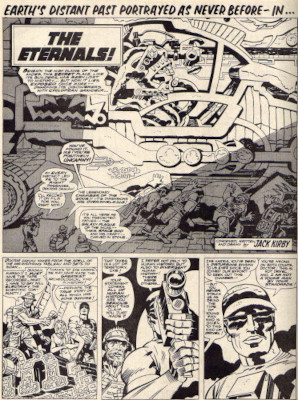 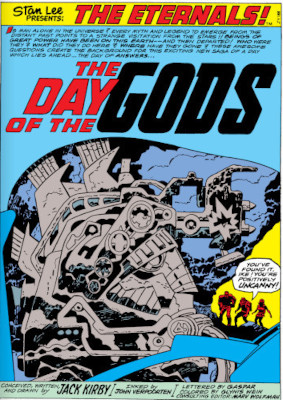 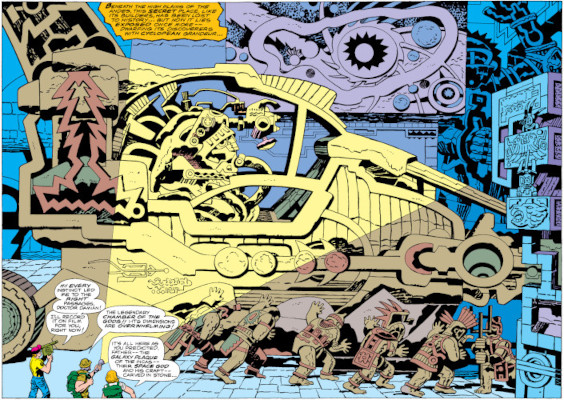 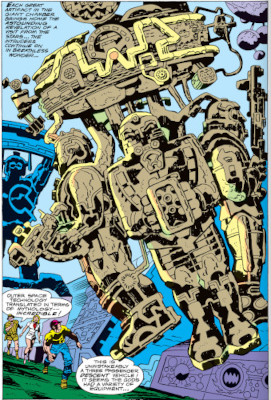 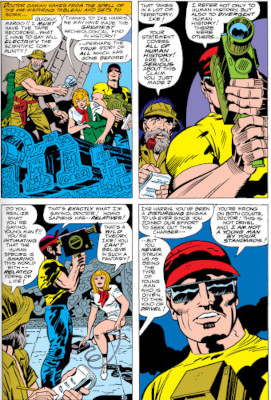 |
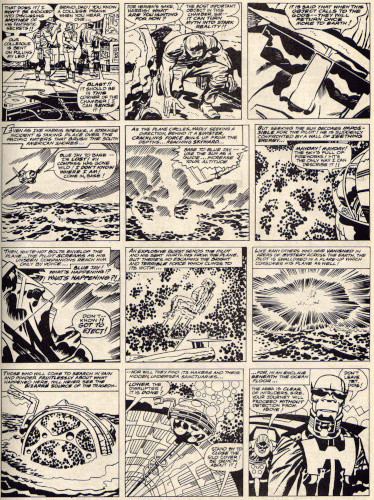 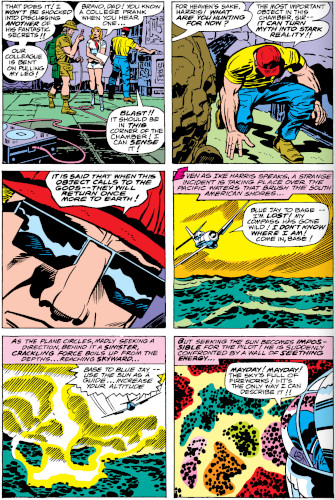  |
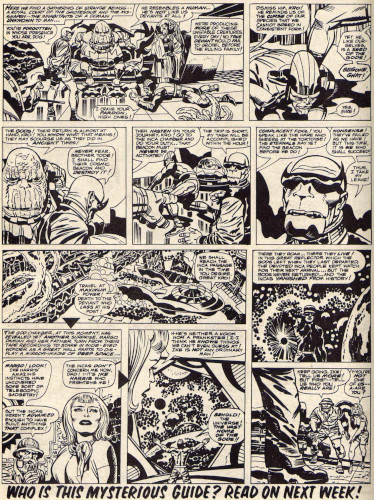 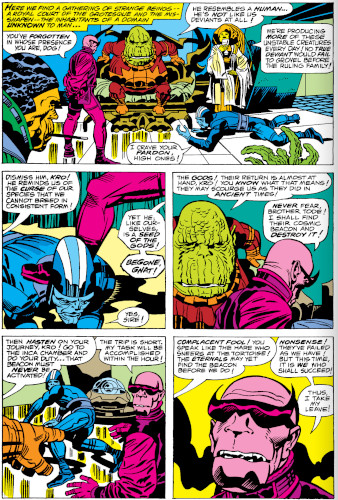 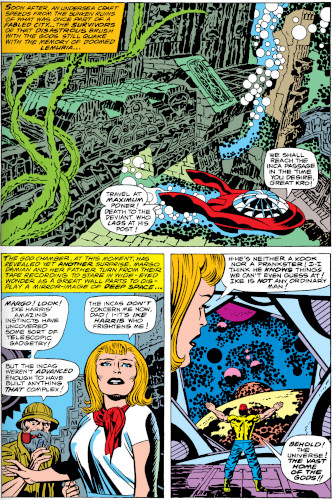 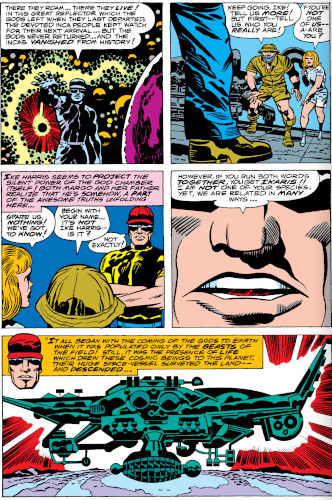 |
|
|
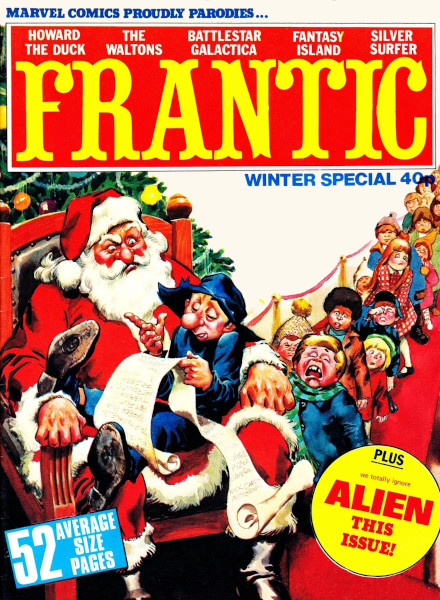 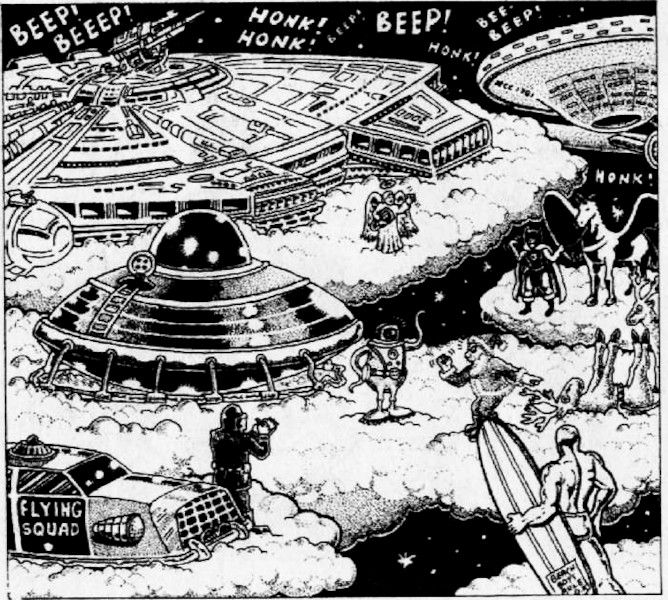 Title/issues:
Frantic Winter Special (1979) Title/issues:
Frantic Winter Special (1979)
Where: U.K.
Featuring: Santa Claus
616?: Potentially
Summary: To follow
Reprinted in U.S.?: No.
Comments: The Frantic Winter Special featured a one-shot,
two page strip called "Santa's Christmas Chaos," written AND drawn
by Alan Moore under his pen name Curt Vile, covering Santa Claus'
misadventures on Christmas Eve. The story was told entirely in
pictures, with no dialogue, and, as the panel to the right shows,
included cameos from the Black Knight, Silver Surfer, Millennium
Falcon and Federation starship Enterprise.
|
|
 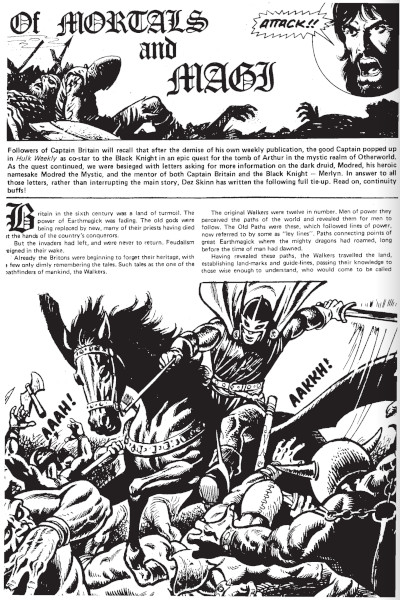 Title/issues:
Captain Britain Summer Special (1980) Title/issues:
Captain Britain Summer Special (1980)
Where: U.K.
Featuring: Captain Britain, Black Knight
616?: Yes.
Summary: To follow
Reprinted in U.S.?: Yes, in the 2021 Captain Britain
Omnibus.
Comments: The 1980 Captain Britain Summer Special,
released just after he had completed his appearances in Hulk
Comic's Otherworld Saga, reprinted the Lord Hawk story from
Captain Britain's weekly, a 1950s Black Knight tale, and a modern
era Black Knight story from Doctor Strange#178. What made it
noteworthy here however were two articles providing background for
the recent Otherworld Saga, one ("Of Legends, Dreams and
Otherworld") discussing the real world development of the tale and
the other ("Of Mortals and Magi") providing an in-universe summary
of the backgrounds of major characters. Though neither fits this
page's remit exactly as they are not new stories, I nevertheless
feel they are worthy of mention.
|
|
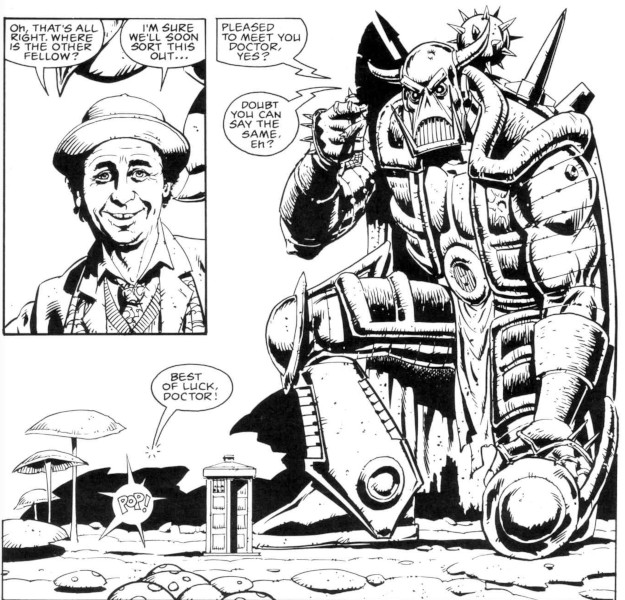 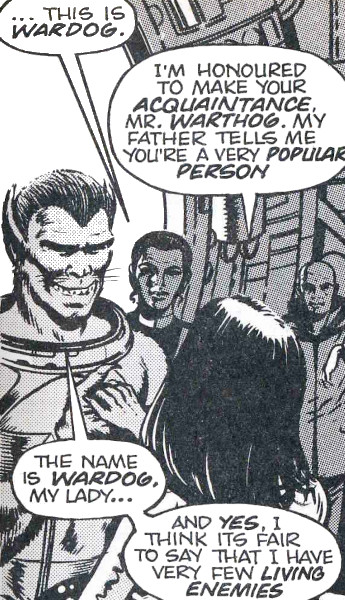 Title/issues:
Doctor Who Monthly#47, 51, 60, 62-67; Doctor
Who Magazine#135, 140-142, 173, 262, 292, 500 (December 1980-July
2016) Title/issues:
Doctor Who Monthly#47, 51, 60, 62-67; Doctor
Who Magazine#135, 140-142, 173, 262, 292, 500 (December 1980-July
2016)
Where: U.K.
Featuring:
- CYRIL: #99, 207, Summer Special 1989
- Death's Head: #135, 173
- Dogbolter and Hob: #86-89, 250, 500
- Earth-33 1/3 (in Doctor Who?): #64
- Gwanzulum:
#141-142
- Hulk: #173
- Keepsake: #140
- Merlin: #60, 62-63, 65-67, 262
- Special Executive: #51, 67
- Sleeze Brothers: #147
- Spider-Man: #292
616?: No, but many characters above might either be the
616 versions or have visited there.
Summary: To follow
Reprinted in U.S.?: Yes
Comments: Another of Dez Skinn's achievements while in
charge of Marvel U.K. was securing the license to publish a Doctor
Who comic. The long-running SF TV series had been featured in
comic form since 1964, only a year after the show began airing,
but this was the first time the character had headlined his own
title. Though every issue carried new, U.K. produced stories, I
intend here (as with other licensed titles) to only discuss those
that are linked to the wider Marvel multiverse - i.e. they feature
characters who either originated in, or went on to visit, more
Marvel-specific realities.
Initially weekly, the title carried three comic
strips to begin with - the lead one featuring the titular Time
Lord, a back of issue strip showcasing other characters, usually a
villainous alien race, from the TV show, and a third strip, Tales
from the TARDIS, lifted from Marvel Classic Comics' adaptations of
classic SF novels; to make these last fit the comic's remit, a
framing device was added with the Doctor introducing each chapter.
From Doctor Who Weekly#30 the third strip became "Doctor Who's
Time Tales," using time-related shorts from Marvel U.S anthologies
such as Journey into Mystery, Strange Tales and Chamber of Chills.
Again, the Doctor was added as the narrator introducing the tale,
in one instance (see below) replacing the original "horror host,"
Digger.
The forthcoming switch to Doctor Who Monthly as of #44 meant #43
was to be the last of these narrated tales.
The next few links to the Marvel universe came in
the form of characters who would later show up in other Marvel
stories. Written by Alan Moore, Doctor Who Monthly#47's back-up
strip featured the Doctor's own people, the Time Lords of
Gallifrey, and though no Marvel-related characters appeared, it
was the first part of a trilogy of tales about a time war between
the Gallifreyans and the Order of the Black Sun, with the latter
two parts (in #51 and 57) introducing Wardog and the Special
Executive respectively, characters who would return in Moore's
Captain Britain run. Similarly, Merlin encountered the Doctor in
Doctor Who Monthly#60, and would later be confirmed to be the same
individual who empowered Captain Britain. Characters belonging to
the "Whoniverse" who would later cross into other Marvel titles
include villainous businessfrog Josiah Dogbolter and his robot
assistant Hob, and space pilot Keepsake. CYRIL, the star of a
strip in Marvel U.K.'s Star Wars comic (see below) made cameos in
a couple of stories drawn by John Ridgeway, the same artist who
drew his strip. The alien Gwanzulum who menaced the Doctor would
also battle a number of other licensed characters published by
Marvel U.K. (see below), as well as Marvel universe resident
Combat Colin. However, the closest Marvel ties are Spider-Man's
cameo appearance in Doctor Who Magazine#292, seen when the Doctor
is shown a kaleidoscopic image of the multiverse, Marvel heroes
turning up in the Doctor Who? comedy strips in #64 and 191, and
the Doctor's encounter with Death's Head, which served as the
mechanoid's transition from the Transformers universe to the wider
Marvel multiverse.
|
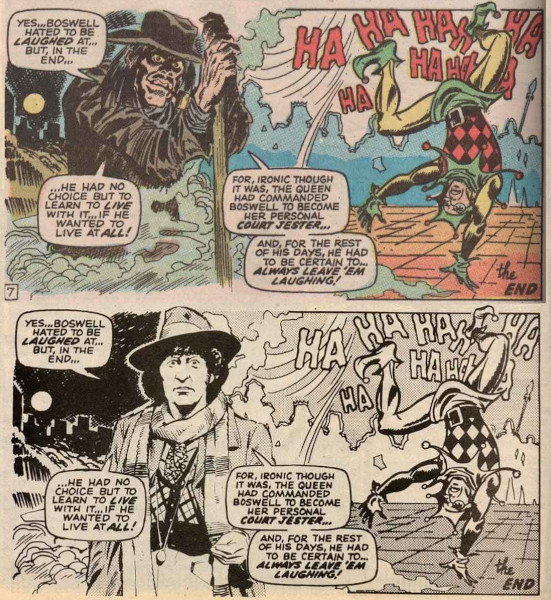
|
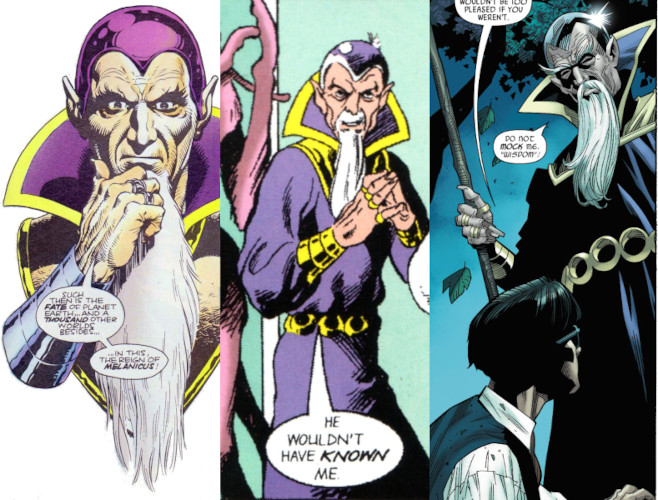
Merlin the Wise in Doctor Who Monthly, Captain Britain's strip
in The Daredevils#1, and Captain Britain & MI13#3
|
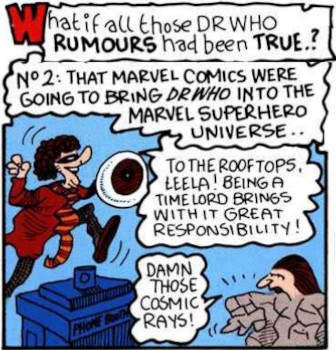
|
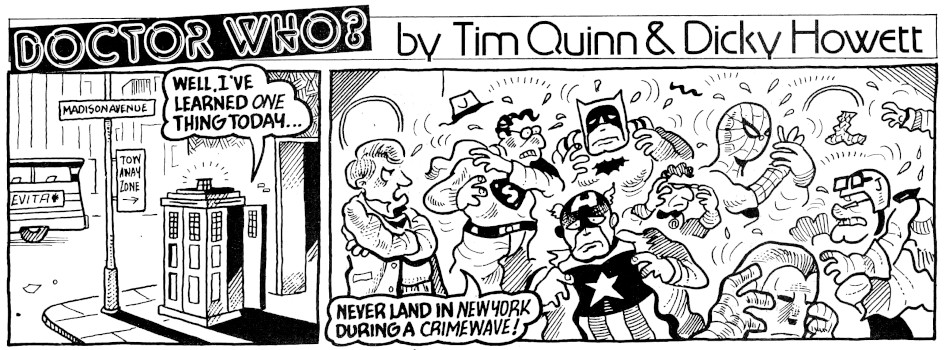
|
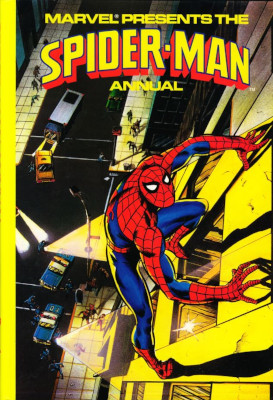 |
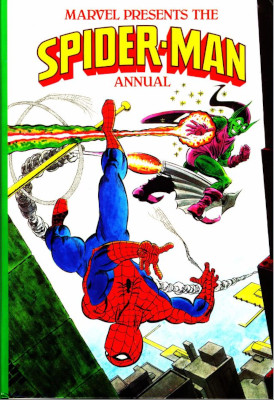 |
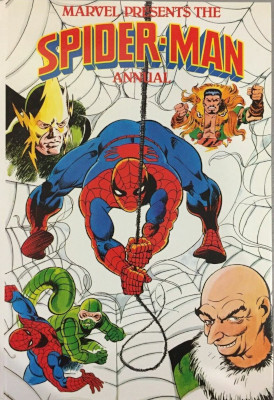 |
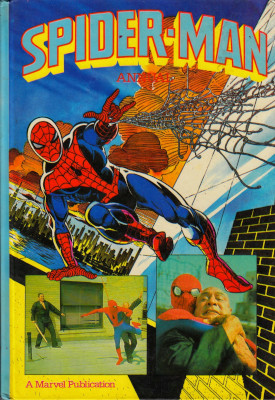 |
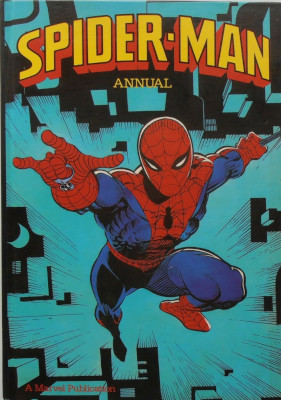 |
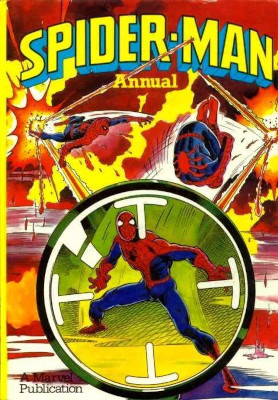 |
|
1980 Annual, published 1979
|
1981 Annual, published 1980
|
1982 Annual, published 1981
|
1983 Annual, published 1982
|
1984 Annual, published 1983
|
1985 Annual, published 1984
|
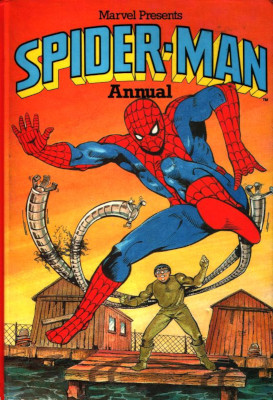 |
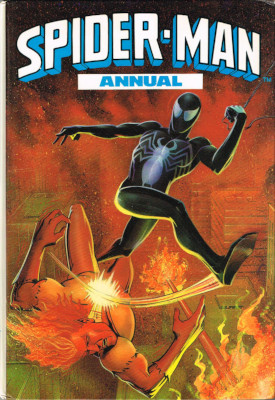 |
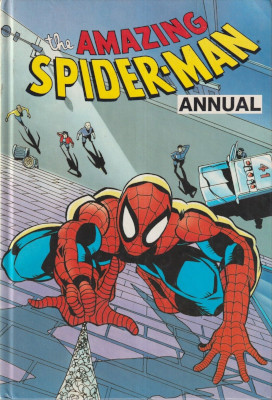 |
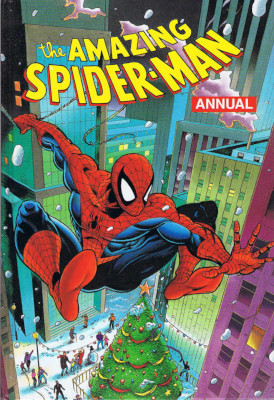 |
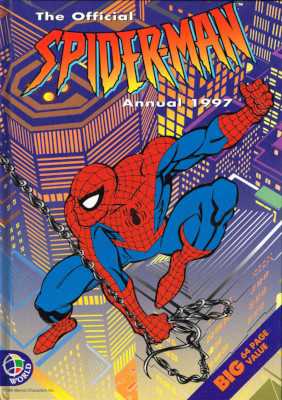 |
|
|
1986 Annual, published 1985
|
1987 Annual, published 1986
|
1992 Annual, published 1991
|
1994 Annual, published 1993
|
1997 Annual, published
1996
|
|
|
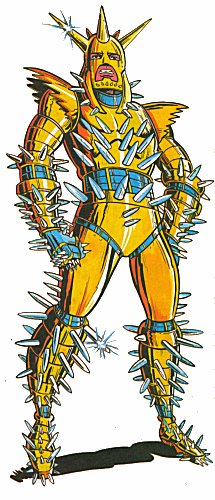 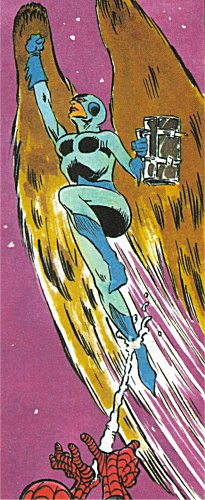 Title/issues: Spider-Man
Annual 1980-1987, 1992, 1994, 1997 Title/issues: Spider-Man
Annual 1980-1987, 1992, 1994, 1997
Where: U.K.
Featuring: Spider-Man
616?: Some definitely - Bluebird was mentioned in
Vulture's Handbook entry. All others, potentially.
Summary: (1980) A Sting in the Tail
Fun-House of Fear
(1981) Murder by Machine
Grin of the Goblin
(1982) Electric Sting
(1983) Blight of the Bluebird
Starngore the Superb
(1984) Scourge of the Sleeper
Hunter's Moon
(1985) Eight Legs Hath the Spider
Lord of Light
(1986) Hot Times
Hammer-Fist and Knife-Slice
(1987) The Contract
(1992) Sawdust and Diamonds
(1994) Computer Chaos
Spider-Man & The Phantom Fiend
Spider-Man & the Gruesome Grappler
(1997) The Spider-Shadow
The Berserker Machine
Reprinted in U.S.?: No
Comments: Despite Marvel U.K. publishing the weekly comics
reprinting Marvel U.S. titles, through the 1970s and 80s annuals
were still being published by licensors. Throughout most of the
70s these were purely reprints, but in 1979 publisher World
Distributors included brand new illustrated text stories in its
Spider-Man, Hulk and Fantastic Four Annuals. The next year the
license had passed to Grandreams, but the trend for new text
stories continued through most of the 1980s, and recurred a few
times in the 1990s, by which point Marvel was publishing the
annuals themselves. The 1990s annuals also included a few new
comic stories. After the demise of Marvel U.K. the licensors
Pedigree and then Panini took over the release of Spider-Man
Annuals into the 2000s, but by that juncture they were back to
being solely filled with reprints.
Note that U.K. annuals were generally released in
September or later, intended to be available early enough to be
bought as Christmas presents. To keep annuals received on December
25th of a given year feeling "new" to their young recipients, if
an annual carried a cover date it was typically that of the next
year. Thus for example an annual released in 1980 is generally
considered the 1981 Annual. However some annuals carried no cover
date, and this has led to confusion in later years, especially on
sites selling them online - one person will list a given annual as
being the 1980 one based on the indicia saying it came out in
1980, while another while another will list it as 1981 based on
that same information. Since I'm sure at least some people reading
this will try to hunt down and purchase the annuals with new
stories in them, I've chosen to depict the covers of ALL the
annuals that included such tales; if you're hunting for them,
confirm which annual it is by the cover, not the year the seller
claims it is.
A full
gallery of Spider-Man Annuals, including the purely reprint
ones, can be found on Tony's Trading, mentioned above.
|
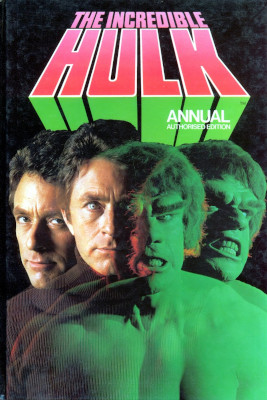 |
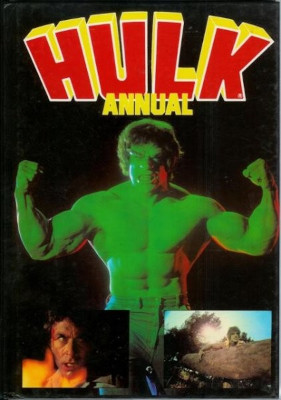 |
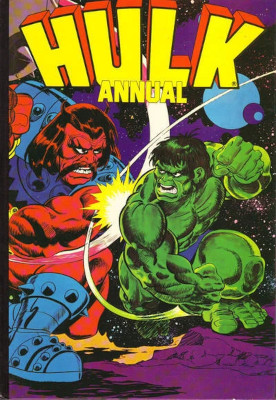 |
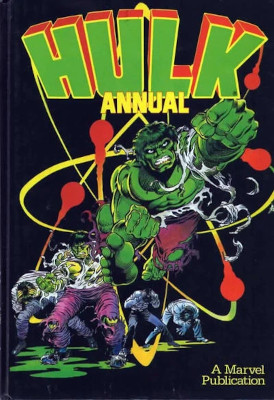 |
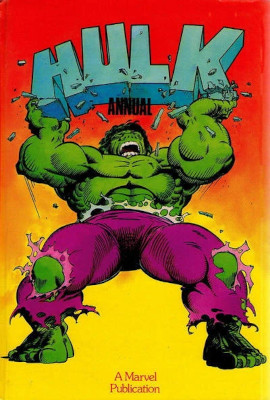 |
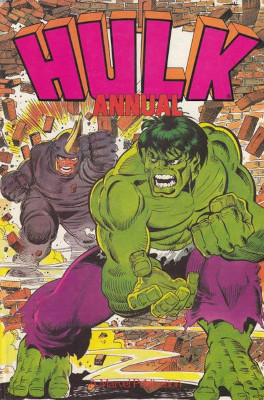 |
|
1980 Annual, published 1979
|
1981 Annual, published 1980
|
1982 Annual, published 1981
|
1983 Annual, published 1982
|
1984 Annual, published 1983
|
1985 Annual, published 1984
|
|
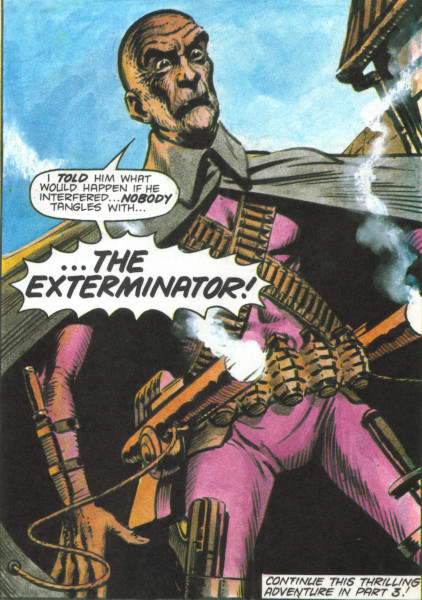 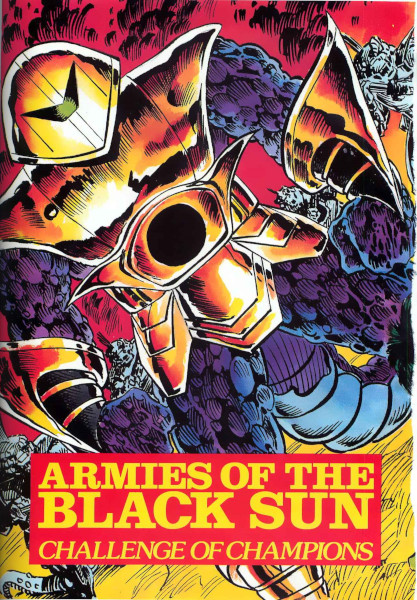 Title/issues:
Hulk Annual 1980-1985 Title/issues:
Hulk Annual 1980-1985
Where: U.K.
Featuring: Hulk
616?: Potentially
Summary: (1980) Wings of Death
Double Trouble
Secret Army
Terror of the Swamps
(1981) Pit of Doom
Blackmail
Might of the Mechadroid
(1982) A Hostage for the Hulk
Caged
(1983) Old Dark House
Death and the Droid
(1984) Armies of the Black Sun - Strike from the Stars
Armies of the Black Sun - Challenge of the Champions
(1985) Menace of the Maker
Star Scout
Reprinted in U.S.?: Yes, in Hulk: From the Marvel U.K.
Vaults
Comments: Like the Spider-Man Annuals above a number of
Hulk Annuals included new text stories. In addition two, the ones
with photo covers from the Hulk TV series, also featured multiple
brand new comic strips.
Again, a complete
gallery of U.K. Hulk annuals can be found on Tony's Trading.
|
|
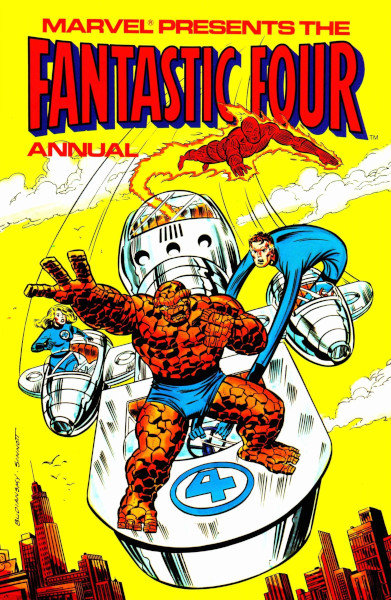 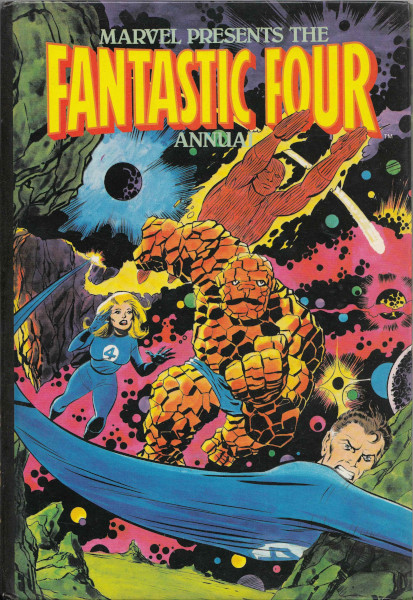 Title/issues:
Fantastic Four Annual 1980, 1981 Title/issues:
Fantastic Four Annual 1980, 1981
Where: U.K.
Featuring: Fantastic Four
616?: Potentially
Summary: (1980) Encounter
Where Walks the Wizard
(1981) A Shade Too Dangerous
The Rescue
Reprinted in U.S.?: No
Comments: As with Spider-Man and the Hulk, the Fantastic
Four Annuals of the late 1970s/early 1980s carried new illustrated
text tales, though since there were fewer
FF annuals released there were also fewer with new material.
|
The early 1980s ushered in further changes for Marvel U.K.
After the outpouring of new stories that had made Hulk Comic stand out
from its peers Marvel U.K. cut back on producing expensive new material
and returned mainly to reprints. However two characters from that Hulk
Comic bonanza would be the main exception to that reprint rule, as both
Captain Britain and Night Raven, the latter shifting to illustrated text
stories, would continue to appear, hop-skipping from one comic to the next
to stay ahead of title cancellations, and though they repeatedly were
transferred to differing titles they seemed to always be drawn back
together to appear alongside one another.
Meanwhile U.K. comics were themselves undergoing something
of a transformation. Prior to the 1970s most U.K. comics carried a range
of stories, and could be broadly split into two main types - adventure
comics which told more or less serious stories, and humor comics which
were dominated by short comedic strips (though both types could and
usually did carry one or two strips of the other type). But from the 1970s
many new U.K. comics "themed" themselves - I.P.C's Battle and D.C.
Thomson's Warlord featured wartime tales, Monster Fun was horror-oriented,
Misty went for spooky, 2000A.D. was sci-fi, etc. Marvel U.K. had tried to
follow suit with 1977's Fury, repacking Marvel wartime tales of Nick Fury
and Captain Savage behind new covers by Brian Bolland and Carlos Ezquerra,
but the 1980s saw them lean into this - while some of their output
remained clearly superhero-oriented and used Marvel-style titles
(Spider-Man, Marvel Team-Up, etc.), others tried to more closely resemble
the successful themed titles of rival publishers. Thus Forces in Combat
tried to push itself as an action comic (with heavy war undertones),
Future Tense as sci-fi, Savage Action as gritty crime, and Valour as
fantasy/sword and sorcery. This branding effort only lasted a few years
before Marvel U.K. reverted to just naming new comics after major
superheroes, but it was an interesting time while it lasted.
One other new thing in Marvel U.K. of the 1980s that became
a constant across almost all their titles was the inclusion of new humor
strips. With a limited budget for new stories, Marvel U.K. enlisted writer
Tim Quinn and his artist partner-in-crime Dicky Howett to produce a number
humor strips for multiple titles, varying from only three panels long
(most commonly) to a page per issue. The longer strips tended to be title
specific and told ongoing stories, while the shorter ones often jumped
almost randomly from one comic to another. A little later in the decade
artist Lew Stringer also began producing new humor strips for Marvel U.K.,
several of which featured Marvel characters as frequent guest stars.
|
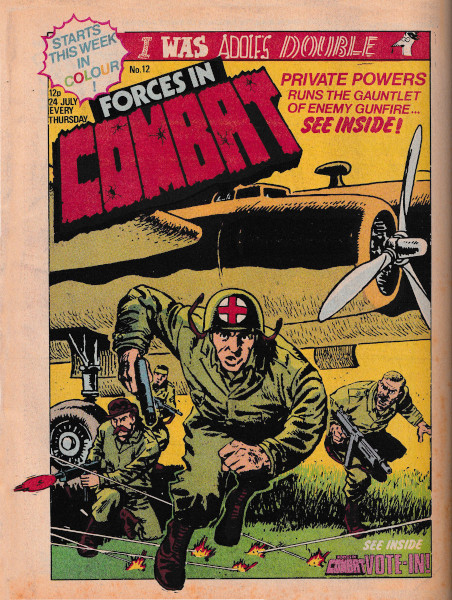 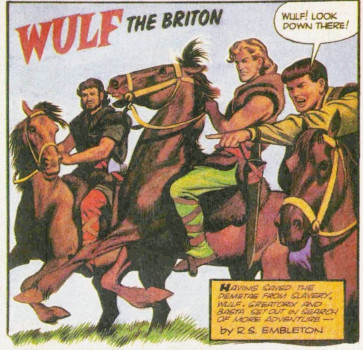 Title/issues:
Forces in Combat#12-15, 17-26 (24th July-5th
November 1980) Title/issues:
Forces in Combat#12-15, 17-26 (24th July-5th
November 1980)
Where: U.K.
Featuring: Winston
S. Quaill in "I was Adolf's Double"
616?: No. Set on Earth-333333333
Summary: To follow
Reprinted in U.S.?: No.
Comments: As mentioned above, Forces in Combat was
action-themed, trying to avoid obvious superheroes for the most
part. Thus the first issue carried war-action in "Fury of the
Commandos" (a renamed Sgt Fury and His Howling Commandos);
science-fiction action in Rom, Spaceknight; Western action with
Rawhide Kid; fantasy action with Kull; kung-fu action with
Shang-Chi; and a horror-themed mystery, "Lifeboat" reprinted from
Monsters Unleashed.
The first thirteen issues also carried Wulf the
Briton, the only strip in full color. Those hunting for new Marvel
material might be forgiven for mistaking this to to be another
example of what they are searching for, since trying to figure
what Marvel U.S. title it came from will yield no results, but in
fact it was a reprint of an older British strip originally
published in Express Weekly in the 1950s. The final segment in
Forces in Combat#13 urged readers not to miss "next weeks thrill"
but every reader did, as Wulf the Briton had vanished without
explanation.
Forces in Combat also began reprinting the John
Kowalski stories from Marvel U.S's War is Hell, but chose to
modify the story so that instead of the spectral star being John
Kowalski, disgraced U.S marine wrongly convicted of treason and
deported back to his native Poland where he fails to heed warnings
about the impending Nazi invasion the star was now British spy
Frank Charlesworth, son of a Polish immigrant whose original name
was Juszczyk, sent by the War Department in London to set up
resistance groups in Poland in anticipation of the Nazi invasion.
However, apart from modifying some text and rearranging panel
orders to accommodate this revised origin, the story's remained
the same, so it was a modified reprint rather than new stories.
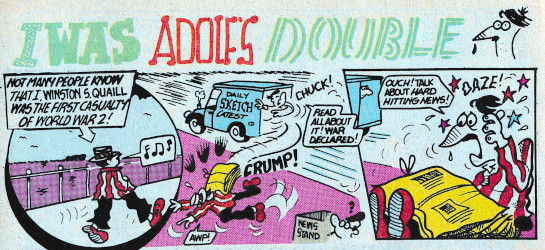 Actual new material began appearing in Forces in Combat#12, with
the arrival of Quinn and Howett's I Was Adolf's Double, featuring
the misadventures of the unfortunate Winston S. Quaill thanks to
his resemblance to the Nazi dictator. Each episode was a full
page, for a total run of 13 pages when it concluded. As the cover
for Forces in Combat#12 boasted, the strip was initially in full
color, but this only lasted for the first four installments, after
which it switched to black and white. The entire story was later
collected and reprinted in the Channel 33 1/3 Special (see below).
Actual new material began appearing in Forces in Combat#12, with
the arrival of Quinn and Howett's I Was Adolf's Double, featuring
the misadventures of the unfortunate Winston S. Quaill thanks to
his resemblance to the Nazi dictator. Each episode was a full
page, for a total run of 13 pages when it concluded. As the cover
for Forces in Combat#12 boasted, the strip was initially in full
color, but this only lasted for the first four installments, after
which it switched to black and white. The entire story was later
collected and reprinted in the Channel 33 1/3 Special (see below).
|
|
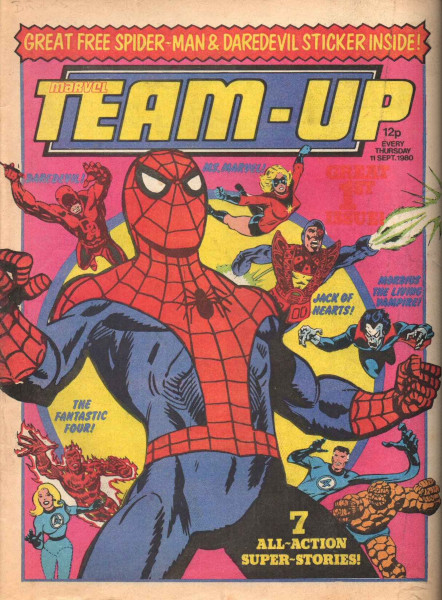 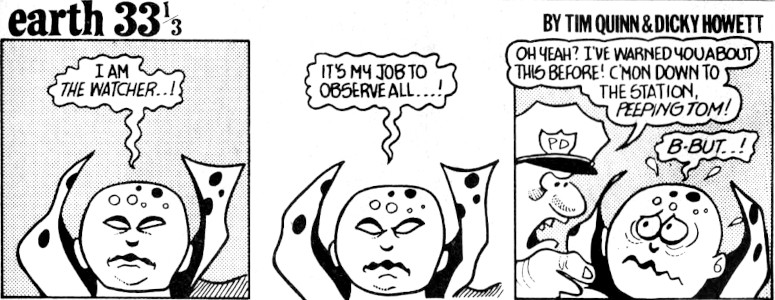 Title/issues: Marvel
Team-Up#1-11, 15, 17-23 (11th September 1980-18th February
1981) Title/issues: Marvel
Team-Up#1-11, 15, 17-23 (11th September 1980-18th February
1981)
Where: U.K.
Featuring: Earth 33 1/3
616?: No. Set on Earth-333333333
Summary: To follow
Reprinted in U.S.?: No
Comments: Launched in the second half of 1980, Marvel
Team-Up featured a grab-bag of Marvel's superhero characters, as
well as the debut of Quinn and Howett's Earth 33 1/3, a usually
three panel humor strip that focused on an overtly silly version
of the Marvel universe and its characters. The strip would go on
to appear in multiple titles, surviving long after Marvel Team-Up
was cancelled after only 25 issues, merging (as so many other
titles did) into the main Spider-Man weekly comic.
|
|
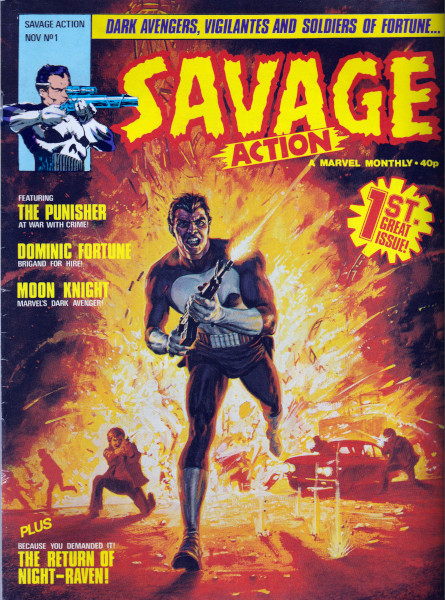 Title/issues:
Savage Action#1-4, 6, 8, 14-15 (November
1980-January 1982) Title/issues:
Savage Action#1-4, 6, 8, 14-15 (November
1980-January 1982)
Where: U.K.
Featuring: Night Raven
616?: Yes.
Summary: To follow
Reprinted in U.S.?: Yes
Comments: A monthly title, Savage Action reprinted the
slightly more mature stories from Marvel's black and white
magazines, and aimed for a gritty crime themed title, initially
carrying Punisher, Moon Knight and thirties adventurer Dominic
Fortune's stories. Alongside these was the return of Night Raven,
no longer in the comic strip format he had enjoyed in Hulk Comic,
but now in prose tales with a few illustrations. At this juncture
however these short stories continued to be noir crime thrillers
like his prior adventures.
|
|
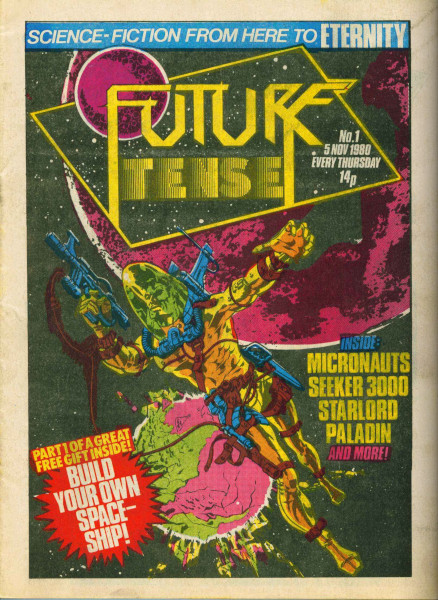 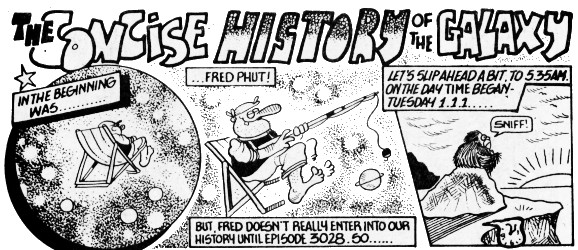 Title/issues:
Future Tense#1-9, 12, 15-16, 18-19; Future
Tense & Valour#20-21, 23-26, 28-29, 31-35; Future Tense#37-40
(5th November 1980-December 1981) Title/issues:
Future Tense#1-9, 12, 15-16, 18-19; Future
Tense & Valour#20-21, 23-26, 28-29, 31-35; Future Tense#37-40
(5th November 1980-December 1981)
Where: U.K.
Featuring:
- Rev. Starkey in The Concise History of the Galaxy: #1-9, 12,
15-16, 18-21, 23-26, 28-29, 31-35, 37-39
- Whacker's Worlds: #40
616?: No. Set in Reality-333333333
Summary: To follow
Reprinted in U.S.?: No
Comments: Launched the same week as its sister title
Valour (see below), Future Tense was a science-fiction themed
title, with a starting line-up of Micronauts, Starlord, Warlock,
and Seeker 3000 and Paladin, both originally from Marvel Premiere.
Despite appearing on the cover, presumably because he was wearing
a spacesuit in the image, Nick Fury was nowhere to be seen.
Alongside these characters was another Quinn/Howett strip, the SF
epic The Concise History of the Galaxy, which followed the
escapades of overly-evolved prehistoric ape Rev Starkey as he
battled the evil Black Editor and gallivanted across time and
space. After an initial full-page start, it switched to half pages
until #37, with the last three parts reverting to full pages.
Future Tense itself had also undergone some changes.
After absorbing the failing Valour, it was retitled to carry both
names from #20 until #35; the change back to just being called
Future Tense was also accompanied by a shift to monthly
publication, with new glossy covers and a higher page count.
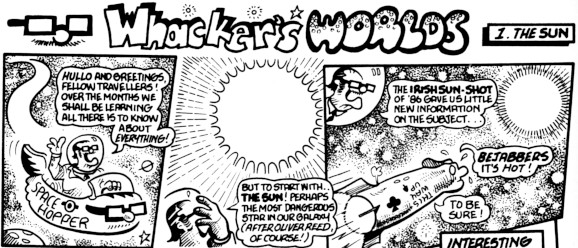 With The Concise History of the Galaxy having concluded in #39,
#40 carried a one-off brand new one-page strip, Whacker's Worlds,
parodying a well established U.K. documentary series, Whicker's
World. Whether it might have continued is unknown, as Future Tense
ended with #41.
With The Concise History of the Galaxy having concluded in #39,
#40 carried a one-off brand new one-page strip, Whacker's Worlds,
parodying a well established U.K. documentary series, Whicker's
World. Whether it might have continued is unknown, as Future Tense
ended with #41.
|
|
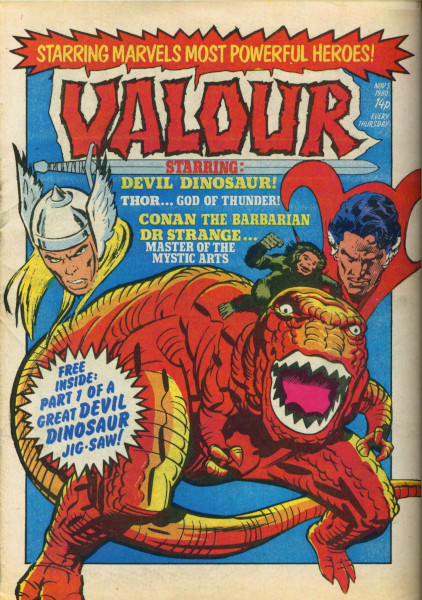 Title/issues:
Valour#1-6 (5th November-10th December 1980) Title/issues:
Valour#1-6 (5th November-10th December 1980)
Where: U.K.
Featuring: Earth 33 1/3
616?: No, set on Earth-333333333
Summary: To follow
Reprinted in U.S.?: No
Comments: Launched the same week as its sister title
Future Tense, Valour was fantasy-themed, with Conan, Dr. Strange,
Devil Dinosaur and Tales of Asgard among its initial stories.
Alongside them were more short Earth 33 1/3 strips by Quinn and
Howett, though only for the first six issues. Valour itself was
short-lived, ending with #19, after which it merged with Future
Tense.
|
|
 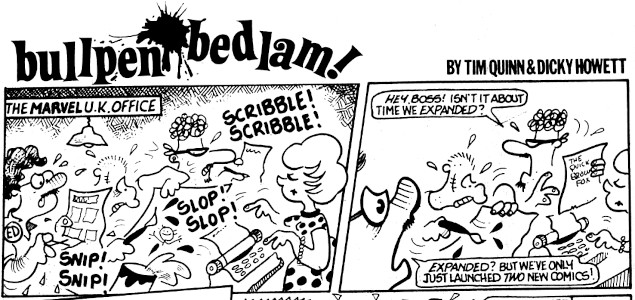 Title/issues:
Spider-Man and Hulk Weekly#400-403, 406-408,
412-415, 418-425, 427-428, 432-434, 436-448 (5th November-7th
October 1981) Title/issues:
Spider-Man and Hulk Weekly#400-403, 406-408,
412-415, 418-425, 427-428, 432-434, 436-448 (5th November-7th
October 1981)
Where: U.K.
Featuring: Bullpen Bedlam
616?: Probably set on Earth-333333333, but potentially
this could be 616
Summary: To follow
Reprinted in U.S.?: No
Comments: The same week that Future Tense and Valour both
launched, Marvel U.K.'s Spider-Man title, at this point subtitled
"and Hulk Weekly," hit its landmark 400th issue, and added its
first Quinn/Howett strip, Bullpen Bedlam, purportedly showing the
shenanigans going on in the Marvel U.K. offices. The strip,
usually half a page, ran for nearly a full year, surviving when
the title changed to Spider-Man and Hulk Team-Up (thanks to
absorbing Marvel Team-Up), but stopping just before the next major
title change, at which point it was replaced by a new series (more
on which below). Bullpen Bedlam survived however, skipping over to
both the new Incredible Hulk title and Captain America for a
handful of appearances, before settling in a new long-term home in
the Original X-Men comic - all of which are covered below.
|
|
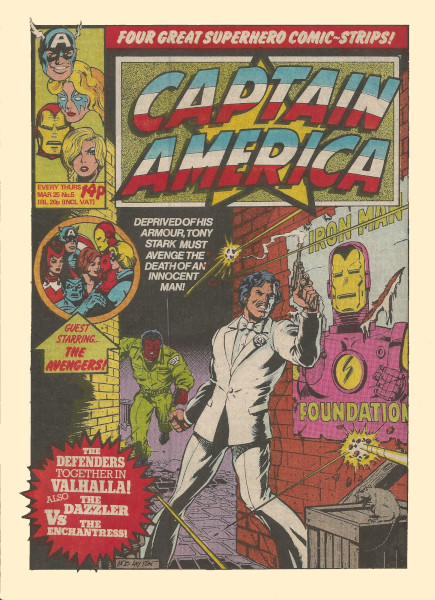 Title/issues:
Captain America#5-10, 12-13, 17-19; Marvel
Action Starring Captain America#21, 23-26, 28-30; Captain
America#31-32, 34, 37-39, 41-59 (25th March 1981-7th April 1982) Title/issues:
Captain America#5-10, 12-13, 17-19; Marvel
Action Starring Captain America#21, 23-26, 28-30; Captain
America#31-32, 34, 37-39, 41-59 (25th March 1981-7th April 1982)
Where: U.K.
Featuring:
- Earth 33 1/3: #5-10, 12-13, 17-19, 21, 23-26, 28-32, 34,
38-39, 42-59
- Bullpen Bedlam: #37, 41
616?: Earth 33 1/3 - no, set on Earth-333333333. Bullpen
Bedlam - probably Earth-333333333, outside chance of 616.
Summary: To follow
Reprinted in U.S.?: No
Comments: Having launched in February 1981 with a line-up
consisting of Captain America, Iron Man, the Defenders and
Dazzler, Captain America added the humor strip Earth 33 1/3 from
#5. The series continued to appear for the rest of the title's 59
issue run, skipping the odd issue and with Bullpen Bedlam twice
stealing its slot.
|
|
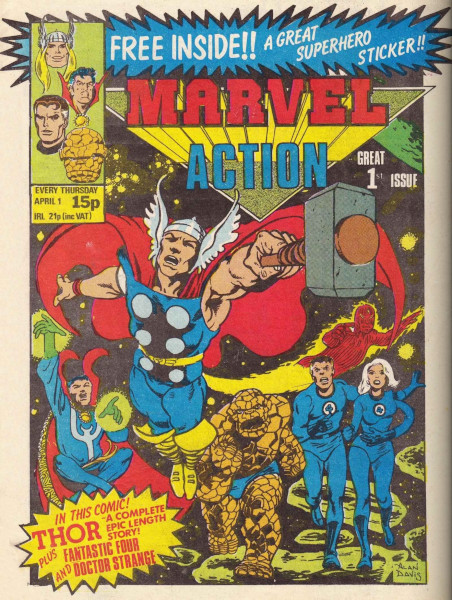 Title/issues:
Marvel Action#1-5, 7-8, 10, 12-14 (1st
April-1st July 1981) Title/issues:
Marvel Action#1-5, 7-8, 10, 12-14 (1st
April-1st July 1981)
Where: U.K.
Featuring: Earth 33 1/3
616?: No, set on Earth-333333333
Summary: To follow
Reprinted in U.S.?: No
Comments: Earth 33 1/3's next home was in the pages of
Marvel Action. With themed titles having presumably not proven
better sellers, Marvel U.K.'s new comics shifted back towards more
generic superhero action, and titles that were either named after
headliner strips or generic enough to permit including almost any
reprint. In the case of Marvel Action these were Thor, Doctor
Strange and Fantastic Four, as well as the aforementioned Earth 33
1/3. It only lasted 15 issues before being merged into Captain
America; though some sites list higher numbers thanks to the
merged title briefly calling itself Marvel Action starring Captain
America, it was definitely Marvel Action that had ended, as
confirmed when the merged title reverted to simply calling itself
Captain America.
|
|
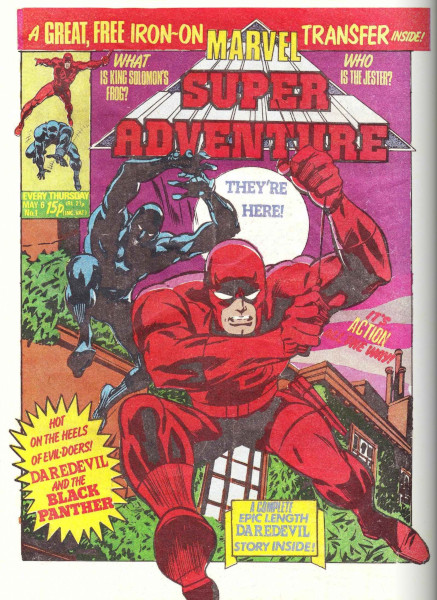 Title/issues:
Marvel Super Adventure#1-3, 7-9, 11,
13-16, 18-21, 23-26 (6th May-26th October 1981) Title/issues:
Marvel Super Adventure#1-3, 7-9, 11,
13-16, 18-21, 23-26 (6th May-26th October 1981)
Where: U.K.
Featuring: Earth 33 1/3
616?: No, set on Earth-333333333
Summary: To follow
Reprinted in U.S.?: No
Comments: Earth 33 1/3's next home was Marvel Super
Adventure, which also featured Daredevil and Black Panther.
Despite the clunkier name, this title lasted marginally longer
than Marvel Action, finishing on #26, after which it was likewise
absorbed into Captain America.
|
|
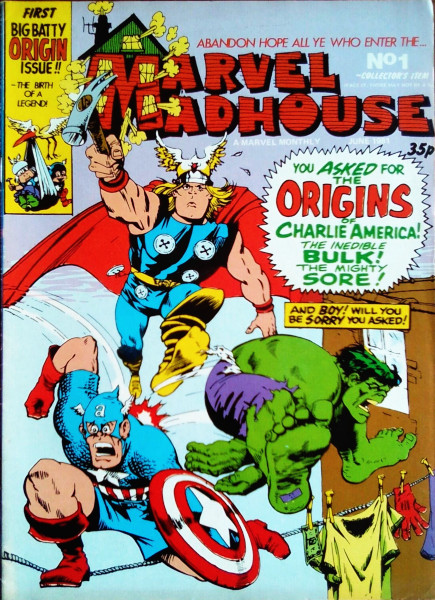 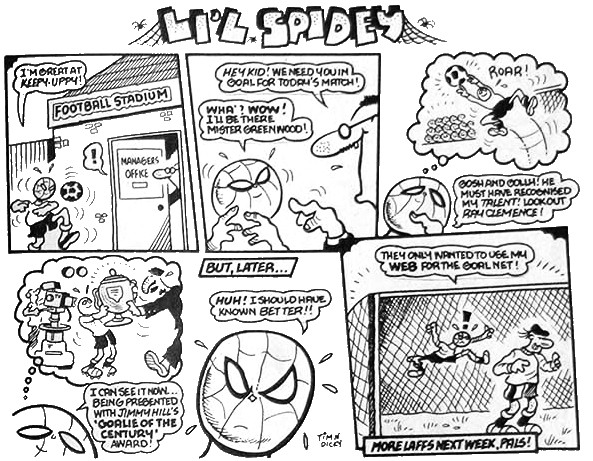 Title/issues:
Marvel Madhouse#1, 5-6, 8-9 (June
1981-February 1982) Title/issues:
Marvel Madhouse#1, 5-6, 8-9 (June
1981-February 1982)
Where: U.K.
Featuring:
- Earth 33 1/3: The Movie: #1
- What if Thor Appeared in Nancy?: #5
- Hulk the Menace: #6
- L'il Spidey: #6
- The Nice Avengers: #8
- A Day in the Life of a Typical Marvel Fan: #9
616?: No, set on Earth-333333333, with the possible
exception of L'il Spidey and the What If - but neither of these
are 616 either.,
Summary: To follow
Reprinted in U.S.?: No
Comments: Marvel Madhouse primarily reprinted Not Brand
Echh!, but its humor remit also made it a prime spot for Quinn and
Howett to test run new strips. Thus in #1 Earth 33 1/3 got a three
page, rather than three panel strip, while #6 test ran two short
strips, L'il Spidey and Hulk the Menace; the latter would
subsequently pop up in other titles and accrue a decently long
run. All the strips bar L'il Spidey and Hulk the Menace were
subsequently reprinted in the Channel 33 1/3 Special.
|
|
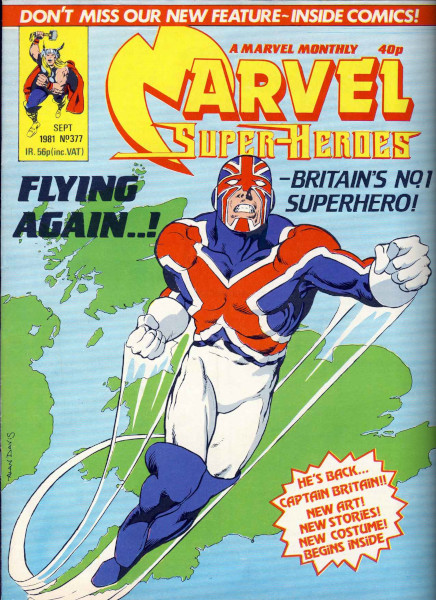 Title/issues:
Marvel Super-Heroes#377-397 (September 1981-May
1983) Title/issues:
Marvel Super-Heroes#377-397 (September 1981-May
1983)
Where: U.K.
Featuring:
- Captain Britain: #377-388
- Night Raven: #382-386, 389-395
- Earth 33 1/3: #390, 393, 395-397
616?: Captain Britain and Night Raven, yes. Earth 33 1/3
- no, set on Earth-333333333
Summary: To follow
Reprinted in U.S.?:
- Captain Britain - yes
- Night Raven - yes, in Night Raven: From the Marvel UK Vaults
- Earth 33 1/3 - no
Comments: Marvel Super-Heroes was actually Marvel U.K.'s
very first comic, originally published from 7th October 1972 as
the weekly Mighty World of Marvel. It was briefly simplified to
just Marvel Comic as of #330, and then in September 1979 it became
a monthly under the new title Marvel Super-Heroes, reprinting
Avengers and the original X-Men (the All-New X-Men were then
appearing in the sister monthly Rampage). The monthly title's
third slot was initially filled by Ms. Marvel, and later by
Champions. The ending of that latter series in #376 was
accompanied by a note "Watch out for the Defenders -- next issue!"
And sure enough, the very next issue, #377, there was...no
Defenders strip. Instead, Captain Britain, fresh from co-starring
in Black Knight's strip in Incredible Hulk Weekly, returned in his
own series, complete with a new costume by Alan Davis and the
privileged cover place. Written by David Thorpe, the new series
found Captain Britain and his ally, the Otherworld elf Jackdaw,
stranded on a dystopian alternate Earth by Merlin.
A few months later CB's old Hulk stablemate Night
Raven rejoined him, as MSH absorbed the dying Savage Action. Still
in text format, the 1930s vigilante enjoyed a few "standard" crime
stories before new writer Alan Moore came in and massively shook
up the hero's status quo, as the previously enjoyable but
unremarkable "pulps" crimefighter was targeted by a previously
throwaway and unremarkable old foe for a truly brutal vengeance
that would transform Night Raven into a tragic immortal forever
isolated from normal humans as he tried to hunt down his elusive
and similarly immortal nemesis to exact some payback. It would be
a trend that would continue whenever Moore assumed writing duties
on a series, as Captain Britain would discover when Moore also
took over that series. The first four pages of Captain Britain's
strip in MSH#386 saw him succeed in helping new ally Saturnyne of
the Dimensional Development Court save the retrograde Earth he was
stranded on. Alan Moore took over for the fifth and final page,
and immediately pulled the rug out from under the hero, killing
him two issues later and ending his strip, though only in
preparation for moving the hero to a new home, The Daredevils.
Night Raven continued for a few more issues, and was
joined by the itinerant Earth 33 1/3. With #393 MSH absorbed
Rampage, only to itself be cancelled with #397, and absorbed into
The Daredevils. It seems that Captain Britain had left for
pastures new, only for the remnants of his old title to take up
residence in his new home.
|
|
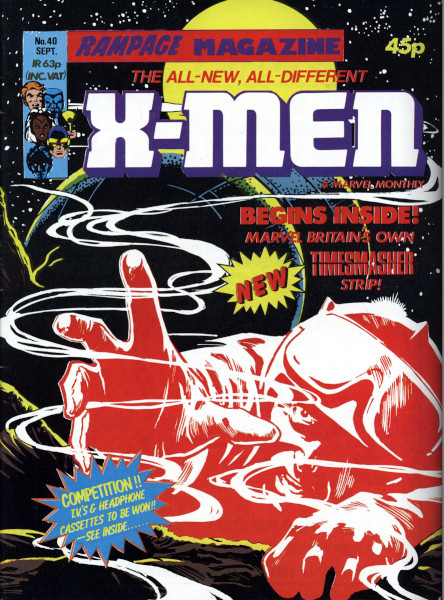 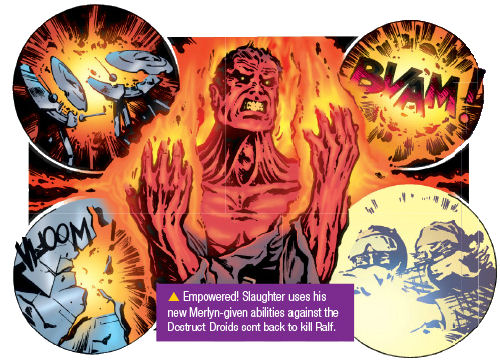 Title/issues: Rampage#40-44,
52-53 (September 1981-November 1982) Title/issues: Rampage#40-44,
52-53 (September 1981-November 1982)
Where: U.K.
Featuring: Crusader, Time-Smasher, Earth 33 1/3
- Time-Smasher: #40, 42-44 (with text article about the series
in #41)
- The Crusader: #41
- Earth 33 1/3: #52-53
616?: Time Smasher - yes, referenced in Merlyn's handbook
entry. Crusader - potentially, but may also be on Earth-238, as
the character makes a cameo in flashbacks to that world in Captain
Britain's story. Earth 33 1/3 - no, set on Earth-333333333
Summary: To follow
Reprinted in U.S.?: No
Comments: Like MSH, Rampage had begun life as a weekly
title, but unlike MSH when it was relaunched as a monthly it was
treated as a new volume and reset its numbering. Early issues
reprinted the Hulk stories from the U.S. Rampaging Hulk magazine,
alongside Defenders and Nova, but from #8 the All-New X-Men joined
the line-up, and just as in the States they proved massively
popular. With #24 they began usurping the cover spot, and with the
Hulk's departure and replacement by the Thing from Marvel
Two-in-One in #28 the X-Men became the defacto and literal
headlines of the title, their name printed in larger font and a
more dominant position on the cover than the magazine's actual
name.
During its early run Rampage was entirely reprints,
but with #40, released the same month that Captain Britain arrived
in MSH, an original new strip debuted, Time-Smasher, a tale with a
tangential connection to Captain Britain's strip. It skipped the
next issue, though an article about the new strip was published
instead, discussing the hopes and plans for the story beyond it's
initial four-part run, which then continued over the next three
issues. Sadly, despite these plans, no further stories ever
surfaced, leaving the subsequent fate of the lead character, Kilgore
Slaughter, unrevealed.
Though Time-Smasher skipped #41, there was still a
new comic strip therein, The
Crusader. A one-shot humorous story, it was later reprinted
in The Daredevils#10, but with improved shading and backgrounds,
and new text in the final panel, slightly changing the ending.
With the end of Time-Smasher, Rampage reverted to
being solely reprints, until #52 when Earth 33 1/3 began the
briefest of runs, as Rampage ended with #53 and merged into MSH.
|
|
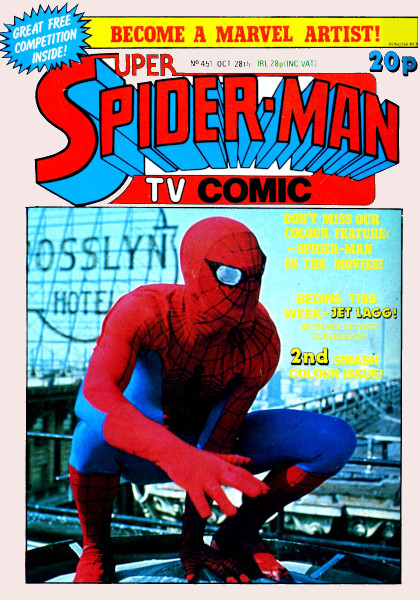 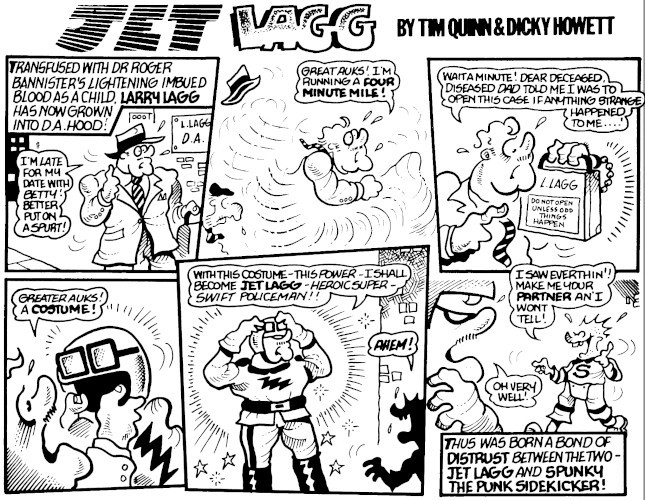 Title/issues:
Super Spider-Man TV Comic#451-458, 461-499
(31st March-26th September 1982) Title/issues:
Super Spider-Man TV Comic#451-458, 461-499
(31st March-26th September 1982)
Where: U.K.
Featuring:
- Earth 33 1/3: #473
- Fairly Amazing Spider-Hound: #482-499
- Jet Lagg: #451-458, 461-472, 474-481
- Spider-Man: #493
616?: Spider-Man - probably yes. Others - no, set on
Earth-333333333
Summary: To follow
Reprinted in U.S.?: No
Comments: Though the live-action American TV version of
Spider-Man had finished in 1979, it only began airing in the U.K.
in 1982. To capitalize on this, Marvel U.K. rebranded their long
running Spider-Man title, for once not to acknowledge a merger
with another title, but to try and draw in viewers of the TV show.
Thus with #450, Super Spider-Man TV Comic was born, with a whole
"8 pages of colour" and an article on the show. The next issue a
new Quinn/Howett half-page strip was added, featuring superhero
speedster Jet Lagg. With a couple of skipped weeks his adventures
ran for the next 30 issues.
Lagg's replacement was another superhero, the Fairly
Amazing Spider-Hound, which ran from #482 through #505, by which
time with the departure of the Spider-Man TV series from the air,
the comic had again reinvented itself (see below).
One more notable, and non-humor, new tale was a
brand-new two page Spider-Man story, The Mistake; in #450-452 the
comic had run a "Become a Marvel artist" competition, and in #454
had run a similar competition calling for would-be writers; the
winning script from the latter was then sent to the art
competition winner, and the result by writer Gary Mountford and
artist Stephen Easterbrook was published in Super Spider-Man TV
Comic#493.
|
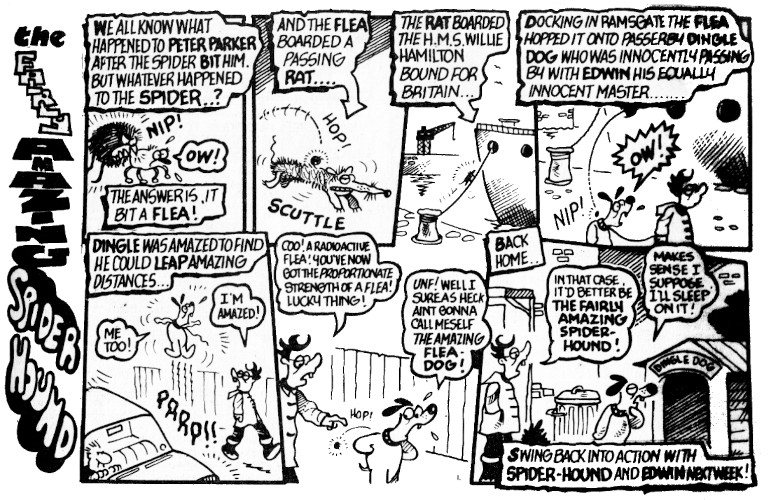
|
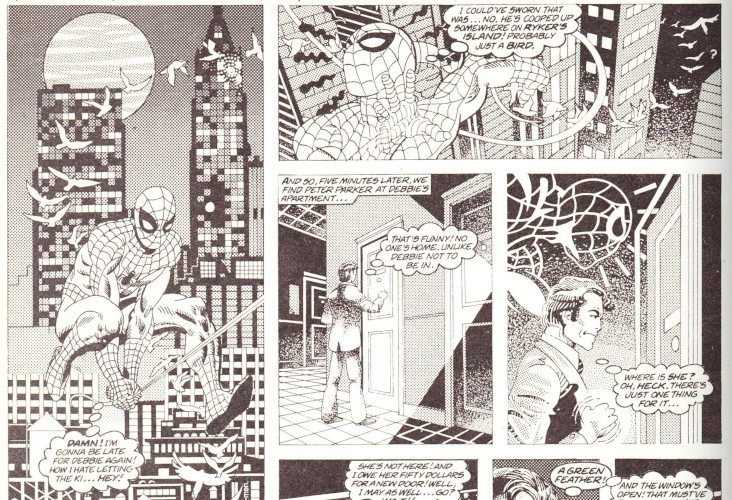
|
|
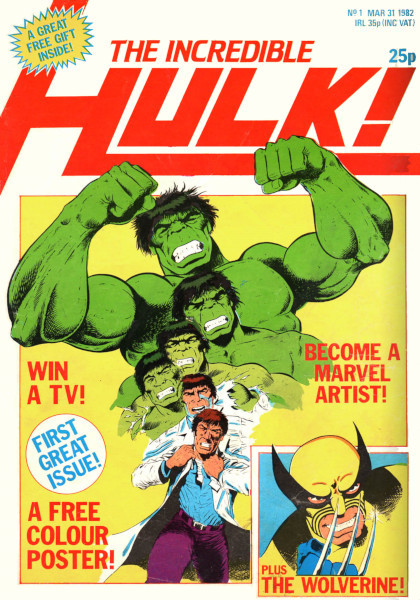 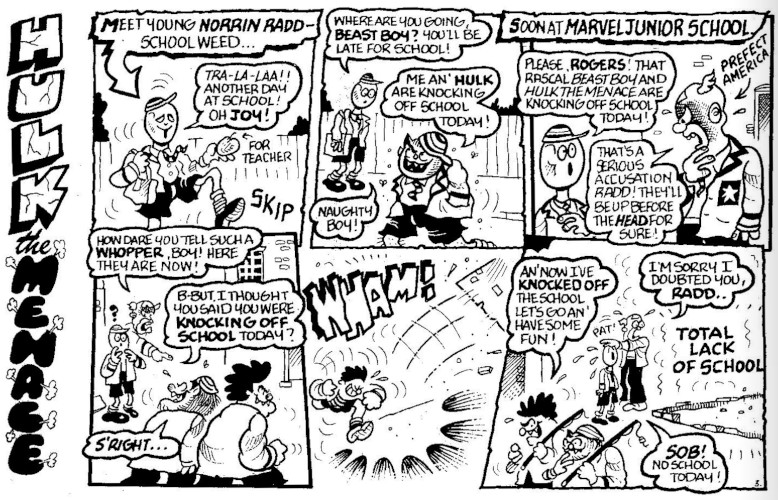 Title/issues:
Incredible Hulk#1-27 (31st March-26th
September 1982) Title/issues:
Incredible Hulk#1-27 (31st March-26th
September 1982)
Where: U.K.
Featuring:
- Bullpen Bedlam: #12
- Earth 33 1/3: #9
- Hulk the Menace: #1-11, 13-27
616?: Earth 33 1/3 and Hulk the Menace, no, set on
Earth-33333333. Bullpen Bedlam - probably set on Earth-333333333,
but slight chance of 616.
Summary: To follow
Reprinted in U.S.?: No
Comments: In 1982 Marvel U.K. gave Hulk another shot at
being the headliner for his own title. Marvel's new strategy for
weekly titles was glossy covers on titles named after a headline
character, and each issue reprinting at most two American comics -
in this case Incredible Hulk, and a What If? Alongside the
reprints was Quinn and Howett's Hulk the Menace, taking up
residence in his obvious home. The strip appeared through almost
the entire 27 issue run prior to the title, like its namesake
predecessor, being absorbed into Spider-Man's title.
|
|
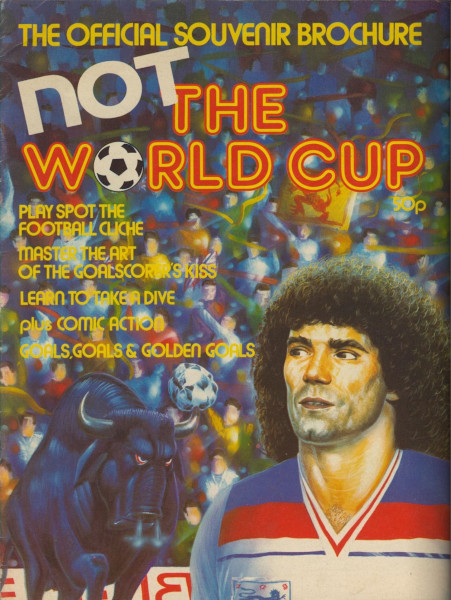 Title/issues:
Not the World Cup (1982) Title/issues:
Not the World Cup (1982)
Where: U.K.
Featuring: Ricardo
Del Wolverine
616?: Unlikely, but not impossible.
Summary: To follow
Reprinted in U.S.?: No
Comments: "Not the World Cup" was a three page comic
strip produced by Marvel UK as part of a 1982 World Cup souvenir
brochure, a humorous tale penned by Alan Moore around the same
time that he started writing Captain Britain, and drawn by Barrie
Mitchell, a highly experienced U.K. artist little known to U.S.
audiences but an excellent choice for this strip as he had been
drawing football-related strips for over a decade.
|
|
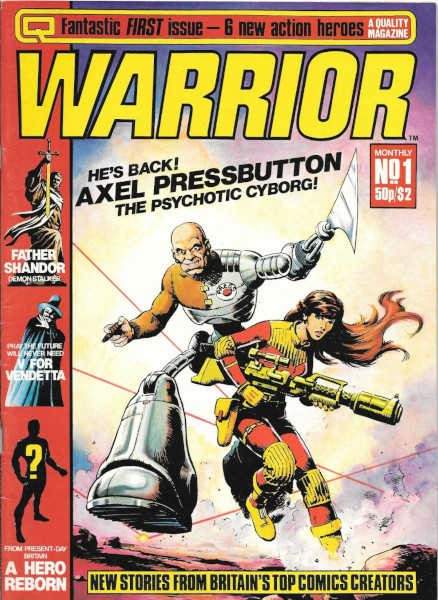 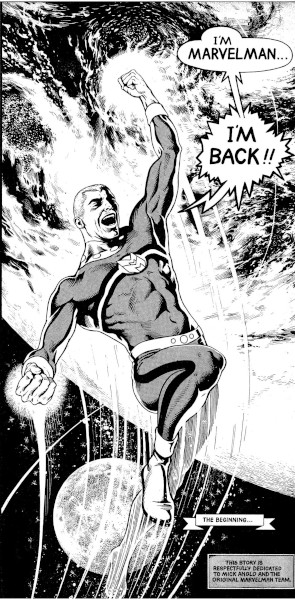 Title/issues:
Warrior#1-18, 20-21 (March 1982-July 1984) Title/issues:
Warrior#1-18, 20-21 (March 1982-July 1984)
Where: U.K.
Featuring:
- Marvelman: #1-11, 13-18, 20-21
- Young Marvelman: #12
- Warpsmiths: 9-10
616?: No.
Summary: To follow
Reprinted in U.S.?: Yes
Comments: Dez Skinn left Marvel U.K. in
January 1980, only 17 months after taking up his role as
Editorial Director, citing a desire to return to more creative
roles. In 1982 he set up his own company, Quality
Communications, and launched Warrior Magazine. Aimed at older
readers, Skinn deliberately tried to capture some of the feel of
Marvel U.K.'s more successful strips. Alan Moore and David
Lloyd's dystopian thriller V for Vendetta was intended to
recapture the mystery strip feel of Night Raven; fantasy series
The Spiral Path echoed the appeal of Hulk Weekly's Black
Knight/Otherworld saga; and psychotic cyborg Axel Pressbutton
sought to catch the imagination of fans of Abslom Daak, a
character who had debuted in Doctor Who Weekly. However, the
significant series from the perspective of this list of
Marvel-related comics produced in the U.K. was the superhero relaunch, similar to the one Dez had
overseen for Captain Britain, which saw Alan Moore revamp
1950s hero Marvelman with the able assistance of hit artists
including Dave Leach and Alan Davis.
Though the entire
line-up was strong, Marvelman was the immediate fan favorite,
prompting Skinn to capitalize on this by publishing a
Marvelman Special later that year (see below), which
unfortunately seems to have been the trigger for problems with
Skinn's old employers, Marvel, who apparently objected to a
rival company publishing a comic with "Marvel" so prominent in
the title. Despite the fact that Marvelman predated Marvel
even calling itself that, legal action was threatened,
ultimately leading to Marvelman being dropped from Warrior's
line-up; though apparently intended only to be a temporary
measure until things got sorted out, sales dropped without
Marvelman in the magazine, and ultimately Warrior was
cancelled. Moore completed his Marvelman tale under the new
name Miracleman for American publisher Eclipse, and handed the
reins over to Neil Gaiman, whose run got halted for decades
thanks to Eclipse going bankrupt and complex legal shenanigans
that arose over Marvelman/Miracleman's ownership, which were
finally untangle by (ironically) Marvel. So now Marvel owns
the character they tried to get cancelled back in the day.
Note that
creator-owned characters the Warpsmiths and (Dez Skinn's own)
Big
Ben appeared in Marvelman's strip, then went on to have
their own separate stories. The Warpsmith stories are set in
the same reality as Marvelman, so I'm listing those (and
Marvel has reprinted them as part of their Miracleman
reprints), but Big Ben was an alternate universe version from
the one seen in Marvelman, and so I'll not be tracking those.
Which is just as well, as that version of Big Ben shares a
reality with the Liberators and Bogey (two other strips from
Warrior) and the Steel Claw (an old IPC character reprinted in
the U.S. by Skinn's Quality Periodicals), so adding him would
add several additional stories to this list by association.
|
|
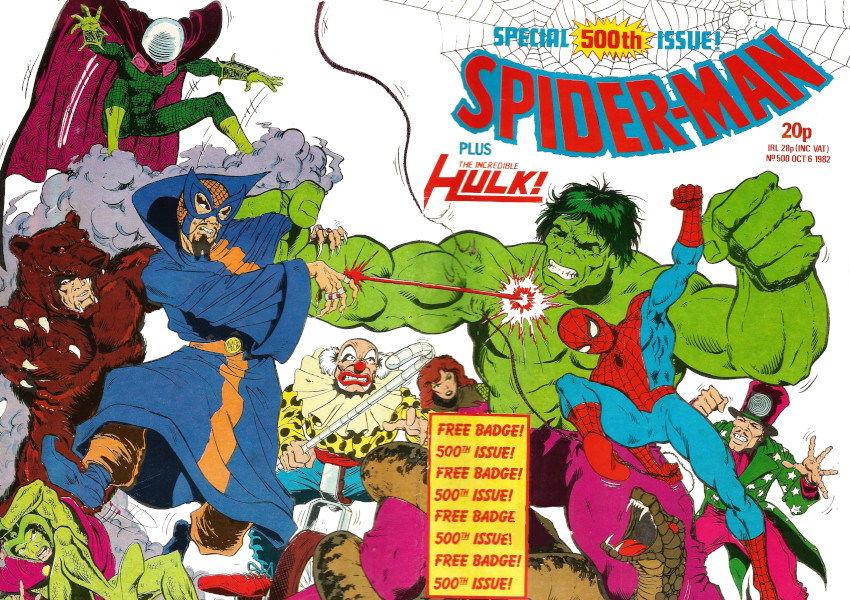 Title/issues:
Spider-Man#500-535, 537-547 (6th October
1982-31st August1983) Title/issues:
Spider-Man#500-535, 537-547 (6th October
1982-31st August1983)
Where: U.K.
Featuring:
- Earth 33 1/3: #547
- Fairly Amazing Spider-Hound: #500-505
- Hulk the Menace: 505-535, 537-546
- Would You Make a Marvellous Hero?: #500
616?: No, set on Earth-333333333
Summary: To follow
Reprinted in U.S.?: No.
Comments: With the Amazing Spider-Man TV show off air and
the latest Incredible Hulk comic ending, Marvel U.K.'s long
running Spider-Man title celebrated it's 500th issue by changing
title back to just Spider-Man. Well, Spider-Man plus (in really
small letters) The Incredible Hulk, but that subtitle only lasted
till #505 before being quietly dropped.
In terms of new strips, #500 had a one-off humorous
quiz by Quinn/Howett, "Would you make a Marvellous Hero?,", and
The Fairly Amazing Spider-Hound rounded out its run to end in
#505. That same issue Hulk the Menace was restarted as its
replacement - ironically the very issue that marked the last cover
mention of his original title. Hulk the Menace ran for almost the
entire length of this latest incarnation of Spider-Man's weekly,
and would pop up one more time under the next title (more on which
below). Earth 33 1/3 reappeared for #547, the final issue under
the current name, then to take advantage of the new Spider-Man and
His Amazing Friends cartoon that had begun airing, Spider-Man's
comic adopted the same title.
|
|
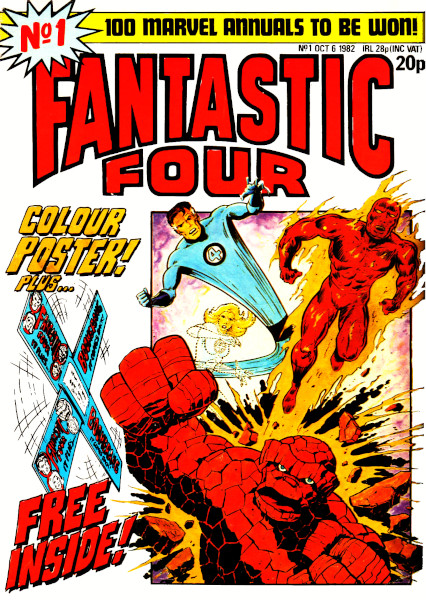 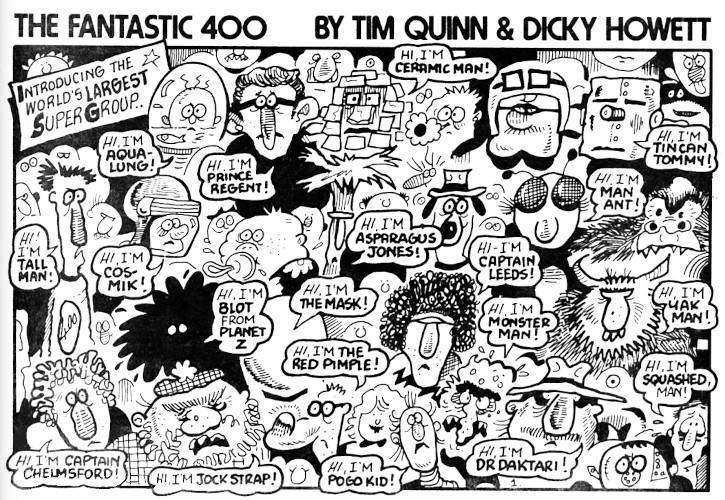 Title/issues:
Fantastic Four#1-29 (6th October 1982-20th
April 1983) Title/issues:
Fantastic Four#1-29 (6th October 1982-20th
April 1983)
Where: U.K.
Featuring: Fantastic 400
616?: No, set on Earth-333333333
Summary: To follow
Reprinted in U.S.?: No.
Comments: The new Fantastic Four weekly title featured yet
another new Quinn/Howett creation, the world's largest super group
the Fantastic 400. The series appeared in every one of the new
title's 29 issue run, and survived its cancellation. While the
Fantastic Four comic merged into (you guessed it) Spider-Man's
title, the Fantastic 400 strip jumped over to the new Mighty Thor
comic.
|
|
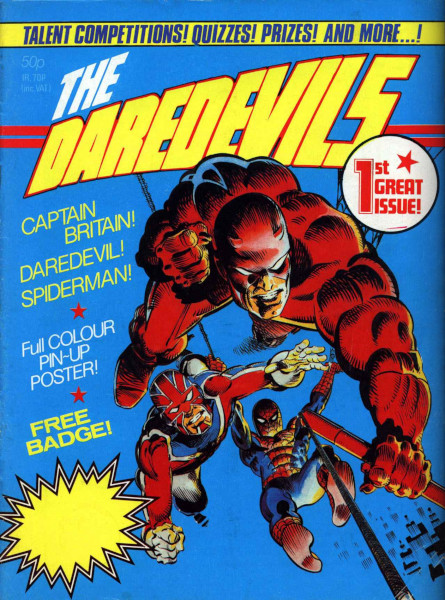 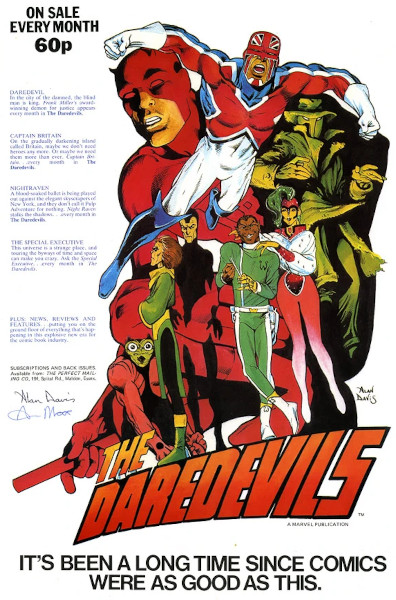 Title/issues:
The Daredevils#1-11 (January 1983-November 1983) Title/issues:
The Daredevils#1-11 (January 1983-November 1983)
Where: U.K.
Featuring:
- Captain Britain: #1-11
- Night Raven: #6-11
- Earth 33 1/3: #1-3, 5-7
- What
If?: #7-10
616?: Captain Britain and Night Raven, yes. Earth 33 1/3,
no, set on Earth-333333333. What If?, no, set on Earth-8377.
Summary: To follow
Reprinted in U.S.?: Captain Britain and Night Raven, yes.
Earth 33 1/3 and What If?, no.
Comments: Simultaneously to Alan Moore revamping Marvelman
in Warrior, he was also revamping Captain Britain in The
Daredevils, Marvel U.K.'s latest monthly title. As with Marvelman,
he dipped into the character's past lore and re-examined it from a
new lens; what differed was that in the former case he revealed
most of what had gone before was illusion, in the latter he took
the disparate fragments of Captain Britain's past tales and
developed them into something deeper and more powerful. A few
issues in Moore brought in the Special Executive that he had
created for Doctor Who Monthly and again developed that initial
concept into something deeper.
Captain Britain had jumped ship from Marvel
Super-Heroes nine issues before that title's demise, in
preparation for relaunching his tale in his new home, leaving
behind Night Raven to hold the fort. Six issues in, Night Raven
followed his old friend, the now immortal hero once again escaping
a dying title by leaping across to a new one.
As remained common through most of Marvel U.K. at
this juncture, humor strips also appeared, initially in the form
of Quinn/Howett's Earth 33 1/3, but also in later issues with
single panel "What If?"s by artist Lew Stringer. This was
Stringer's first professional work, but it would be far from his
last, as he would go on to produce multiple strips for Marvel U.K.
(detailed below) as well as working for IPC and as an independent
creator in a career that now spans forty years.
|
|
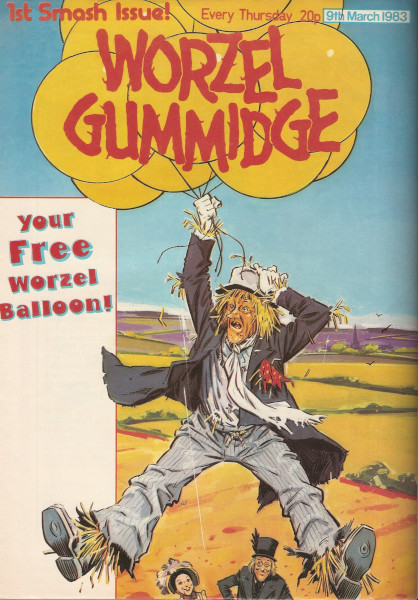 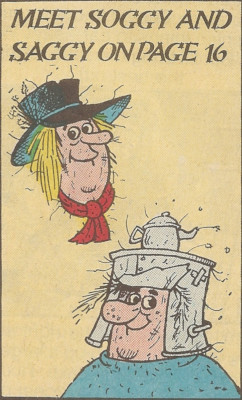 Title/issues:
Worzel Gummdidge#1-? (9th March 1983-?) Title/issues:
Worzel Gummdidge#1-? (9th March 1983-?)
Where: U.K.
Featuring: Soggy and Saggy: #1, others unconfirmed (see
comments)
616?: Unlikely, but not impossible
Summary: Soggy and Saggy are a scarecrow couple who are
secretly alive, unknown to the farmer whose fields they guard.
Reprinted in U.S.?: No
Comments: Soggy and Saggy appeared in a strip in the
first issue of the Worzel Gummidge weekly title (not to be
confused with the monthly magazine of the same name that
immediately preceded it). As licensed title based on the TV series
starring ex-Doctor Who John Pertwee as the living scarecrow Worzel
Gummidge, itself based on a series of children's novels, the main
strips featured the characters from the show, but Soggy and Saggy
were original characters, albeit clearly in the same vein, and per
the indicia they belonged to Marvel (which specified that anything
in the comic not based on the TV show was Marvel property), so in
theory they could be brought back in another Marvel title. As I
only have access to the first issue, I don't know what other
issues, if any, of the 23 issue run they appeared in; since the
covers of #5 mentions a Wind in the Willows strip starting up,
that may well have replaced Soggy and Saggy.
|
|
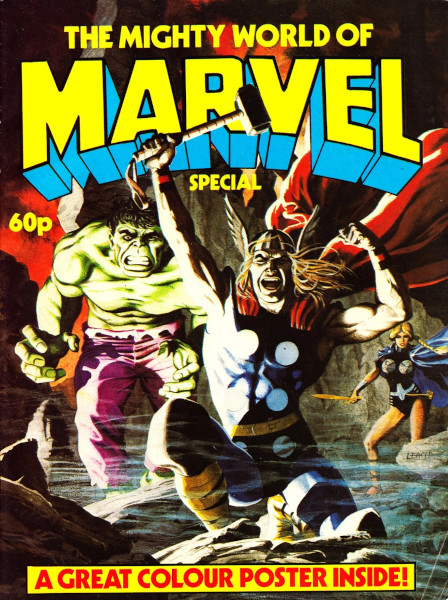 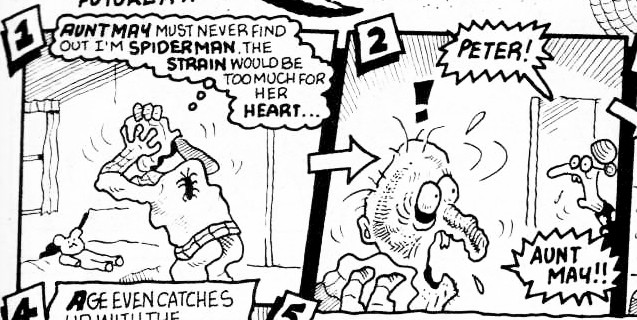 Title/issues:
Mighty World of Marvel Special (1983) Title/issues:
Mighty World of Marvel Special (1983)
Where: U.K.
Featuring: Various
616?: No, probably set on Earth-333333333
Summary: Marvel Heroes When They're 64
Reprinted in U.S.?: No
Comments: A summer special that was mostly reprints, but
which also included a full page Quinn/Howett humor strip.
|
|
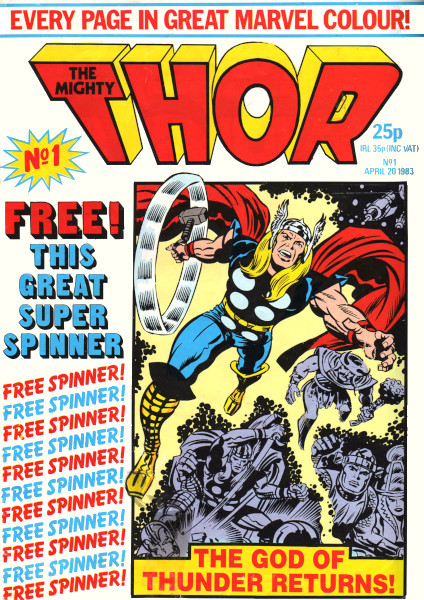 Title/issues:
Mighty Thor#1-19; Mighty Thor and the
X-Men#20-21 (20th April-7th September 1983) Title/issues:
Mighty Thor#1-19; Mighty Thor and the
X-Men#20-21 (20th April-7th September 1983)
Where: U.K.
Featuring:
- Fantastic 400: #1-21
- Earth 33 1/3: #14
616?: No, set on Earth-333333333
Summary: To follow
Reprinted in U.S.?: No
Comments: Thor was the next character to get his own
title in this era of Marvel U.K. Keeping him company were the
Fantastic 400, late of the Fantastic Four weekly. After 19 issues
Thor absorbed the failing Original X-Men title, and only two
issues later the Fantastic 400 ended. Outside of the strip in
Doctor Who Magazine, this also marked the end of new Quinn/Howett
humor strips (though two more titles are listed immediately below,
they came out prior to Thor and the X-Men#21) in Marvel U.K.
titles, at least until the 1990s. There would be some reprints
(notably Earth 33 1/3 in The Thing is Big Ben), and humorous
back-up strips continued, but produced by other creators, most
notably Lew Stringer. It was not the end of Tim Quinn's
involvement at Marvel U.K. however, as he remained active as an
editor, including developing proposals for several new comics.
|
|
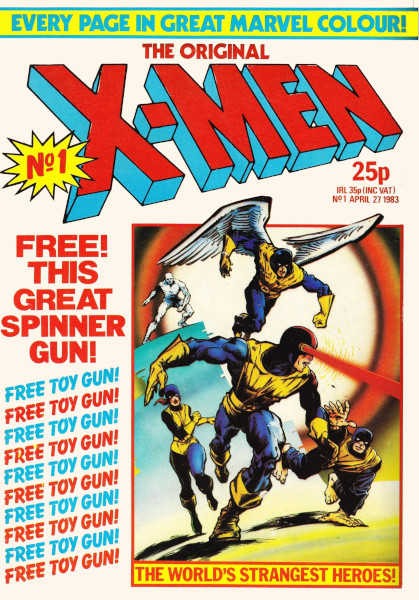 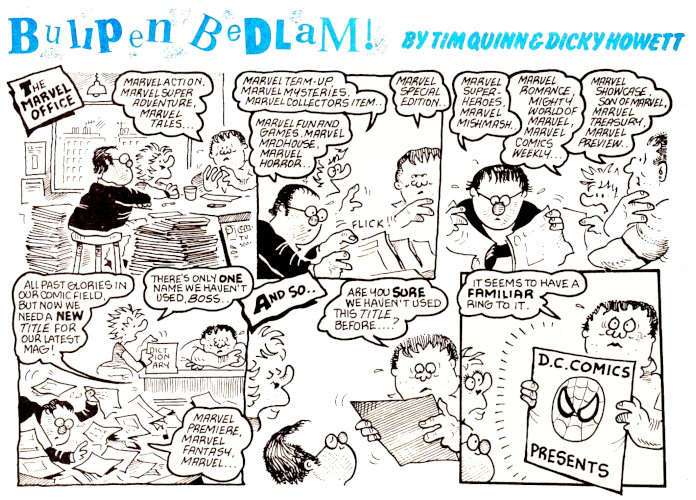 Title/issues:
Original X-Men#1-17 (27th April-17th August
1983) Title/issues:
Original X-Men#1-17 (27th April-17th August
1983)
Where: U.K.
Featuring:
- Bullpen Bedlam: #1-16
- Earth 33 1/3: #17
616?: Earth 33 1/3, no, set on Earth-333333333. Bullpen
Bedlam - probably Earth 333333333, but slim chance of 616.
Summary: To follow
Reprinted in U.S.?: No
Comments: The Original X-Men was the new, and final, home
for Bullpen Bedlam, as well as carrying the last new Earth 33 1/3
installment in its final issue. The end of Bullpen Bedlam was not
however the last the Marvel U.K. staff would find themselves
parodied in one of their own comics, as they'd be supporting cast
in two later strips, Secret Artist and CYRIL, both discussed
below.
|
|
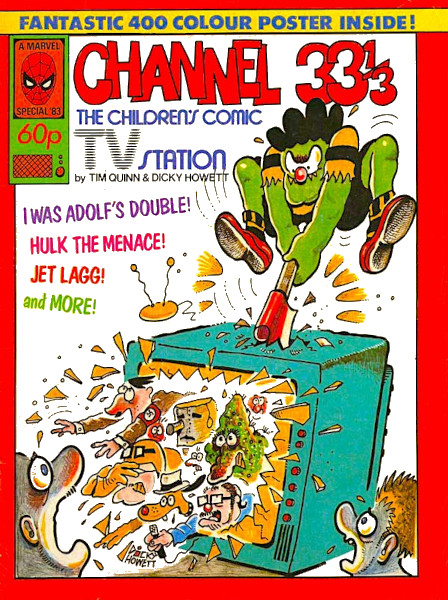 Title/issues:
Channel 33 1/3 (July 1983) Title/issues:
Channel 33 1/3 (July 1983)
Where: U.K.
Featuring: Channel 33 1/3 - The Kid's Comic Station
616?: No, set on Earth-333333333
Summary: To follow
Reprinted in U.S.?: No
Comments: By July 1983 there were enough Quinn/Howett
strips to fill their own special - in fact, the special only had
space to reprint a tiny portion of the strips they had produced,
with a small additional framing strip to introduce the collected
title. The special reprinted the entirety of I Was Adolf''s
Double, the early episodes of Jet Lagg, and a select number of
examples of all the other Quinn/Howett strips.
|
|
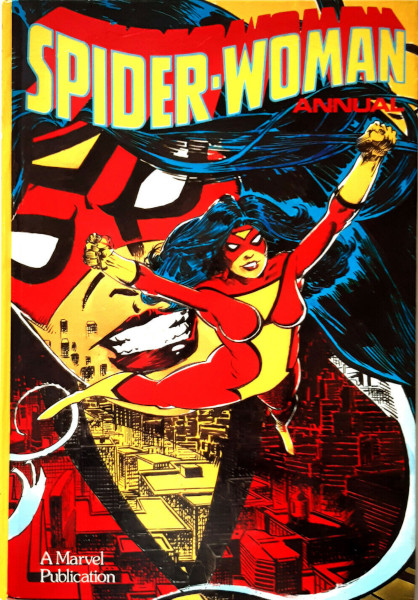 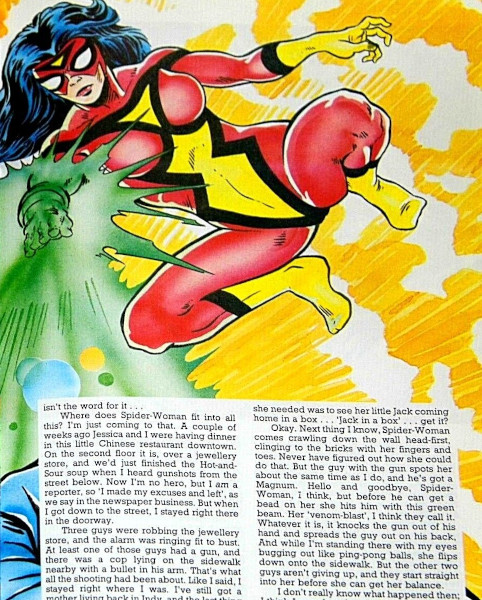 Title/issues:
Spider-Woman Annual 1984 (released 1983) Title/issues:
Spider-Woman Annual 1984 (released 1983)
Where: U.K.
Featuring: Spider-Woman
616?: Potentially
Summary: Inside Story
Reprinted in U.S.?: No
Comments: With the Spider-Woman cartoon having belatedly
made its way to the U.K., in 1983 Grandreams released a
Spider-Woman Annual, and, as they had done for other Marvel
annuals over the last few years prior, it included a new ten-page
text story, Inside Story, by Steve Moore, Jerry Paris and Leigh
Baulch.
|
|
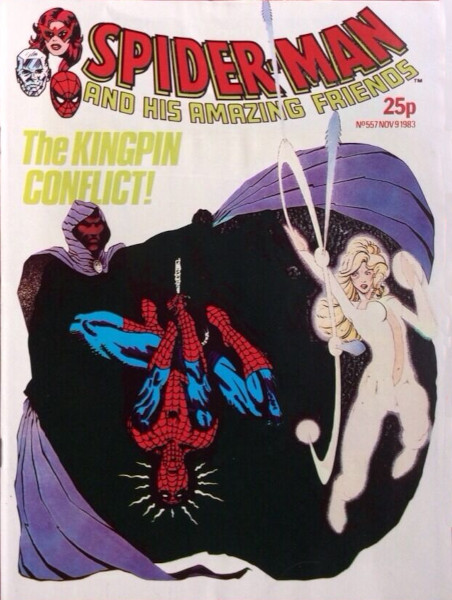 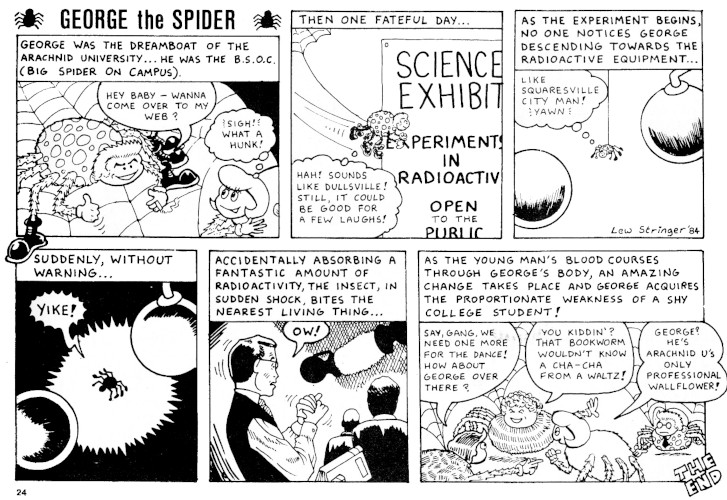 Title/issues:
Spider-Man and His Amazing Friends#557,
569, 578 (9th November 1983-4th April 1984) Title/issues:
Spider-Man and His Amazing Friends#557,
569, 578 (9th November 1983-4th April 1984)
Where: U.K.
Featuring:
616?: Hulk the Menace, no, set on Earth-333333333. What
If?, no, set on Earth-8377. George, no, set on Earth-84632
Summary: To follow
Reprinted in U.S.?: No
Comments: Having previously been titled simply
Spider-Man, on October 12th 1983 with #553, Marvel UK's longest
running title renamed itself Spider-Man and his Amazing Friends in
an attempt to capitalise on the popularity of the cartoon series
of that name which was then airing on British TV. After three
issues reprinting the US comic adaptation of the cartoon's pilot
episode, the ongoing Spider-Man strip reverted to reprinting the
regular US Spider-Man titles, but the Amazing Friends subtitle was
retained. With #567 on January 18th 1984 the comic absorbed
failing sister title Thor and the X-Men, briefly acknowledging the
merger on the cover. The last issue titled Spider-Man and his
Amazing Friends was #578; the next issue the comic renamed itself
back to just Spider-Man.
During this brief run the title carried three humor
strips - the last Hulk the Menace, the last single-panel Lew
Stringer What If?, and a one-off short George the Spider, also by
Lew Stringer.
|
|
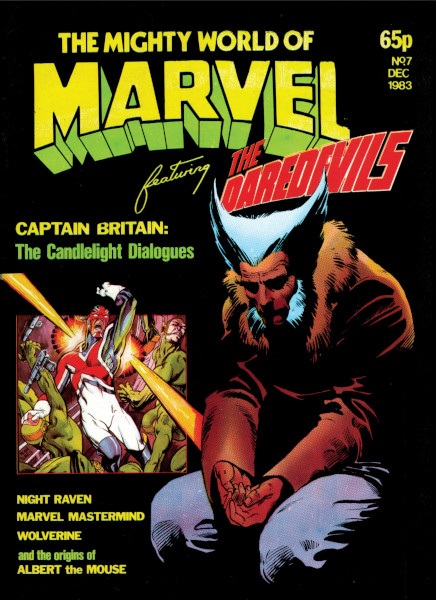 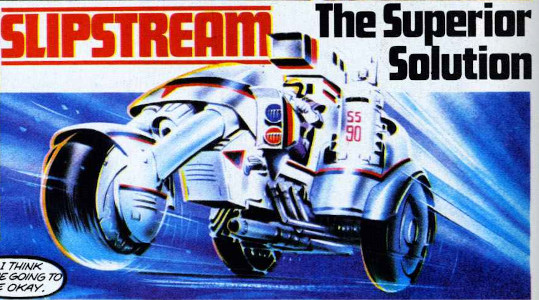 Title/issues: Mighty
World of Marvel#7-17 (December 1983-October 1984) Title/issues: Mighty
World of Marvel#7-17 (December 1983-October 1984)
Where: U.K.
Featuring:
- Captain Britain: #7-16
- Night Raven: #7-17
- What If?: 8-10, 13
- Marvel Comics Work-In: #15
- Marvel Showcase: #7-17
- Slipstream: #7
616?: Captain Britain and Night Raven, yes. All others
set in a variety of alternate realities.
Summary: To follow
Reprinted in U.S.?: Yes
Comments: With the cancellation of The Daredevils and its
merger into The Mighty World of Marvel as of #7 of that title the
two original series, Captain Britain and Night Raven, both
transferred to their new home. Additionally, a new feature, Marvel
Showcase, began running a range of new tales from new comic
creators, some of whom (Mike Collins, Mark Farmer, Kev Hopgood,
etc.) would go on to long term careers in comics. Each issue
Showcase featured a different strip, though two - Right Foot
Backwards and Disenchantment - became recurring tales. Lew
Stringer also continued to produce new humor shorts for the title,
and #7 also carried Slipstream, a fake advert accompanied by a
one-page comic strip, written by Alan Moore and drawn by Steve
Dillon and John Higgins; Slipstream also appeared in some other
Marvel U.K. titles the same month.
Moore finished off his Captain Britain epic in
MWoM#13, handing over the writing duties to the series long time
artist Alan Davis, and swearing off working for Marvel again more
out of ire at their firing of his well-liked editor Bernie Jaye
than their actions against Warrior and Marvelman (though that
probably didn't help). Davis continued Captain Britain's tale
before the strip ended in #16, in preparation for moving to a
brand new Captain Britain title. Night Raven continued to the end
of the run, which proved to be the very next issue; MWoM#17 was
the last issue, and the title merged into (bizarrely) Savage Sword
of Conan.
|
|
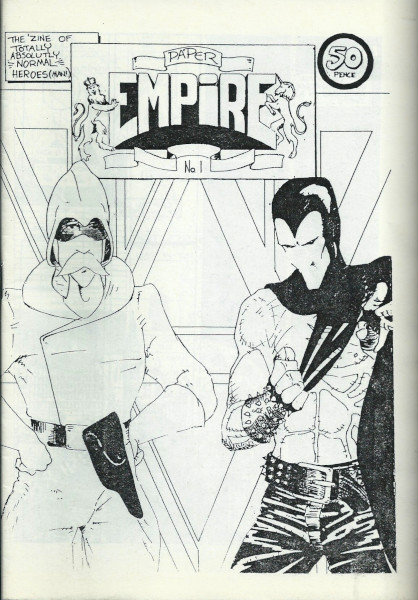 Title/issues:
Paper Empire#1-3 (1984), Captain Empire#4
(1987) Title/issues:
Paper Empire#1-3 (1984), Captain Empire#4
(1987)
Where: U.K.
Featuring: Captain
Empire
616? No, set on Earth-741
Summary: To follow
Reprinted in U.S.?: No
Comments: After first appearing as a cameo
in Captain Britain's strip, Captain Empire got his own story in
the fanzine Paper Empire, written and published by Dominic
Regan. Notably, what elevates this beyond just being fan fiction
is that it was done with Alan Moore's permission. Paper Empire
renamed itself Captain Empire with the fourth issue, which also
proved to be the last, ending his story mid-adventure.
Captain Empire's tale only took up
the first half of each of the first three issues; the second
half was occupied by Peter Coyle's superhero story Black Ice, a
series that had no Marvel connections.
|
|
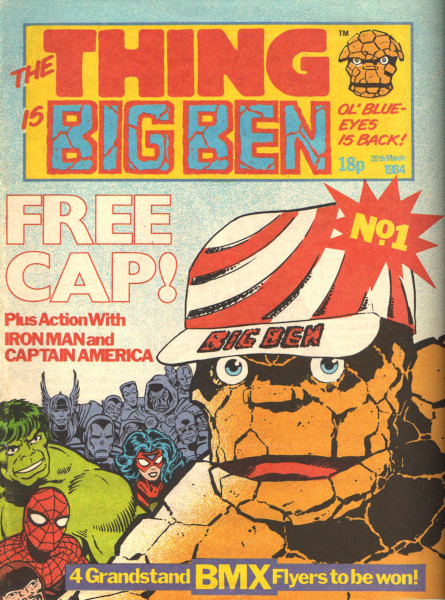 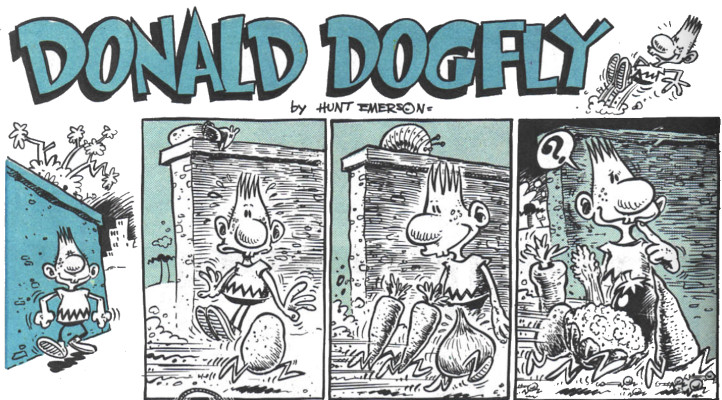 Title/issues:
The Thing is Big Ben#1-12 (28th March-13th June
1984) Title/issues:
The Thing is Big Ben#1-12 (28th March-13th June
1984)
Where: U.K.
Featuring: Donald Dogfly
616?: Probably not, but not impossible
Summary: To follow
Reprinted in U.S.?: No
Comments: The Thing is Big Ben was a weekly title that
reprinted Marvel Two-in-One alongside Iron Man and Captain
America; later issues dropped Cap in favor of Power Man and Iron
Fist. Why the unusual title? Trying to appeal to U.K. audiences by
using the nickname of the famous clocktower? After all, the Thing
isn't normally known as "Big Ben," even if he is admittedly a guy
called Ben who is somewhat large. That allusion was the official
reason for the title, but very few fans had any doubts that the
real reason for the unusual title was that Marvel was messing with
Dez Skinn. At the time this new title emerged, Marvel was in a
dispute with Skinn over Warrior, and specifically the use of a
character with Marvel in his name. Skinn had also introduced his
own superhero Big Ben, and was very open about his hope of
spinning his character off into his own stories, and perhaps even
his own title down the road. So the widespread belief was that
Marvel had released a title with Big Ben mostly to trademark that
name and block Skinn from releasing his own comic.
Alongside the reprint material, the comic had
one new strip, a full page humor tale Donald Dogfly by Hunt
Emerson, which ran for the first 12 issues of the title. The comic
itself lasted for only 18 issues, before merging into (yes, of
course) Spider-Man.
|
|
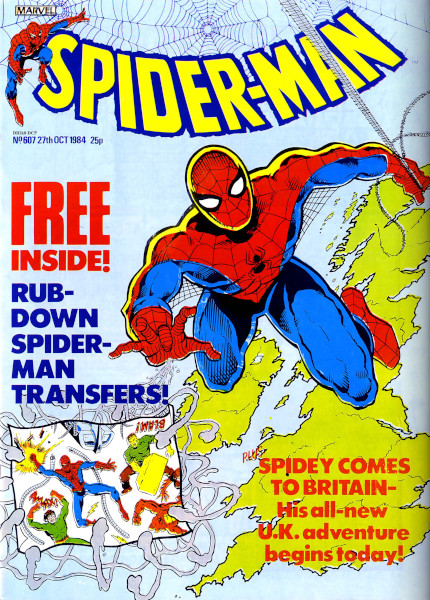 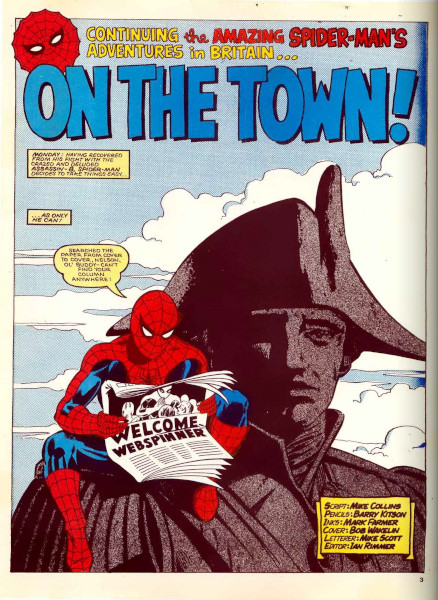 Title/issues:
Spider-Man#607-611 (27th October-24th
November 1984) Title/issues:
Spider-Man#607-611 (27th October-24th
November 1984)
Where: U.K.
Featuring: Spider-Man
616?: Yes. Thunderclap has reappeared in American comics
since debuting in this story.
Summary: To follow
Reprinted in U.S.?: No
Comments: Having most recently gone by the title
Spider-Man and His Amazing Friends, seeking to capitalise on the
popularity of the cartoon of that name, Marvel UK's longest
running title renamed itself simply Spider-Man as of #579,
released 11th April 1984. Spider-Man #595 saw the comic absorb
failing sister title The Thing is Big Ben, briefly acknowledging
this merger on the cover.
While this era of the title included none of the humor
strips that had been prevalent until recently across the Marvel UK
line, it did feature a brand new, multi-part Spider-Man tale.
Apparently worried that British fans might not take well to
Spider-Man's upcoming change to his black costume, editorial
decided to test the waters for new U.K. tales that would keep
Spidey in his original outfit. Thus Mike Collins and Barry Kitson
produced a story where Peter Parker goes to London, and finds
himself battling the cyborg Assassin-8.
This was also the story that introduced the inept hero Thunderclap,
later to return during Marvel U.S.' Civil War storyline. Though
the U.K.-originated story finished in Spider-Man #610, the next
issue's editorial page included "excerpts from Peter Parker's
diary," which provided both additional details about his
departure from London and return home, as well as an update on
Thunderclap's activities while Peter was overseas and a small
amount of new art - so when all is combined, effectively a
minimal additional episode of the story. Plans for any further
new stories were abandoned however when it became clear fans
liked Spider-Man's new black costume.
A few months later, with sales
dropping, the decision was made to refocus the Spider-Man title
towards younger readers, and with #634 the series was rebranded as
The Spider-Man Comic.
|
|
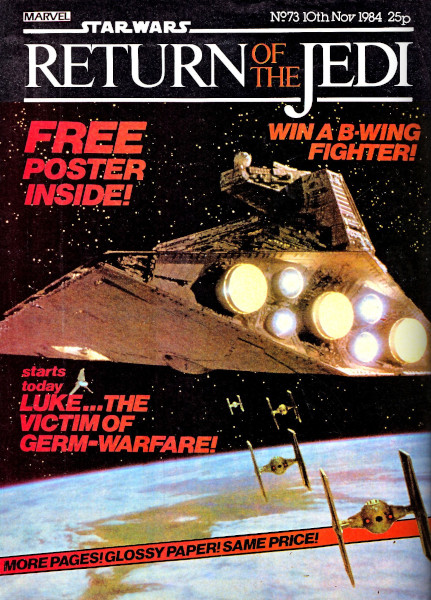 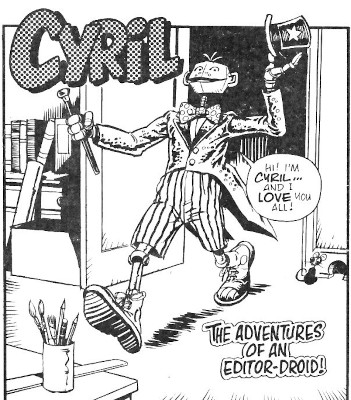 Title/issues: Star
Wars: Return of the Jedi#73-126 (10th November 1984-16th
November 1985) Title/issues: Star
Wars: Return of the Jedi#73-126 (10th November 1984-16th
November 1985)
Where: U.K.
Featuring: CYRIL
616?: Potentially.
Summary: To follow
Reprinted in U.S.?: Yes, in Star Wars: From the UK Vault
Comments: On 10th November Marvel's long-running Star Wars
title added its own humor strip, CYRIL: The Adventures of an
Editing-Droid. CYRIL actually debuted far earlier, in Star
Wars Weekly#41 (15th November 1979), when he began responding to
readers' letters on the title's letters' page; long unseen, he
was finally shown in visual form in Star Wars: Return
of the Jedi#61 (15th August 1984). Finally with #73 he got his
own series, usually consisting of one page at a time, which
depicted his misadventures working in the Marvel U.K. offices
(last seen in Bullpen Bedlam).
As most Star Wars fans know, the UK
Star Wars comic also featured some brand new Star Wars stories,
including some by Alan Moore. Since covering new tales based on
licensed properties would open the floodgates (Marvel UK
produced a lot of licensed titles, and many of them featured
U.K. originated tales - listing them all here would only make
this already extremely long list immeasurably longer), I'm only
covering here any those that featured Marvel characters or new,
non-licensed tales that Marvel might retain ownership of. I may
do a separate Marvel/Lucasfilm list at some point.
|
|
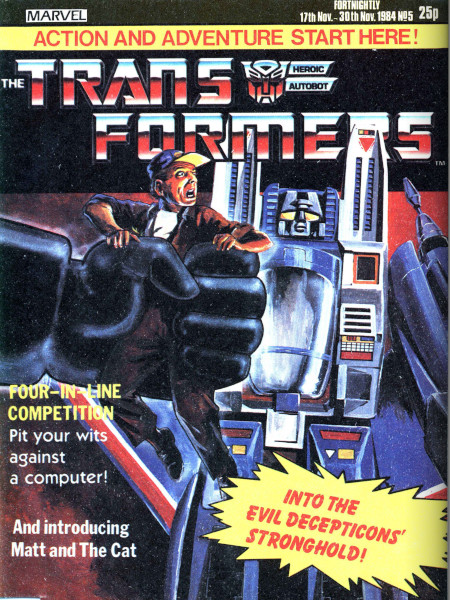 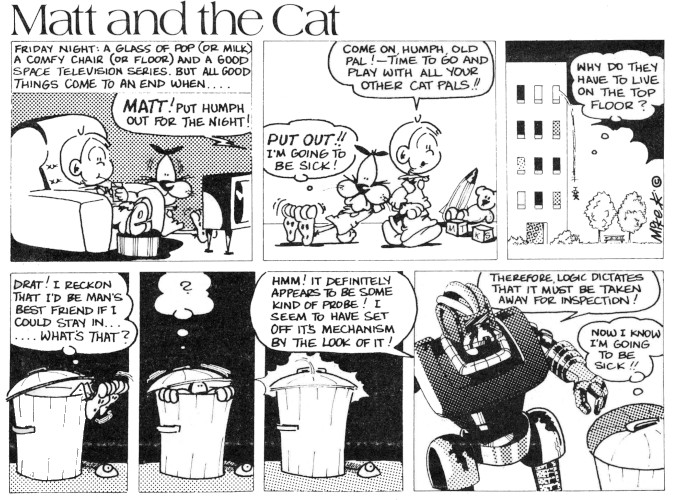 Title/issues:
Transformers#5-79, 81-128, 130-181,
183-193, 195-332 (17th November 1984-18th January 1992) Title/issues:
Transformers#5-79, 81-128, 130-181,
183-193, 195-332 (17th November 1984-18th January 1992)
Where: U.K.
Featuring:
- Chromobots: #12-26
- Circuit-Breaker: #30, 32, 41
- Combat Colin: #153-181, 184-193, 195-332
- Death's Head: #113-114, 117-118, 120, 133
- Matt and the Cat: #5-29, 31-35, 37, 39-59, 61, 64-73
- Robo-Capers: #15-45, 48-57, 59-79, 81-128, 130-152, 183
- Spider-Man: #132
616?: Spider-Man and Combat Colin, probably yes. Circuit
Breaker and Death's Head - their stories here are not in 616, but
CB has a 616 counterpart while DH has visited there. The others -
probably not.
Summary: To follow
Reprinted in U.S.?: Deaths Head and Circuit Breaker - yes.
All others - no.
Comments: Marvel U.K.'s Transformers comic launched on
20th September 1984, only a few months after the U.S. version
(though it too was cover dated September, Marvel Age#17 confirmed
it shipped in April). Thus, as almost anyone with a passing
knowledge of Transformers comics knows, it wasn't long before to
avoid running out of reprint material they had to produce U.K.
material to gain some breathing space and let the U.S. comics get
a lead again. However, since generally I don't intend to list new
stories in licensed comics (because that would open a vast
floodgate), most of those aren't relevant for this page. Instead
I'm sticking to the new material that either contained
Marvel-owned characters or was outwith the Transformers (or any
other licensed) universe.
On the former front, though mostly debuting in
Transformers, both Circuit
Breaker and Death's
Head remain Marvel-owned. Though she
first appeared in U.S. comics, the former had three
appearances in tales that originated in the U.K. comic. As for
Death's Head, all his Transformer appearances were U.K. stories.
Additionally, and somewhat incongruously, #132 also included a
brand new four page Spider-Man story written by Simon Furman and
drawn by Barry Kitson; including no Transformers content, it may
well have been printed in that title simply because by September
1987, the date the story was published, Marvel U.K. no longer had
a regular Spider-Man comic.
Transformers also carried home grown humor/adventure
strips, initially by Mychailo "Mike" Kazybrid, starting with Matt
and the Cat, a humor strip using characters Kazybrid had
originally created for newspaper strips in The Bradford Telegraph
& Argus, and The Manchester Evening News. He later accompanied
this with Chromobots, a robot adventure strip. Matt and the Cat
ultimately had a lengthy run, starting in #5 and ending in #73.
In #15 Lew Stringer introduced his new strip,
Robo-Capers, which lasted an impressive 138 issues, and was only
ended when the Transformers title absorbed Action Force, bringing
with it the latter title's more popular Lew Stringer creation,
Combat Colin, who became a permanent fixture in Transformers until
it was finally cancelled with #332, nearly four years after Colin
came on board.
Though I don't intend to go into any detail (as that
can easily be found elsewhere online, such as the Transformers
wiki), the following issues had UK-originated Transformers
stories: #9-21, 29-32, 41-50, 59-65, 74-88, 93, 96-104, 113-120,
125, 130-153, 160-161, 164-175, 182-189, 198-205, 213-289, 302
|
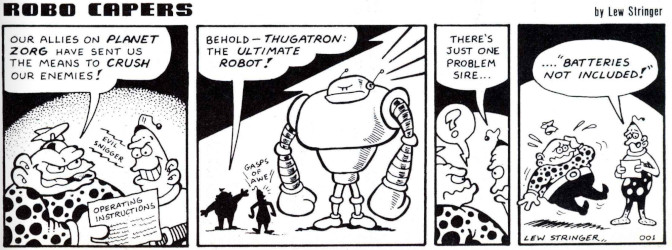
|
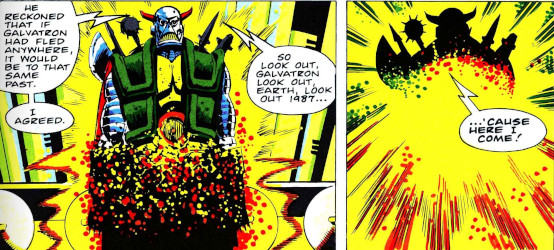
|
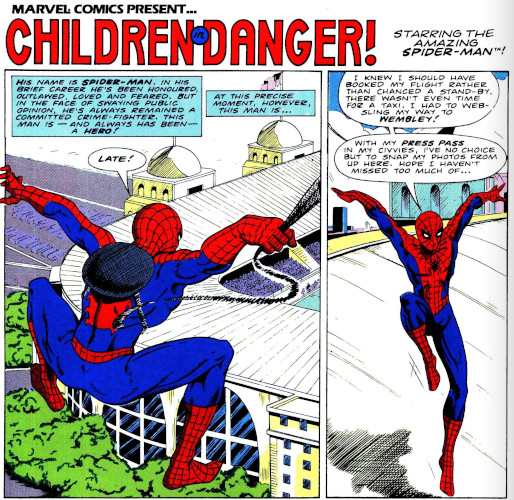
|
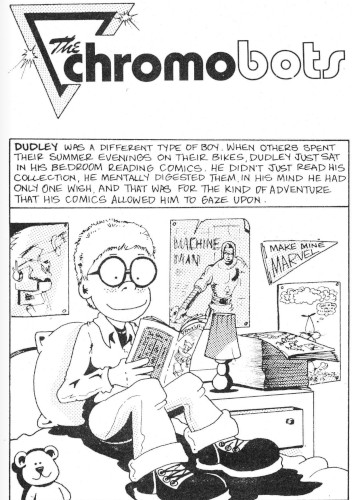 |
|
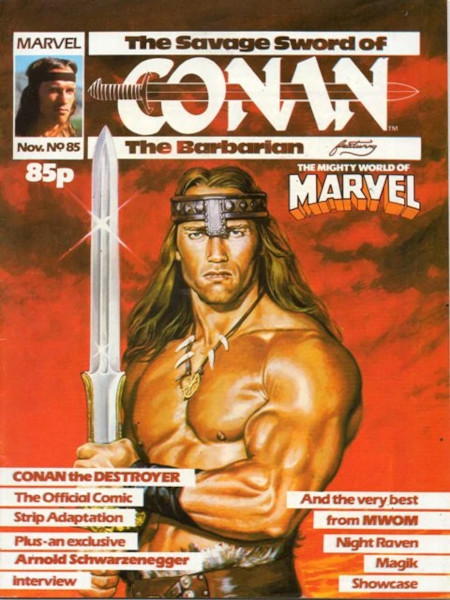 Title/issues:
Savage Sword of Conan#85-93 (November 1984) Title/issues:
Savage Sword of Conan#85-93 (November 1984)
Where: U.K.
Featuring:
- Night Raven: #85-92
- Marvel Showcase: #85-93
616?: Night Raven, yes. Showcase - various non-616
realities.
Summary: To follow
Reprinted in U.S.?: Yes
Comments: In November 1984 the failing Mighty World of
Marvel was merged into Savage Sword of Conan. This was actually
the second British SSoC series, with the first, a weekly launched
in 1975, having only lasted 18 issues before it merged into the
Avengers. The monthly version had launched in November 1977, and
until the merger had solely consisted of reprinted tales. Now it
added the survivors of MWoM - completing a reprint of the Magik
miniseries, and continuing with both the new Night Raven text
stories and Marvel Showcase feature. Because of the identical main
title and the overlapping dates, beware if trying to buy this
online, as from personal experience many online sellers can't seem
to distinguish between the UK and US editions of the magazine,
despite the former clearly having prices in pennies rather than
dollars and cents. SSoC ended with #93, this time not being
absorbed into any other title. Night Raven survived by once again
belatedly following Captain Britain to that worthy's latest home,
but Marvel Showcase came to an end.
|
|
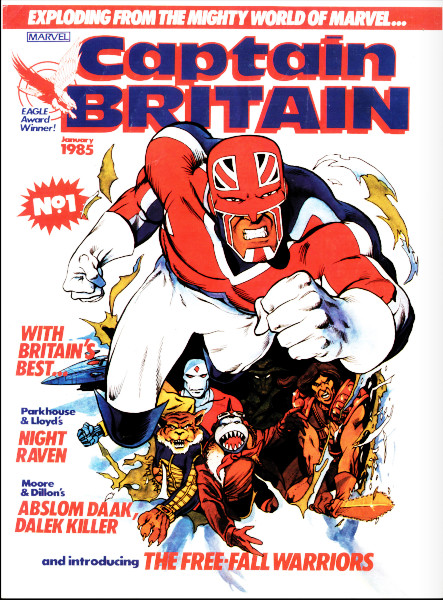 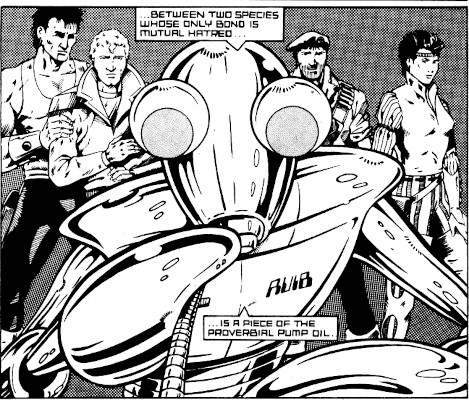 Title/issues:
Captain Britain#1-14 (January
1985-February 1986) Title/issues:
Captain Britain#1-14 (January
1985-February 1986)
Where: U.K.
Featuring:
- Captain Britain: #1-14
- Captain Granbretan: #13
- The Cherubim: #11-14
- City: #5-7
- The Eye Witness: #8
- Freefall Warriors: #1-4
- Night Raven: #10-12
- Paragon of Painthorpe Street: #1-4
- Space Thieves: #5-10
- Thicker Than Water: #9
616?: Captain Britain, Cherubim and Night Raven, yes.
Other stories are set in various non-616 realities.
Summary: To follow
Reprinted in U.S.?: Captain Britain, Captain Granbretan,
Cherubim and Night Raven - yes. All others, no.
Comments: Judging the time was right to give Captain
Britain his own title again, Marvel U.K. launched the new monthly
in January 1985. He shared his first issue with reprints of Abslom
Daak from Doctor Who Weekly and the Night Raven comic strip
from Hulk Comic, as well as a new text story, Paragon
of Painthorpe Street, and a new comic strip based on more
characters who had originated in Doctor Who Monthly, the
interstellar pilots known as the Freefall
Warriors. As Alan Davis' original
draft of the cover reveals, the original
plan for the title had to use reprints of non-Marvel space
hero Jeff Hawke, before changing this to the Warriors. When
Paragon and Freefall Warriors concluded in #4, they were replaced
by new text tale City and new strip Space Thieves. City was
replaced by a string of one issue text tales, most notably the
return of the Night Raven text stories, transferring here after
the cancellation of their last home, Savage Sword of Conan, and
the story of Corps member Captain
Granbretan. Meanwhile Space Thieves was replaced by the
Cherubim, newly introduced Captain Britain characters now spinning
off into their own series.
Sadly sales were too low to sustain the new title,
and so after 14 issues the series ended. There was no merger of
titles this time, and so Captain Britain and Night Raven both
found themselves finally homeless after nearly seven years of more
or less continuous adventures. Captain Britain would return to
comics in the U.S. New Mutants and X-Men Annuals, both written by
his original scribe Chris Claremont, before joining the new
X-affiliate title Excalibur, penned by Claremont and drawn by CB's
long-time artist Alan Davis. Night Raven's time as a mostly text
character had come to an end, and he returned to appearing in
comic format, starting with his own graphic novel, more on which
below.
|
|
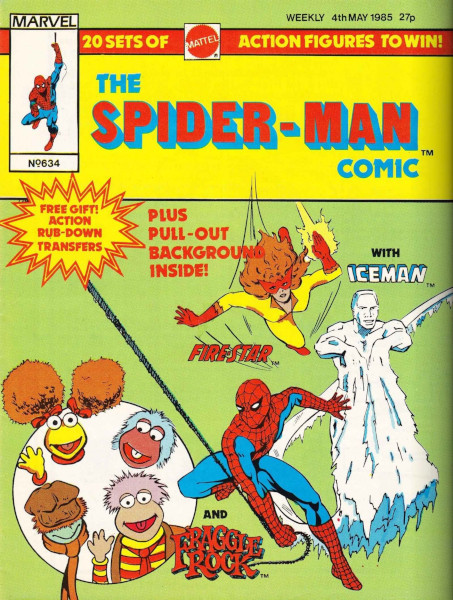 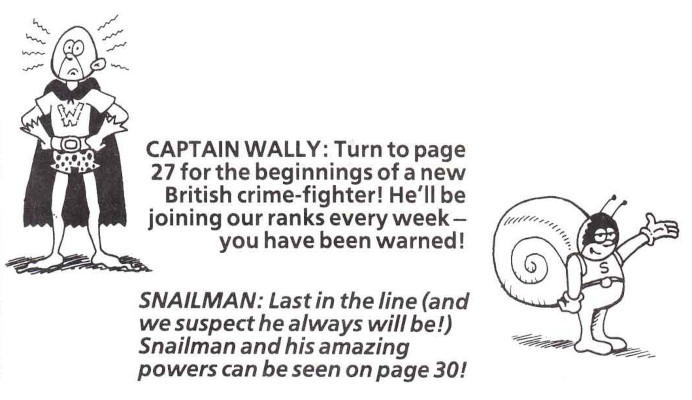 Title/issues:
Spider-Man Comic#634-650 (4th May-24th
August 1985) Title/issues:
Spider-Man Comic#634-650 (4th May-24th
August 1985)
Where: U.K.
Featuring: Captain
Wally, Snailman
616?: Probably yes.
Summary: To follow
Reprinted in U.S.?: No
Comments: With the
long-running British Spider-Man title suffering flagging sales,
it was revamped to attempt to appeal to younger readers. Renamed
The Spider-Man Comic, it had a very
mismatched line-up: initially reprints of Spider-Man from the
Denver Post free giveaway comics and then Spidey Super-Stories
(Electric Company) stories; Star Comics' Wally the Wizard, here
retitled Willy the Wizard, Fraggle Rock, and later first the
Dukes of Hazzard and Further Adventures of Indiana Jones.
Alongside these were two new
superhero humor strips by Lew Stringer: the one-page Captain
Wally and the half-page Snailman. These were firmly rooted in
the Marvel universe; in his first appearance Captain Wally was
inspired to become a crimefighter after reading about Spider-Man
foiling a bank raid, and in #650, the final issue using the
title The Spider-Man Comic, the two heroes enjoyed a crossover
adventure, confirming Snailman to be a Marvel hero too.
With sales apparently still falling,
Spider-Man Comic revamped once more, trying even harder to
appeal to young readers by retitling itself Spidey Comic as of
#651. Both Captain Wally and Snailman survived the revamp, at
least initially - more on which below.
|
|
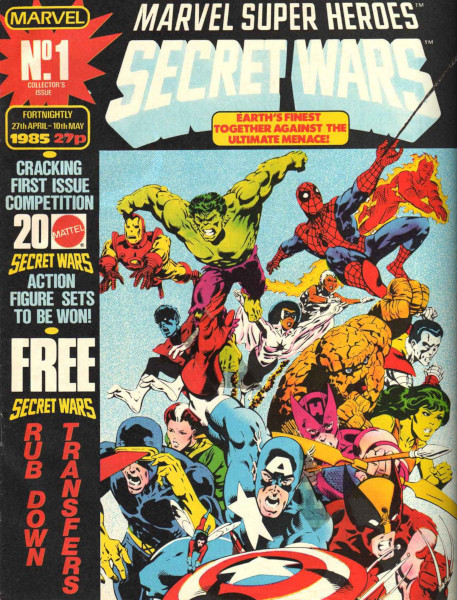 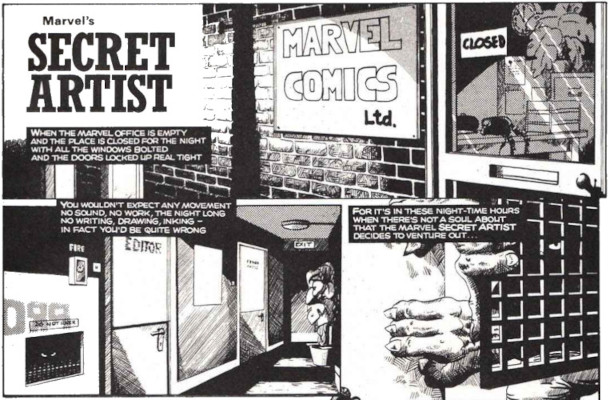 Title/issues:
Marvel Super-Heroes Secret Wars#1-9,
Secret Wars#10, 13-14, 16; Secret Wars featuring Zoids#25; Secret
Wars II#42, 44, 51-53, 58, 63, 67, 69, 75, 79 (27th April 1985-3rd
January 1987) Title/issues:
Marvel Super-Heroes Secret Wars#1-9,
Secret Wars#10, 13-14, 16; Secret Wars featuring Zoids#25; Secret
Wars II#42, 44, 51-53, 58, 63, 67, 69, 75, 79 (27th April 1985-3rd
January 1987)
Where: U.K.
Featuring:
- Secret Artist: #1-10, 13-14, 16
- Spider-Man: #25
- Macho-Man:
#42, 44, 51-53, 58, 63, 67, 69, 75, 79
616?: Probably yes for all.
Summary: To follow
Reprinted in U.S.?: No
Comments: With the release of the massive cross-company
Secret Wars crossover in the U.S., Marvel U.K. launched their own
title to reprint the series and all the tie-in issues.
Accompanying this was a new two page strip, Marvel's Secret
Artist, about a largely unseen gremlin-like being who lived in the
air vents at the Marvel U.K. offices, sneaking out at night to
leave distorted artistic representations of various Marvel
characters. Since CYRIL from the Return of the Jedi strip was also
depicted as working in those same offices, the robot even had a
crossover appearance.
Additionally, to commemorate then Marvel U.S.
Editor-in-Chief Jim Shooter visiting the U.K. and appearing on
Saturday morning children's show The Wide Awake Club alongside
artists Barry Kitson and Mark Farmer, Shooter penned a new three
page Spider-Man story for #25 of Secret Wars, depicting the
web-slinger also visiting the show.
Later, as Secret Wars became Secret Wars II, heralding the
reprinting of the second miniseries (and it's numerous tie-ins), a
new Lew Stringer humor strip began, featuring alien hero
Macho-Man. Unquestionably set in the Marvel universe, it featured
many appearances by "serious" Marvel characters, and the character
would later appear (alongside Snailman and Captain Wally) in
Combat Colin, cementing their shared universe.
|
|
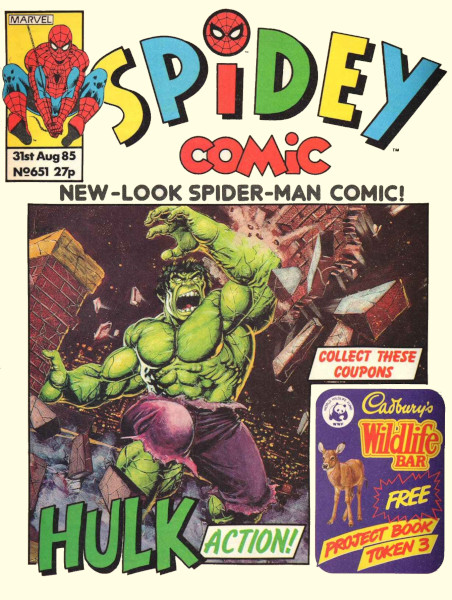 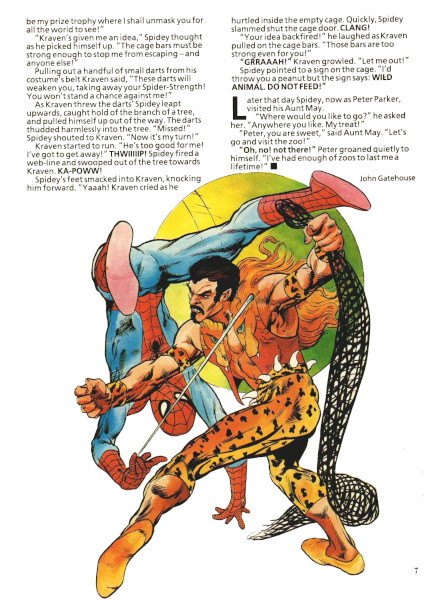 Title/issues:
Spidey Comic#651-660 (31st August-2nd
November 1985) Title/issues:
Spidey Comic#651-660 (31st August-2nd
November 1985)
Where: U.K.
Featuring:
- Captain Wally: 651-653
- Snailman: #651-653
- Spider-Man: #654-660
616?: Probably yes for all.
Summary: To follow
Reprinted in U.S.?: No
Comments: The final incarnation of Marvel
UK's longest running title, and seemingly trying with increasing
desperation to appeal to an ever younger audience given its
abbreviated name and new line-up of strips. Spider-Man's stories
were, in many instances, reprints of Spidey Super Stories, while
other pages were filled with reprints of Star Comics' Ewoks, an
adaptation of Disney's The Black Cauldron, Indiana Jones (from
Marvel's Further Adventures of Indiana Jones), and,
incongruously, The Tough Guys, a translated reprint of French
series Les casseurs - Hauts et Bas à San Francisco by writer and
artist Christian Denayer and writer André-Paul Duchâteau, which
had originally seen publication in Tintin magazine.
Alongside these reprints were the
final three installments of Captain Wally and Snailman. The
issue after they finished, an unheralded new feature began a
brief run, as the next seven issues included new two page
Spider-Man text adventures.
Ultimately the mismatched combination
of strips was not a strong seller, and Spidey Comics was
cancelled on 14th December 1985 with issue 666.
|
|
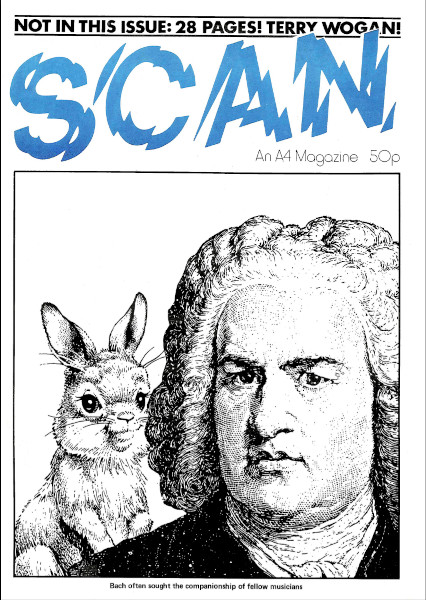 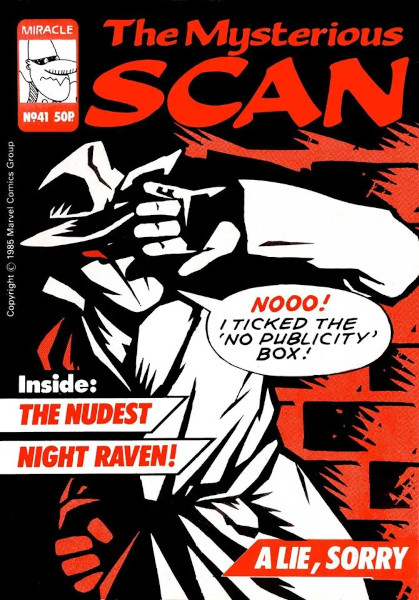 Title/issues:
Scan#39, 41 (1985) Title/issues:
Scan#39, 41 (1985)
Where: U.K.
Featuring: Captain
Babylon
Summary: To follow
616?: No, set on Earth-451
Reprinted in U.S.?: No
Comments: Scan was a fanzine edited by John Freeman.
Though its numbering went as high as #44, there were actually only
thirteen issues. As Freeman noted "We started with #26 and then
jumped all over the place with issue numbers and formats to
bewilder any potential readers." The series is notable on this
list for two reasons: First, in Scan #39 and 41 Freeman wrote two
stories featuring Captain Babylon, a counterpart to Captain
Britain, and second because it was this fanzine that got Freeman
started in comics, leading to him becoming a major writer and
editor in Marvel U.K. only a few years later.
Many of the issues, including the two featuring
Captain Babylon, are available
to read online (with the full permission of those involved
in creating and publishing the zine).
|
|
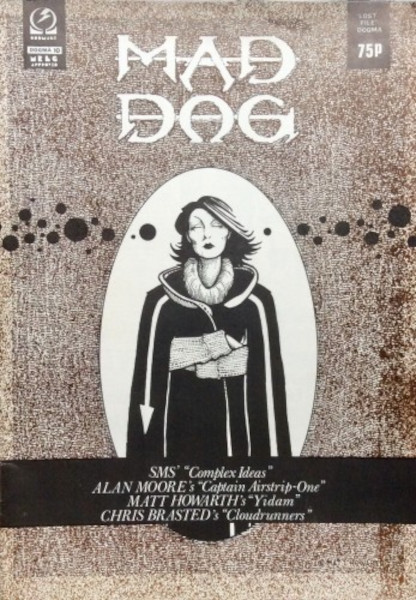 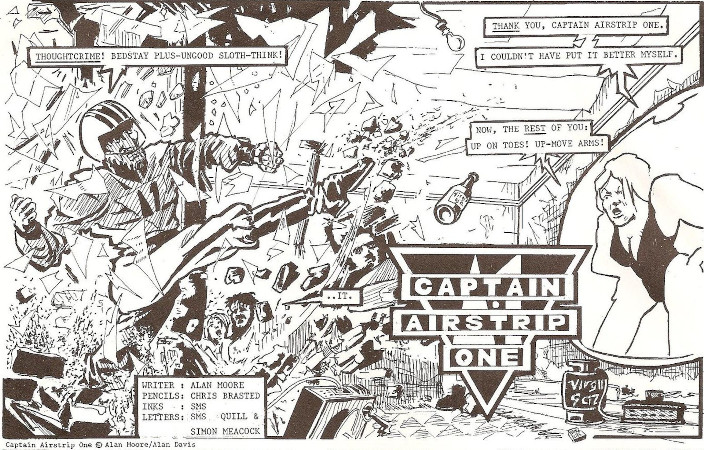 Title/issues:
Mad Dog#10 (1985) Title/issues:
Mad Dog#10 (1985)
Where: U.K.
Featuring: Captain
Airstrip-One
616?: No, set on Earth-744.
Summary: To follow
Reprinted in U.S.?: No
Comments: Another fanzine, Mad Dog#10 was notable because
it included a strip by Alan Moore featuring one of the background
Captains he and Alan Davis had first introduced in Captain
Britain.
|
|
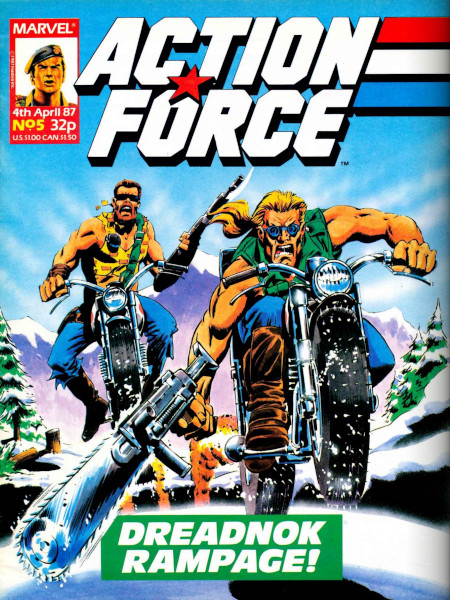 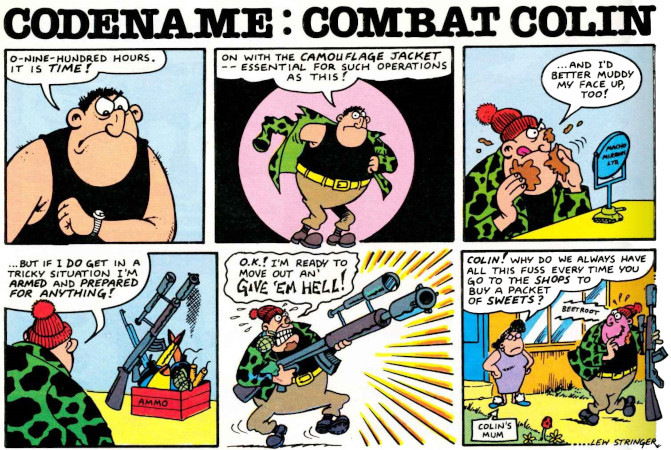 Title/issues: Action
Force#5-20, 22-29, 31-50 (4th April 1987-13th February 1988) Title/issues: Action
Force#5-20, 22-29, 31-50 (4th April 1987-13th February 1988)
Where: U.K.
Featuring:
- Combat Colin: #5-20, 22-29, 31-50
- Shang-Chi: #17
616?: Combat Colin, probably yes. Shang-Chi, no -
this is a version of the character who exists on Action Force/G.I.
Joe's world.
Summary: To follow
Reprinted in U.S.?: No
Comments: In the U.K. the G.I. Joe toys had been marketed
under the less American-centric name of Action Force, and thus the
comics also went by that name. Marvel had not been the first to
print Action Force stories either - that had been the IPC
war-themed title Battle, which had even changed its name to Battle
Action and then Battle Action Force. Starting in 1983 these tales
had an entirely different mythology than the story established in
Marvel's GI Joe comics, with Action Force combating the evil Red
Shadows, led by Baron Ironblood. When, in 1985, the U.K. toys were
repackaged to match the American ones, the story in Battle Action
Force even had Ironblood abandon that identity in the 2nd November
1985 issue to adopt the new title of Cobra Commander, abandoning
his Red Shadows organization which Action Force had decimated to
found its replacement, Cobra. There's an extensive and detailed
site dedicated to the Action Force version of the mythology, the
excellent Blood
for the Baron.
When Marvel gained the license they understandably
kept the title Action Force, hoping to attract fans of the
previous iteration of the comic. Almost immediately to fill the
title new U.K. stories began appearing, but as with other licensed
titles, I'm not tracking here those new tales that only feature
the licensed characters.
From #5 Lew Stringer introduced another of his
comedy strips, Combat Colin. This would become his most prolific
strip, appearing not just in over forty issues of Action Force,
but surviving the title's cancellation and merger into
Transformers, where he garnered over 150 additional stories.
During that lengthy run Colin encountered Marvel heroes including
Spider-Man, battled Marvel villains including Doctor Doom, met
fellow Stringer creations Macho-Man, Captain Wally, Snailman and
Brickman (a character Lew self published outside of any Marvel
title), and the Transformers. When Marvel U.K. shut down, they
gave Lew back ownership of Combat Colin, and Lew has continued to
publish new adventures for him.
Action Force#17 also carried a new story to
introduce readers to Shang-Chi, whose stories were going to be
reprinted as a back-up feature from #18. In this new tale Action
Force martial artist Quick-Kick reminisces about one of the
greatest martial artists he had ever seen, recapping Shang-Chi's
origin and confirming that he'd also encountered Batroc, Iron Fist
and Elektra.
If anyone is trying to track down back issues of
this series, please be aware Marvel U.K. launched a short lived
Action Force Monthly after the weekly was cancelled, so be careful
which one you are purchasing.
|
|
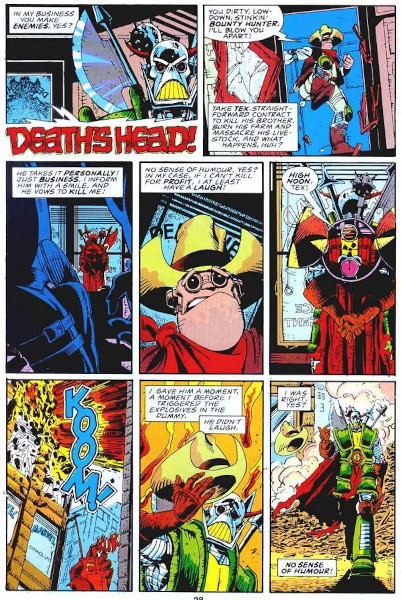 Title/issues:
High Noon Tex (1987) Title/issues:
High Noon Tex (1987)
Where: U.K.
Featuring: Death's Head
616?: No, though DH has since visited 616.
Summary: To follow
Reprinted in U.S.?: Yes
Comments: Since Marvel's contract with Hasbro meant that
any new characters first introduced in Transformers comics would
belong to Hasbro as and when the licensing deal ended, Marvel took
steps to retain the rights to two characters by ensuring they had
been published elsewhere first. In the case of Circuit Breaker,
who appeared in the American version of the title, this meant
introducing her in the pages of Secret Wars II, where she
encountered the Beyonder. In the case of Death's Head, a special
one page strip, High Noon Tex, was created. As Simon Furman
tweeted on 16th March 2022 "High Noon Tex was fast-tracked to make
DH a Marvel character, written on a napkin by me and drawn
overnight by 16-year old Bryan Hitch at a UKAC (UK Comic Art
con)." The strip was later published in various Marvel U.K.
titles.
|
|
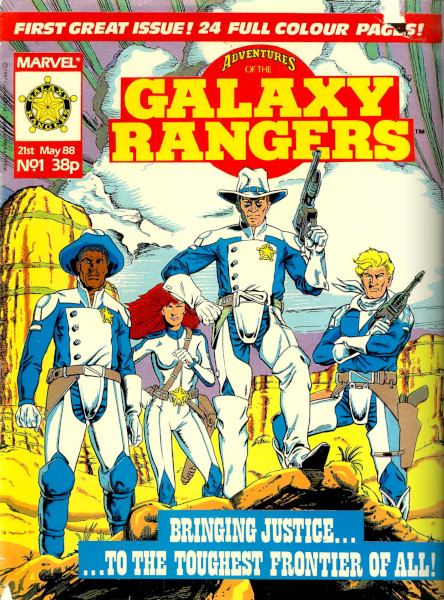 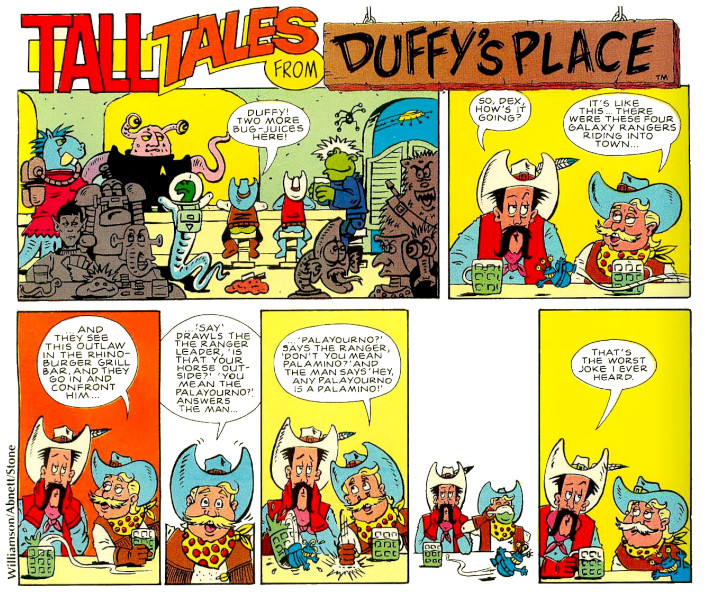 Title/issues:
Adventures of the Galaxy Rangers#1-9 (21st
May-10th September 1988) Title/issues:
Adventures of the Galaxy Rangers#1-9 (21st
May-10th September 1988)
Where: U.K.
Featuring: Tall Tales from Duffy's Place: #1-9
616?: Probably not, but not impossible
Summary: To follow
Reprinted in U.S.?: No
Comments: Another licensed title, Adventures of the Galaxy
Rangers included a new back-up humor strip by Dan Abnett and Brian
Williamson, Tall Tales from Duffy's Place. The comic only lasted
nine issues, merging into Thundercats, and Duffy's Place
transferred there for one final appearance.
|
|
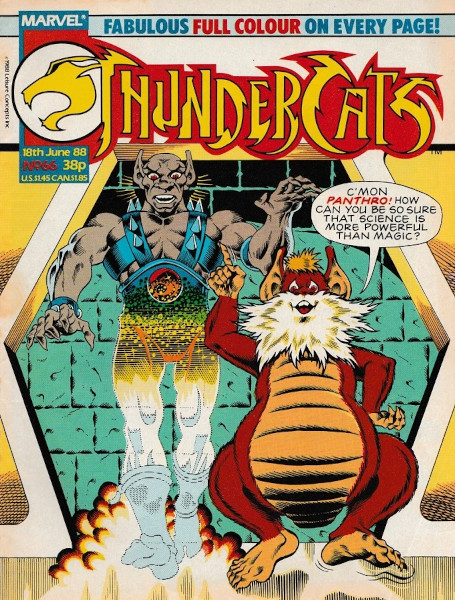 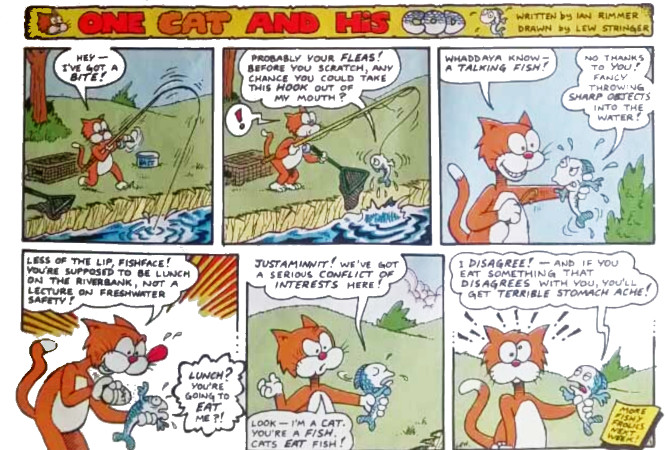 Title/issues:
Thundercats#30-59, 66; Thundercats and
Galaxy Rangers#79 (10th October 1987-17th September 1988) Title/issues:
Thundercats#30-59, 66; Thundercats and
Galaxy Rangers#79 (10th October 1987-17th September 1988)
Where: U.K.
Featuring:
- One Cat and his Cod: #30-59
- Gwanzulum:
#66
- Tall Tales from Duffy's Place: #79
616?: One Cat and Tall Tales - probably not, but not
impossible. Gwanzulum - no, they appeared in the Thundercats'
reality.
Summary: To follow
Reprinted in U.S.?: No
Comments: Another licensed title that produced new
material for the property they licensed, Thundercats also included
an ongoing humor strip, One Cat and his Cod, by Ian Rimmer and Lew
Stringer, plus the last episode of Tall Tales from Duffy's Place
after the title absorbed the failing Galaxy Rangers comic. One
Thundercats story (that I know of) also included a tie to Marvel's
other properties when the titular felines faced the Gwanzulum,
alien shapeshifters who also encountered the Doctor in Doctor Who
Magazine, the Ghostbusters in Real Ghostbusters, and Combat Colin
in Transformers around the same time.
|
|
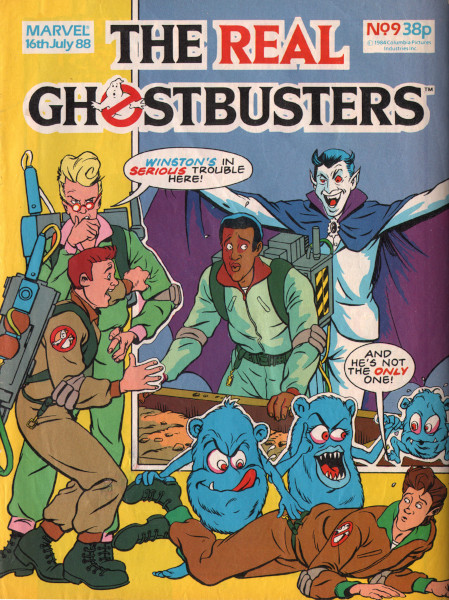 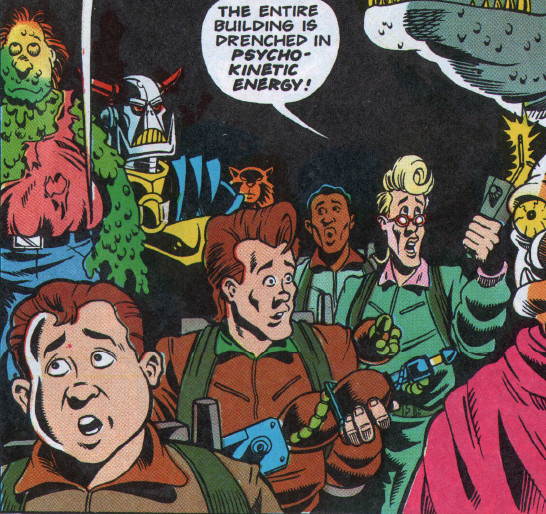 Title/issues:
Real Ghostbusters#9, 42 (16th July 1988-1st
April 1989) Title/issues:
Real Ghostbusters#9, 42 (16th July 1988-1st
April 1989)
Where: U.K.
Featuring:
616?: No, both were present in the Real
Ghostbusters reality. DH was an extradimensional visitor, and the
Gwanzulum likely were too.
Summary: To follow
Reprinted in U.S.?: No.
Comments: Like many of Marvel U.K.'s licensed titles, The
Real Ghostbusters included many new stories of the title
characters that were produced in the U.K. As mentioned above, in
one of these the Ghostbusters encountered the Gwanzulum, providing
a link to the Marvel multiverse since the shapeshifters had also
run into Combat Colin. Another link, albeit only a one-panel
cameo, saw the Ghostbusters investigating a building storing movie
monster props, and standing among those was Death's Head.
Obviously, that could mean he was just another monster
costume/prop, but I prefer to think that the Freelance
Peacekeeping Agent was actually there and just chose to blend in
to avoid the unnecessary complication of dealing with locals armed
with nuclear-powered back pack weapons.
|
|
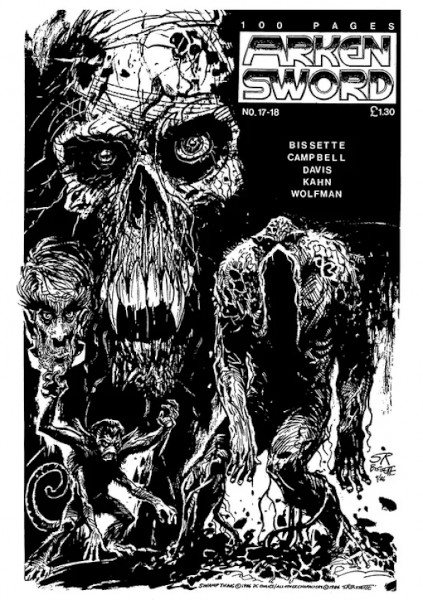 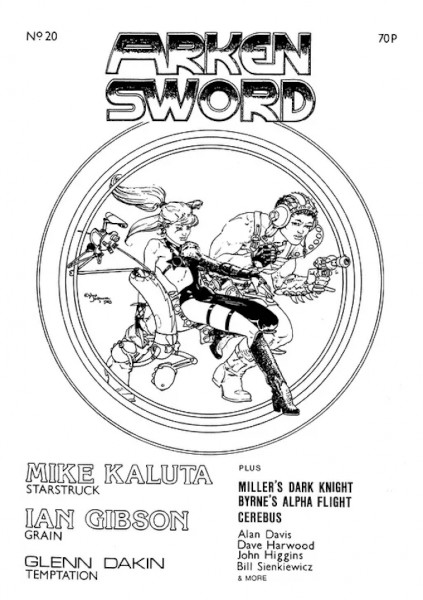 Title/issues:
Arken Sword#17-18, 20 (1987) Title/issues:
Arken Sword#17-18, 20 (1987)
Where: U.K.
Featuring: Captain Britain, Marvelman
616?: No.
Summary: To follow
Reprinted in U.S.?: No
Comments: Arken Sword was a fanzine published by Paul
Duncan that ran from 1980 to 1990, though it abbreviated its name
to just Ark from #24. In the 1987 double issue #17/19 Alan Davis
provided a partially finished story page depicting Captain Britain
and Miracleman facing off against each other, and offered the
original art as a prize for the best script that provided the
story context and finished off the tale in the yet-to-be-drawn
final panel. The winner was Spencer Woodcock, whose story
Devilswrack added in two more characters Alan Davis was known for
drawing, the alien delinquents D.R. and Quinch from 2000A.D.
Richard Starkings lettered the finished page, which was then
published in Arken Sword#20.
|
|
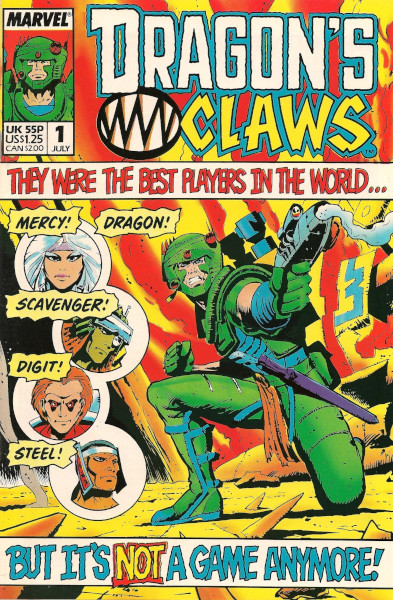 Title/issues:
Dragon's Claws#1-10 (July 1988-April 1989) Title/issues:
Dragon's Claws#1-10 (July 1988-April 1989)
Where: U.K.
Featuring: Dragon's Claws
616?: No, set on Earth-5555
Summary: To follow
Reprinted in U.S.?: Yes
Comments: In 1988 Marvel U.K. began experimenting with
producing comics in the format more common to America - while
exceptions did exist, U.K. comics were most commonly anthology
titles coming out weekly, with black and white interior art and
perhaps a few color pages, and physically larger than their
American cousins. Dragon's Claws, and many of the titles that
followed, were designed to look like American comics, because (as
the cover price information showed) they were intended to also be
sold in the United States alongside American Marvel titles. As
such the covers listed them simply as Marvel comics rather than
Marvel U.K., but despite this they were undeniably British titles
produced in the U.K.
The drive behind these new format titles was new
Marvel U.K. editor Richard Starkings. Per an article by Starkings
in Elephantmen#16, Marvel U.K. had been wanting to produce monthly
titles in the style and formats of their U.S. counterparts for
several years; at one point they thought their best bet was
Captain Britain, but the failure of his 1985 title killed that
hope. However, when Simon Furman and Geoff Senior pitched a
"Science-Fiction Rollerball meets Judge Dredd" series called
Dragon's Teeth, it became the first project to go with the
American format. The name Dragon's Teeth was a nod to the myth
most famously tied to Jason and the Argonauts' quest for the
Golden Fleece, where warriors arise in the spots where teeth taken
from a dragon were planted. However it turned out a small press
comic was already using that name, so at the eleventh hour the
name was changed to Dragon's Claws.
|
|
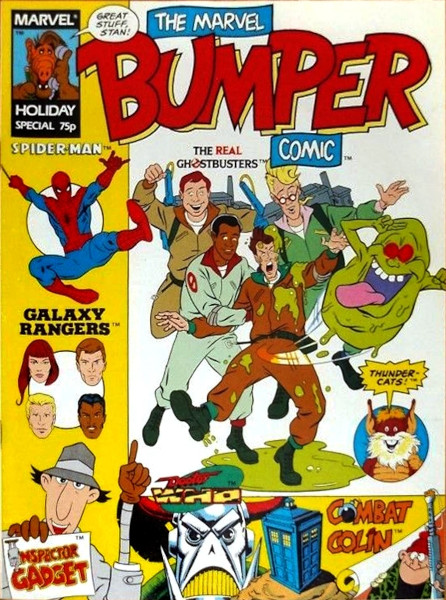 Title/issues:
Marvel Bumper Comic Holiday Special
(Summer 1988) Title/issues:
Marvel Bumper Comic Holiday Special
(Summer 1988)
Where: U.K.
Featuring: Spider-Man
616?: Probably.
Summary: To follow
Reprinted in U.S.?: No
Comments: Though Marvel U.K. was beginning to move towards
publishing comics in American format for the American market, they
continued to produce new titles in the more traditional U.K.
format to be sold in shops on British high streets. One of these
was the Marvel Bumper Comic Holiday Special, a reprint title with
a truly scattershot range of strips (as the cover to the right
shows). The Holiday Special depicted also included a two page
Spider-Man strip, which letterer Gordon "Kid" Robson noted on his
blog had been done "for some promotional purpose or other", but
was later reprinted in the Special. However, I have no
clue where this strip was previously published, if indeed it
actually was; I wouldn't be surprised to learn that it was
intended for promotional use, then got shelved and kept aside as
inventory until finally someone thought to publish it here.
Intriguingly Kid also mentions that there was also a Hulk strip,
but if that ever saw publication I'm unaware of it.
The Special must have sold well, because an ongoing
title was created soon after, as discussed below.
|
|
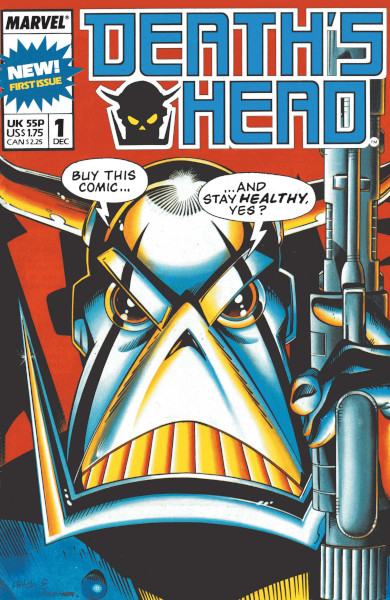 Title/issues:
Death's Head#1-10 (December 1988-September
1989) Title/issues:
Death's Head#1-10 (December 1988-September
1989)
Where: U.K.
Featuring: Death's Head
616?: Among other realities visited.
Summary: To follow
Reprinted in U.S.?: Yes
Comments: The next American format title, giving fan
favorite guest star Death's Head his own series. Again per Richard
Starkings' article in Elephantmen#16, while Marvel U.K. was
working on Dragon's Teeth (as it was then known), they learned
that Marvel's creator-owned Epic imprint was negotiating to
reprint The New Statesman and Third World War, two series that in
the U.K. had appeared in Crisis, a spin-off title from 2000A.D.
and published by Marvel U.K.'s rival IPC. Not wanting to see this
"cross-pollination" with their competitor, Marvel U.K. appealed to
then Marvel president Jim Galton to block the deal, and he agreed
but only on condition that Marvel U.K. produce two new titles to
take their place. Given his popularity, Death's Head was an
obvious choice. The other series was The Sleeze Brothers, detailed
below.
|
|
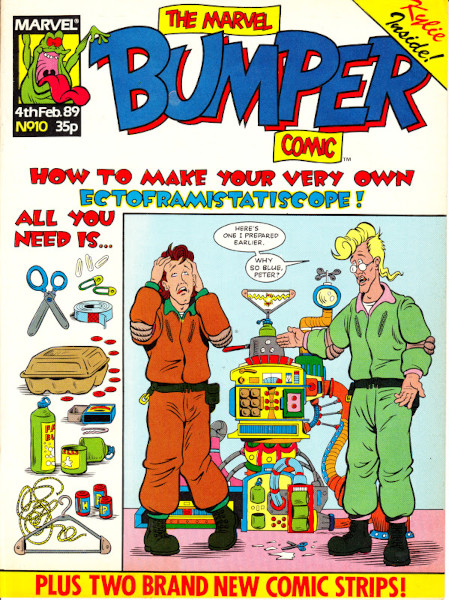 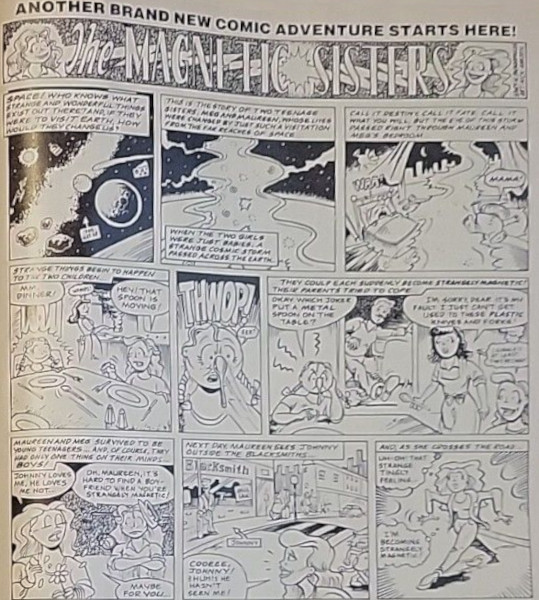 Title/issues:
Marvel Bumper Comic#10-18 (4th February-22nd
April 1989) Title/issues:
Marvel Bumper Comic#10-18 (4th February-22nd
April 1989)
Where: U.K.
Featuring:
- Halibut Square: #10-18
- Magnetic Sisters: #10-12
616?: Magnetic Sisters - doubtful but not impossible.
Halibut Square - no.
Summary: To follow
Reprinted in U.S.?: Yes
Comments: As mentioned above, Marvel Bumper Comic was
launched as a weekly title featuring a range of stories mostly
reprinted from all across Marvel U.K.'s recent output, with
additional reprints of some European sttrips. Doctor Who, Alf,
Real Ghostbusters, Scooby-Doo, Popeye, Combat Colin, Thundercats,
Tom and Jerry, William Tell, Defenders of the Earth, Star Wars'
Droids, France's Souperman and the Hulk all appeared at one point
or another during the series surprisingly long 31 issue run.
In addition to all the reprints, two original humor
strips were included, The Magnetic Sisters, a short-lived series
about twin sisters Maureen and Meg who become magnetically charged
by a strange cosmic storm, and Halibut Square, an anthropomorphic
animal parody of popular U.K. soap Eastenders.
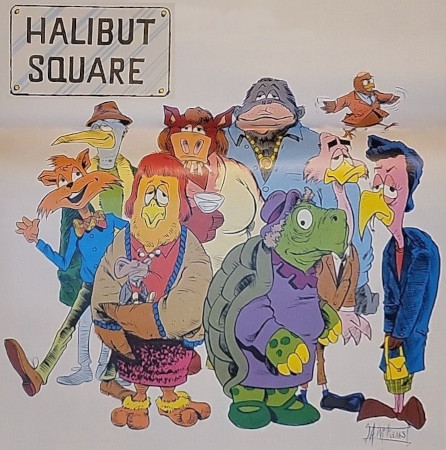
|
|
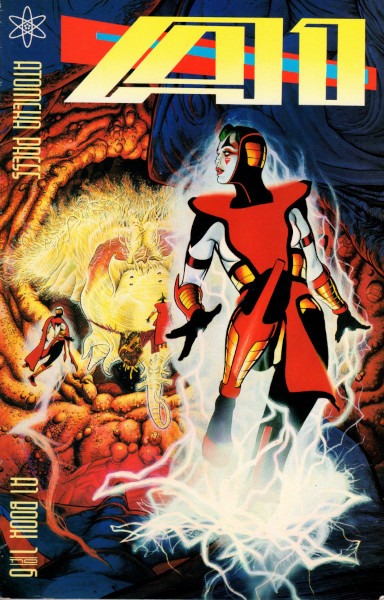 Title/issues:
A1#1 (1989) Title/issues:
A1#1 (1989)
Where: U.K.
Featuring: Warpsmiths
616?: No.
Summary: To follow
Reprinted in U.S.?: Yes
Comments: Published by Atomeka Press, A1 was an anthology
series. The first issue included a Warpsmiths story set between
episodes of Marvelman/Miracleman, and as such it has since been
reprinted by Marvel as part of their Miracleman run.
|
|
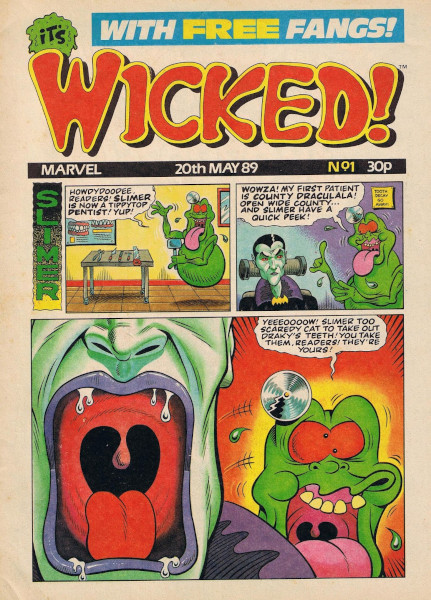 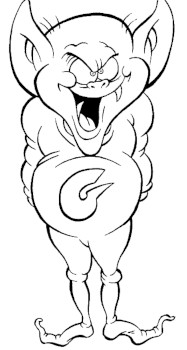 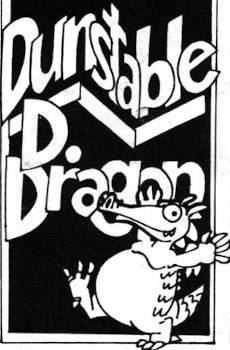 Title/issues: It's
Wicked!#1-17 (20th May-9th September 1989) Title/issues: It's
Wicked!#1-17 (20th May-9th September 1989)
Where: U.K.
Featuring:
- Best of Fiends: #1
- Billy Bones: #10-17
- Burpzilla:
#17
- Clare Voyant: #1-10
- Daily Howl: #15-17
- Dunstable D. Dragon: #1-15
- Ghosthunters: #1-17
- Ghostman
Bat and his Black and White Rat: #1-17
- Ghoul School: #1-3, 5
- Gordon Gremlin: #1-17
- Grotty Lotty: The Schoolgirl Witch: #16-17
- Inspector
Spectre, Private Eye: #1
- It's a Nightmare...a Nursery Nightmare: #4, 6-17
- Mummy's Boy: #1-17
- Toad in the Hole: #1-17
- Were Woof: #6-16
- Wick Ed and his Ectoplasmic Ball: #2
- Winnie the Witch Doctor: #1-4
- Zombears (Night of the Living Ted): #11-14
616?: Potentially yes. There are weirder individuals in
616.
Summary: To follow
Reprinted in U.S.?: No
Comments: Marvel U.K. wasn't just experimenting with
releasing new tales in American formatted comics in 1989. That
same year they published It's Wicked!, a humor anthology title
very much in the mold of the Beano, Dandy or Buster - all
extremely long running British titles from rival publishers DC
Thomson and IPC. Like IPC's Monster Fun from the 1970s, It's
Wicked! was horror-themed, and apart from the headliner, popular
licensed character Slimer from Real Ghostbusters, all the other
strips featured original characters. In keeping with its
forebears, each strip had one to two pages per issue to tell a
short humorous story. An interesting experiment on Marvel U.K.'s
part, and a huge departure from their norm, it only lasted 17
issues. Some of this might have been due to the comic simply not
being as polished as its more experienced rivals, but it's also
fair to say that at the time the British comic market was
contracting - per the excellent Rusty
Staples blog, in 1988 there were around 120 comics being
published in the U.K., but by 1991 that had plummeted 25% to
around 80 titles. There would be a resurgence to 106 titles in
1993 (likely due to the glut of American formatted titles Marvel
U.K. released during that period) before dropping off a cliff
thereafter, as Rusty
Staples' handy infographic shows. Whatever the reason, It's
Wicked! only lasted a few months; unsurprisingly Slimer survived,
and went on to his own title, where he was briefly accompanied by
The Daily Howl (presumably using the remaining episodes that had
already been created prior to the axe falling), while Winnie the
Witch Doctor moved to the next anthology title attempt, the Bog
Paper (see below). As for the rest of the It's Wicked! characters,
they haven't been heard from since.
|
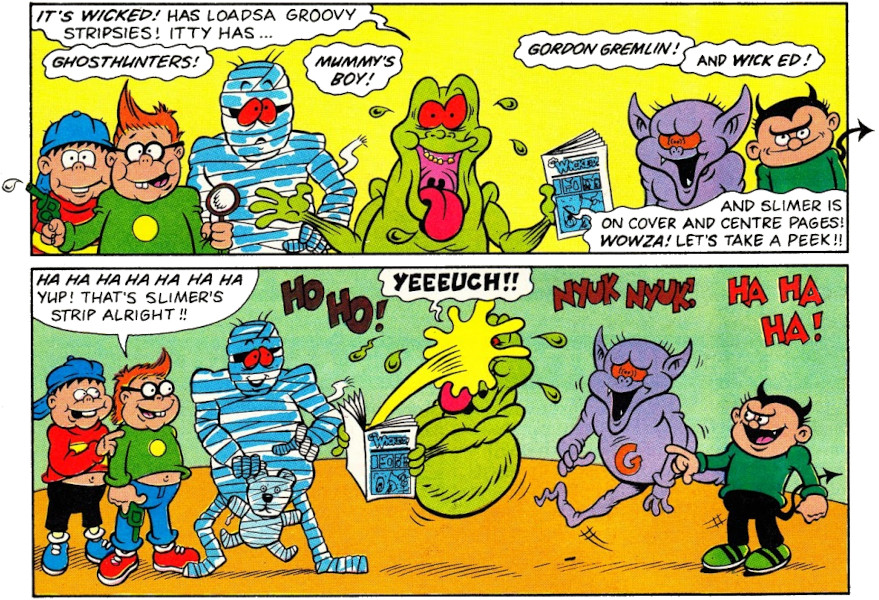
|
|
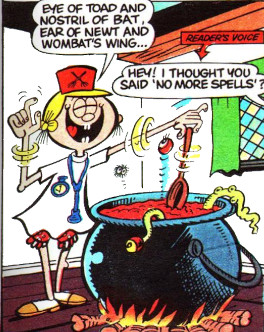
Winnie the Witch Doctor
|
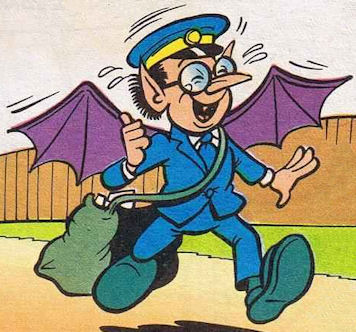
Ghostman Bat
|
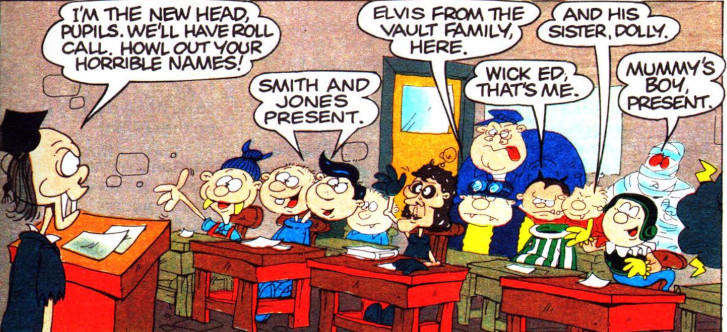
The pupils of Ghoul School - not identified on panel is Doris
Dracula (girl with fangs)
|
|
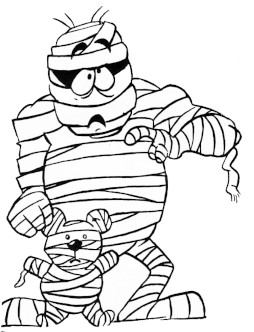
Mummy's Boy
|
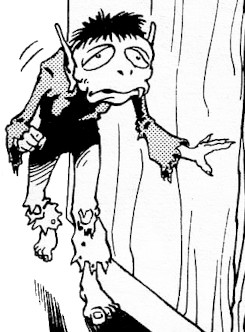
Toad
|
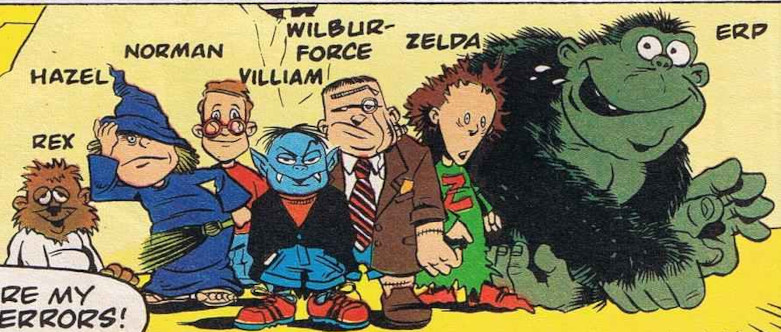
Nursery Nightmares
|
|
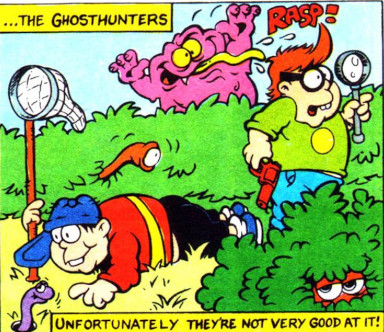
Moe (left) and Joe (right) Mole, the Ghosthunters
|
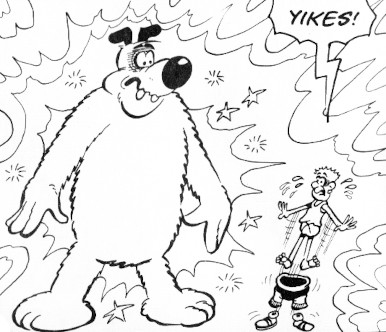
Werewoof
|
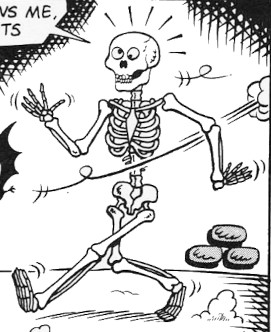
Billy Bones
|
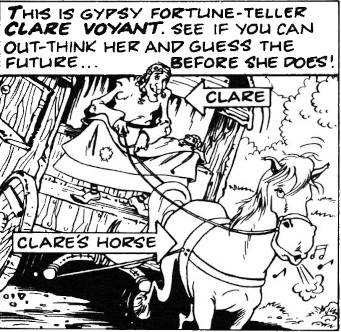
Clare Voyant
|
|
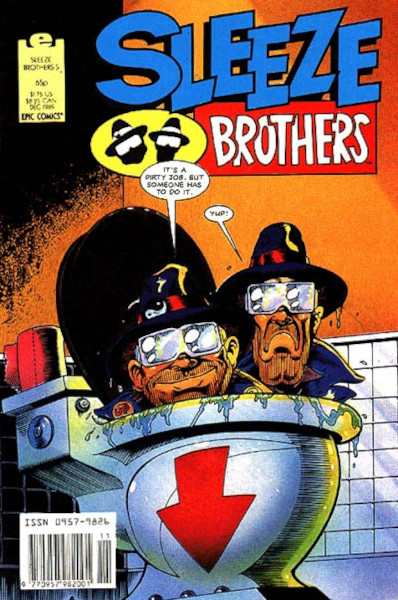 Title/issues:
Sleeze Brothers#1-6 (August 1989-January
1990); Sleeze Brothers: Some Like it Fresh (1991) Title/issues:
Sleeze Brothers#1-6 (August 1989-January
1990); Sleeze Brothers: Some Like it Fresh (1991)
Where: U.K.
Featuring: Sleeze Brothers
(Marvel cameos) Archie Goodwin, Death's Head: #5
Hulk, Namor, Spider-Man, Thing: Some Like it Fresh
616?: No.
Summary: To follow
Reprinted in U.S.?: Yes
Comments: Another of Marvel U.K.'s American format titles,
this one featured the Sleeze Brothers who had previously appeared
as guest stars in Doctor Who Magazine#147. A SciFi take on the
Blues Brothers, private investigators el Ape and Deadbeat were
created by writer John Carnell and artist Andy Lanning, the latter
of whom loaded the background of many scenes with guest cameos
including Daleks and Sontarans from Doctor Who, Judge Dredd,
Freddy Krueger, Concrete, Judah Macabee and a Head from Nexus, the
Lost in Space Robot, D.R. (of D.R. and Quinch), Middenface
McNulty, Cerebus the Aardvark, Rorschach, Roachmill, the Spirit,
Spock; Bungle, Zippy and George from British children's TV show
Rainbow; Alien Xenomorphs, Slimer, Thanagarian Hawkmen, Martial
Law, the Mekon,
Charlie Brown, Fat Freddy Freak, Hard Boiled's Nixon, and,
importantly for the Marvel connection, Archie Goodwin (the real
world editor's comic counterpart often seen in Marvel Fanfare),
Death's Head, Hulk, Namor, Spider-Man and the Thing.
After the initial six issue miniseries finished its
run a one shot followed in 1991. Originally intended as a Marvel
U.K. title, thanks to the assistance of Epic editor Archie Goodwin
it was instead published as the first (and as it turned out, last)
Epic UK title, meaning that the rights to the characters reverted
back to Carnell and Lanning in the mid-90s. As a result, the
Sleeze Brothers also made appearances in Epic#2 and Image's
Elephantmen#16.
|
|
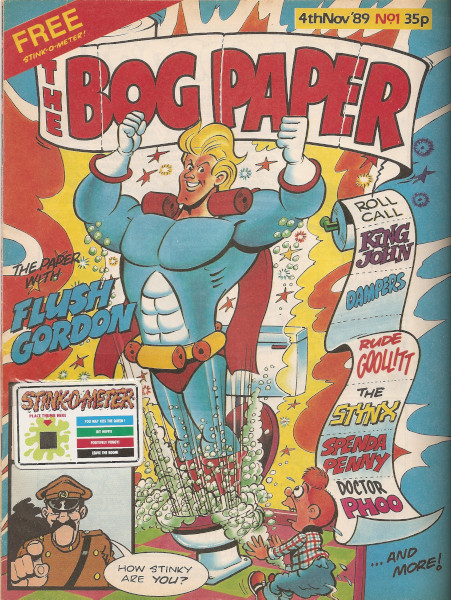 Title/issues:
Bog Paper#1-11 (4th November 1989-13th January
1990) Title/issues:
Bog Paper#1-11 (4th November 1989-13th January
1990)
Where: U.K.
Featuring:
- Anty: #1-11
- Chicken Vindaloo: #1-11
- Dampers: #1-6, 8-11
- Doctor Phoo: #1-11
- Flush Gordon: #1-11
- The Gents: #1-11
- King John: #1-11
- Roystone Roylette: #1-11
- Rude Goollitt: #1-11
- Spenda Penny: #1-11
- The Stynx: #1-11
- Super 'Lu: #1-11
- Winnie the Witch Doctor: #1-11
616?: I'd like to say definitely no, but there's honestly
nothing in the stories that precludes the characters existing in
616..
Summary: To follow
Reprinted in U.S.?: No
Comments: Marvel U.K.'s next attempt at an original humor
anthology weekly was The Bog Paper. As the title suggests, the
theme of this comic, such as it was, was toilet humor. I assume
they hoped to tap into the same market that had made the extremely
crude Viz comic (not a Marvel title) a success a few years
earlier, but the trouble seems to be that the title was still
aimed at children, not the older teens and young adults who bought
Viz. Meanwhile younger kids might find toilet humor funny, but an
entire comic devoted to it was probably too much even for them.
And as for parents who might be checking the shop shelves looking
for a comic to keep their kids quiet, this wasn't going to be
anyone's first choice. Perhaps unsurprisingly it only lasted
eleven weeks before being cancelled. Its poor showing had a knock
on effect for future Marvel U.K. titles - as Tim Quinn noted
in an article on Down The Tubes "When I joined the company,
I was keen to attempt to put together a humour title, but because
of the sales figures on The Bog Paper a few years earlier, it was
decided that humour didn't sell."
During its eleven week run the comic's line-up
remained steady, with only one series, Dampers, skipping a single
issue. Those strips were:
- Flush Gordon, an alien superhero who lived in the sewage pipes
and emerged from toilets.
- Rude Goollitt, an obnoxious soccer player with excessive
flatulence - his name is a play on real life Dutch soccer player
Ruud Gullit
- The Gents, two "toilet gremlins" who looked like the male
figure used on doors to denote men's toilets, and who played
nasty tricks on those who tried to use the facilities
- Anty, a boy with a long, prehensile tongue
- Dampers, an infant with a potty obsession
- Doctor Phoo, a Doctor Who parody who traveled across time and
space in an outhouse.
- King John, recounting the feud between King John and Robin
Hood with toilet humor shoehorned in.
- Winnie the Witch Doctor, a survivor from the previous humor
title, It's Wicked!
- Chicken Vindaloo, an anthropomorphic chicken trying to avoid
becoming someone's dinner
- The Stynx, an extremely smelly Egyptian
- Super 'Lu, a young girl who transforms into a superhero by
eating lots of beans...
- Spenda Penny, a young girl obsessed with checking out other
people's bathrooms.
- Royston Roylette, a boy who always ends up buying new toilets
no matter what errand he's actually meant to be on.
|
|
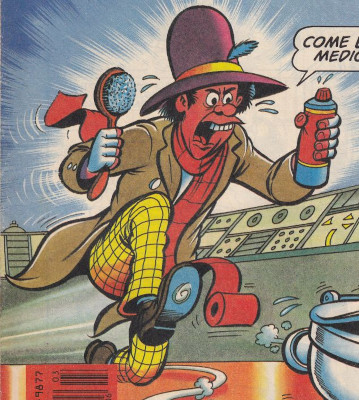
Doctor Phoo
|
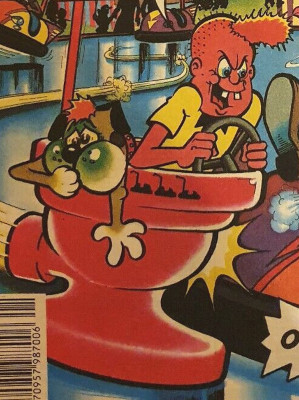
Royston Roylette
|
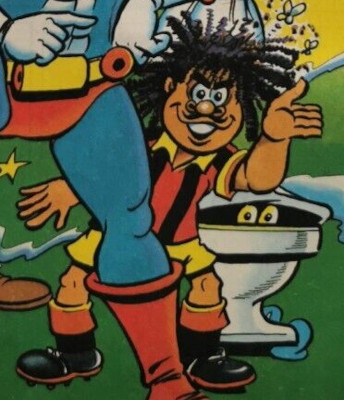
Rude Goollitt
|
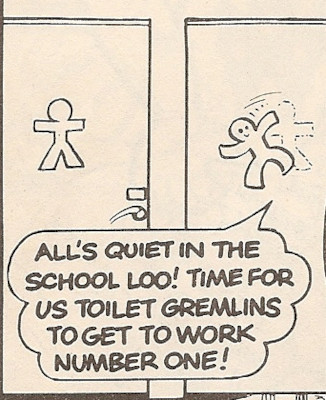
The Gents
|
|
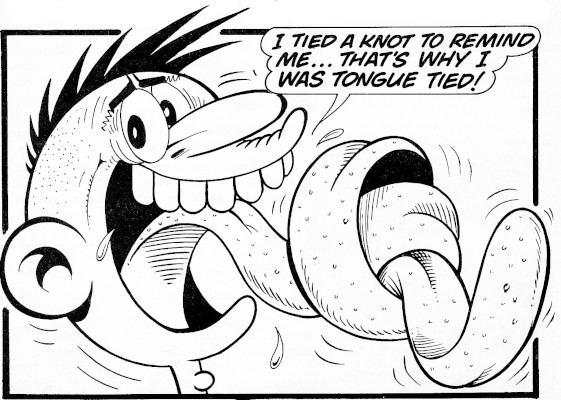
Anty
|
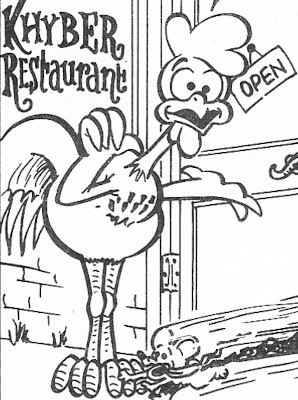
Chicken Vindaloo
|
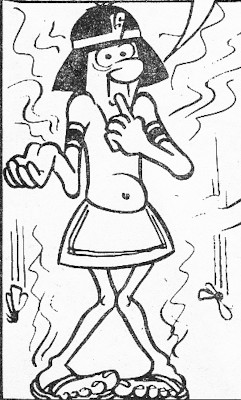
The Stynx
|
|
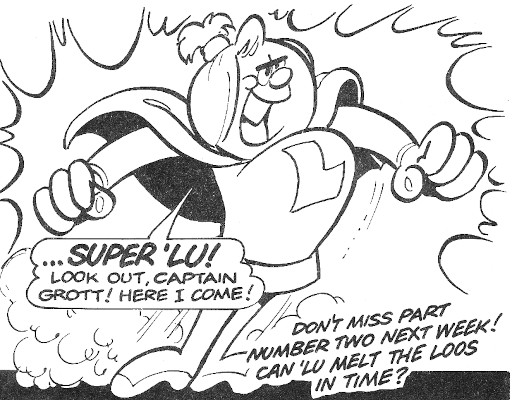
Super 'Lu
|
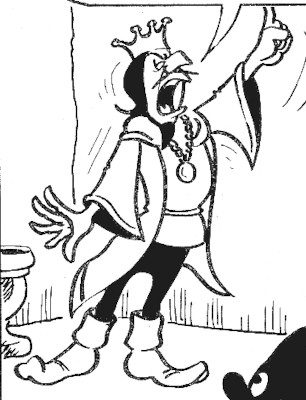
King John
|
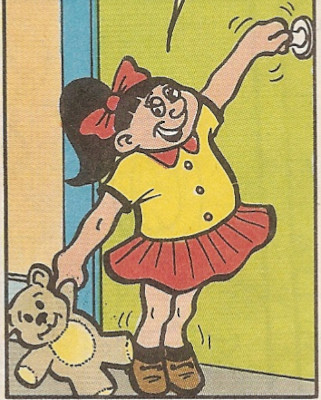
Spenda Penny
|
|
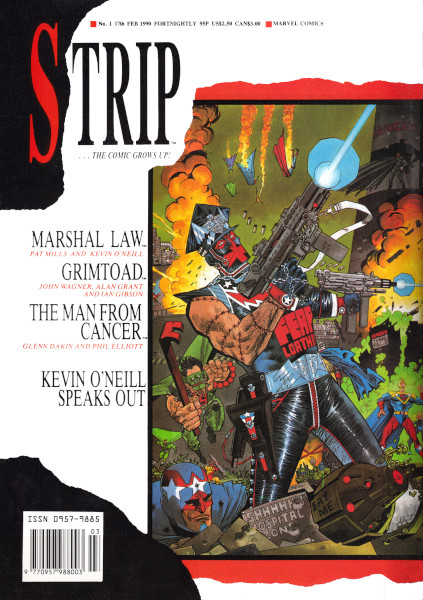 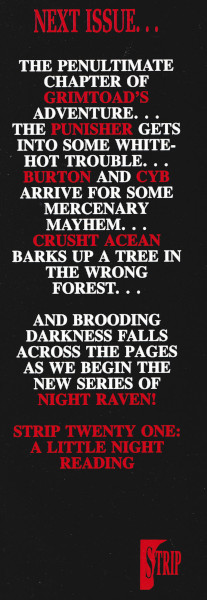 Title/issues: Strip#1-20
(17th February-10th November 1990) Title/issues: Strip#1-20
(17th February-10th November 1990)
Where: U.K.
Featuring:
- Chronicles of Genghis
Grimtoad: #1-20
- Collector's Item: #11
- Combat
Wombat: #13
- Death's Head: #13-20
- Dexter Pantry: #15
- Eight Miles High: #3
- Ephraim, Utah: #8
- Flatman: #20
- Incognito: #1
- Jazz Renegades: #6
- Jenny Styrene: #10
- Job for the Boys: #5
- Man from Cancer: #1-2, 9-11, 16-20
- Profane: #7
Stalking: #14
- The Wand: #4
- Wrong Bros: #12
616?: No. Various alternate realities.
Summary: To follow
Reprinted in U.S.?: Grimtoad and Death's Head, yes.
Others, no.
Comments: Edited by Dan Abnett, Strip was a fortnightly
anthology aimed at older readers, with almost all strips within
being creator-owned. Some strips within were reprints: Though
creators Pat Mills and Kevin O'Neill were both British, Marshal
Law (#1-12) had first been published by Marvel U.S.' Epic imprint;
British art legend Don Lawrence's Storm (#2-7, 14-19) had been
published in the Netherlands; Viking (and secretly part alien)
warrior Thorgal (#8-13) was a Franco-Belgian series that had first
appeared in Tintin magazine; On the Road Again (#9), Wolfram
(#12-13, 18-19), Planetfall (#14-15) and Kyballium Odyssey
(#16-17) were French stories by Eric Puech; and the last four
issues included colorized reprints of early Punisher magazine
stories.
The only story to appear in every one of Strip's 20
issue run, The Chronicles of Genghis Grimtoad, wasn't entirely a
new story, but nor was it a reprint; it had originally begun
running in the short-lived IPC magazine Look Alive. As a result
the first five parts had already appeared, but for Strip they were
redrawn from scratch by Ian Gibson. Strip's cancellation meant the
tale was curtailed two episodes before the epic's end, but the
subsequent graphic novel (see below) included those missing
installments, finally completing the story. The next most prolific
series, Glenn Dakin and Phil Elliott's Man from Cancer told the
surreal adventures of anthropomorphic crab detective Crusht Acean,
while Death's Head came on board to replace Marshal Law as of #13,
in a story later collectd in the graphic novel The Body in
Question. The remaining stories were all single issue one-shots,
many of them "twist in the tale" types, but some introduced new
characters who might potentially have come back for return
engagements had Strip lasted a bit longer. The Wand starred John
Freeman and Liam Sharpe's Rourke of the Radlands, who might be
described as "Red Sonja if she lived in a post-apocalyptic world
where technology was mostly forgotten and now treated like magic."
Prior to Marvel U.K. going bust in the 1990s there were plans
afoot to team her up with Wolverine and Monark
Starstalker. Though that fell through, Rourke has resurfaced
for adventures in the British digital comic anthology 100%
Biodegradable in the tales "Death Duty" and "Skow Dogs."
Another one-shot, Jazz Renegades in "Out o' the
Blue" introduced a fugitive band determined to bring uplifting
tunes to worlds where only gloom was permitted,while Jenny Styrene
was a troubleshooter in a dystopian world ruled by the dictatorial
Railways, Combat Wombat was an anthropomorphic mercenary, and
Dexter Pantry of the CIA (Catering Investigation Authority) was
the world's top food-crime detective.
The axe falling with #20 clearly came with minimal
notice, as that issue included an ad encouraging readers to
subscribe to "the next 26 issues of Strip" and a next issue blurb
explaining that two new strips were starting in #21: Burton and
Cyb (a reprinted Spanish series) and Night Raven: House of Cards.
|
|
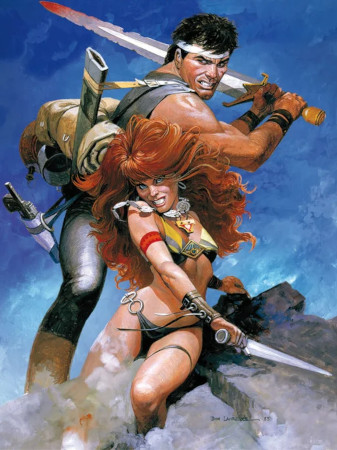
Don Lawrence's Storm (and Ember)
|
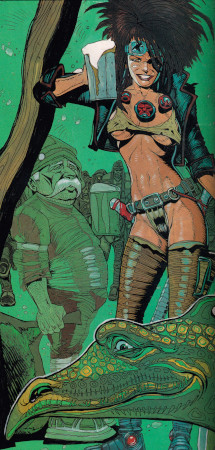
Rourke of the Radlands
|
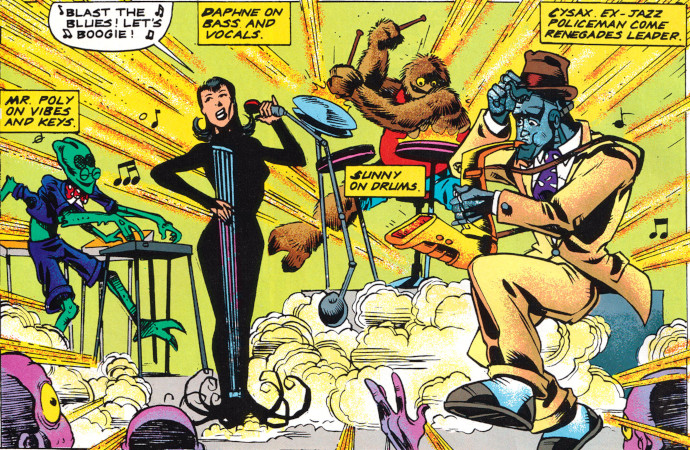
Jazz Renegades
|
|
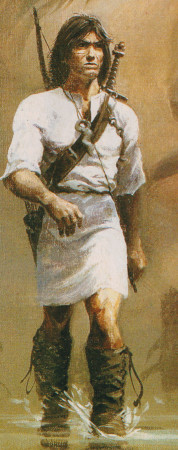
Thorgal
|
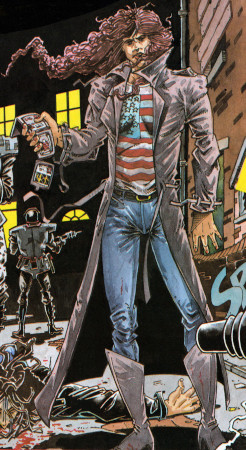
Jenny Styrene
|
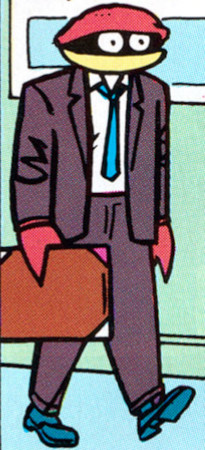
Crusht Acean, the Man from Cancer
|
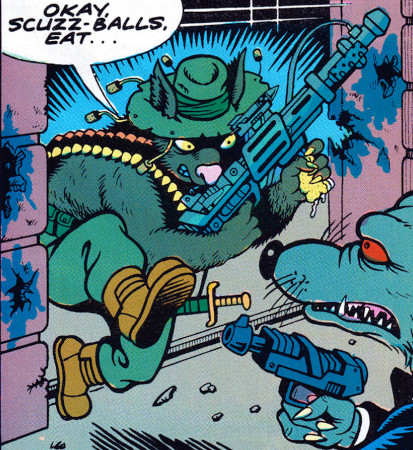
Combat Wombat
|
|
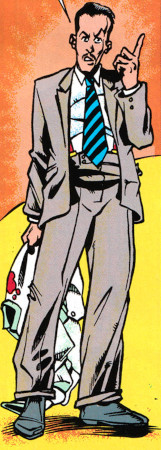
Dexter Pantry
|
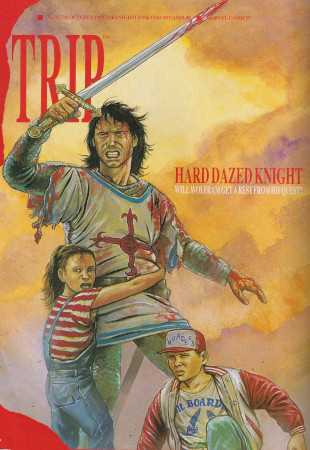
Wolfram
|
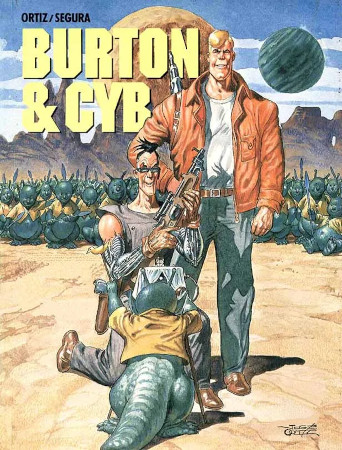
Burton and Cyb - planned to start in Strip#21
|
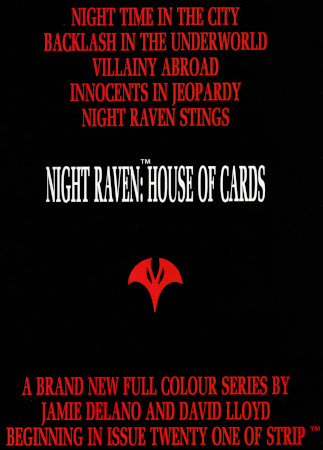
Night Raven: House of Cards - planned to start in Strip#21
|
|
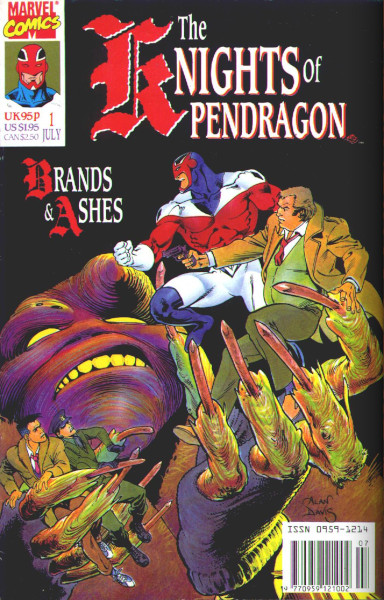 Title/issues:
Knights of Pendragon#1-18 (July
1990-December 1991) Title/issues:
Knights of Pendragon#1-18 (July
1990-December 1991)
Where: U.K.
Featuring: Captain Britain, Dai Thomas, Knights of
Pendragon
616?: Yes.
Summary: To follow
Reprinted in U.S.?: Yes
Comments: Though their prior ventures into American format
titles hadn't bee runaway successes, they'd apparently also not
been so disastrous as to kill the idea, plus Captain Britain was
now a more saleable figure thanks to his major role in the highly
successful Excalibur title (launched 1988) and a trade paperback
collecting his Alan Davis-penned run from Captain Britain monthly
and the latter issues of Mighty World of Marvel. Prior to
Excalibur American readers without access to someone who could
send them British comics had only minimal exposure to the
character, but Excalibur had raised his profile, as well as that
of his ally Dai Thomas. Thus editor Steve White oversaw plans to
create a new series starring them both, Knights of Pendragon.
Since Captain Britain was still appearing in Excalibur and so
(unlike Wolverine or Spider-Man) couldn't be reasonably expected
to appear in multiple ongoing titles simultaneously, Knights of
Pendragon was intended to be a six issue miniseries, dipping into
the myths of the British Isles in similar manner to the earlier
Black Knight strip in Hulk Comic. It proved so successful that it
was extended into an ongoing title, and while Captain Britain had
to be written out and replaced with fellow British hero Union
Jack, Dai Thomas was able to stay on as the series added in new
characters to take up the roles of the titular knights. After 18
issues the series ended, but not due to lowering sales; rather
because plans were underway to launch a much larger Marvel U.K.
American-formatted line, and Knights of Pendragon was to be
rebooted as more of a superhero title, as it was felt this would
sell better in the U.S.
|
|
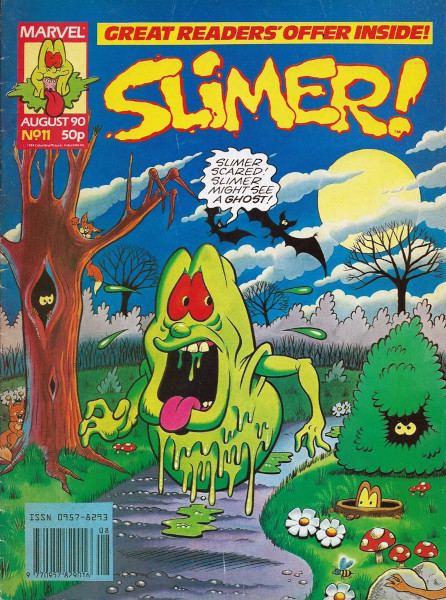 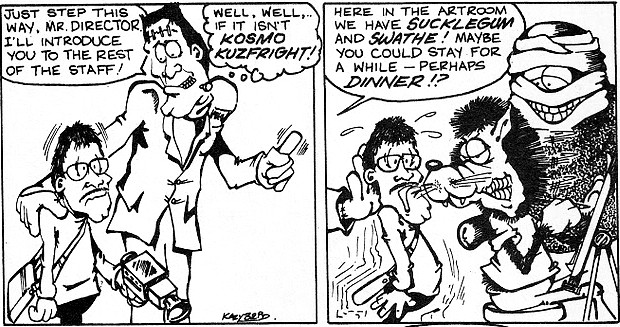 Title/issues:
Slimer!#11-12 (August-September 1990) Title/issues:
Slimer!#11-12 (August-September 1990)
Where: U.K.
Featuring: Daily Howl
616?: Unlikely but not impossible.
Summary: To follow
Reprinted in U.S.?: No
Comments: Following the cancellation of It's Wicked!,
Slimer was spun off into his own series, consisting partially of
reprints from the American Now Comics' title of the same name, and
partially of British produced stories reprinted from It's Wicked!
Additionally, in Slimer!#11 and 12 there were new episodes of the
Daily Howl, a strip about a newspaper run by monsters that had
previously been part of It's Wicked!'s line-up. Slimer! was
cancelled with it's thirteenth issue, and merged into The Real
Ghostbusters.
|
|
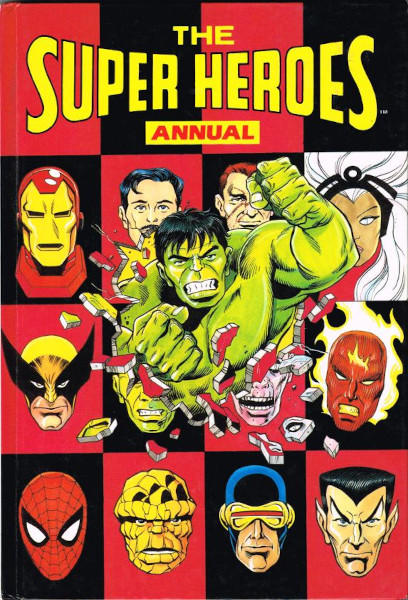 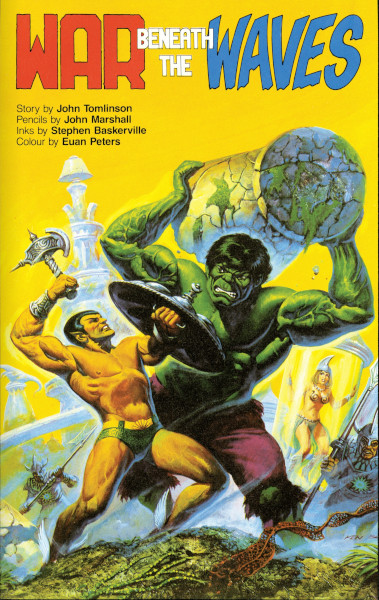 Title/issues:
Super-Heroes Annual 1991 Title/issues:
Super-Heroes Annual 1991
Where: U.K.
Featuring: Hulk, Namor
616?: Probably yes.
Summary: War Beneath the Waves
Reprinted in U.S.?: Yes, in Hulk: From the UK Vaults
Comments: After a few years gap where U.K. Marvel annuals
didn't carry any new stories, the dry spell was broken by The
Super-Heroes Annual 1991 (published, as ever, late the prior
year). While the bulk of the book reprinted Iron Man#234,
Fantastic Four from Marvel Fanfare#43 and Classic X-Men#20
stories, it also included a new Hulk vs Namor text tale, The War
Beneath the Waves.
As ever, Tony's Trading has a full
gallery of these Marvel annuals, including all the ones that
were solely reprints.
|
|
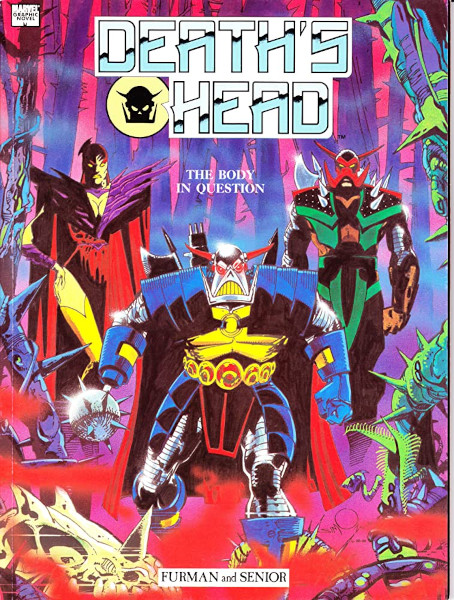 Title/issues:
Death's Head: The Body in Question (October
1990) Title/issues:
Death's Head: The Body in Question (October
1990)
Where: U.K.
Featuring: Death's Head
616?: No.
Summary: To follow
Reprinted in U.S.?: Yes
Comments: Strictly speaking this one isn't a new story, as
The Body in Question graphic novel collects the tale originally
serialized in Strip. However, for those wanting to pick up that
story and not interested in the other, far less connected to
Marvel, stories in that title, this graphic novel is a one-stop
shop and thus far better option. Plus it's notable for being (one
of?) the first Marvel U.K. graphic novels.
|
|
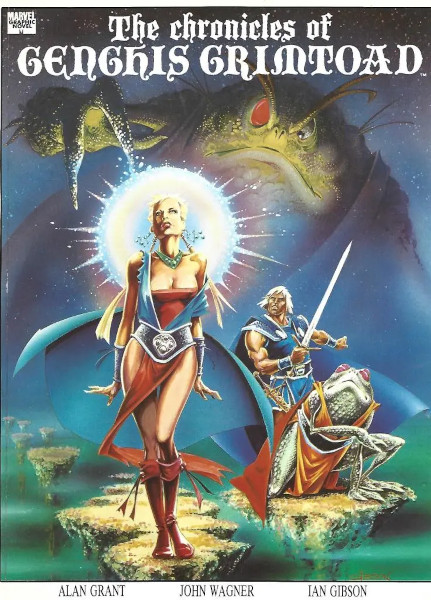 Title/issues:
Chronicles of Genghis Grimtoad (1990) Title/issues:
Chronicles of Genghis Grimtoad (1990)
Where: U.K.
Featuring: Genghis Grimtoad
616?: No.
Summary: To follow
Reprinted in U.S.?: Yes
Comments: The Chronicles of Genghis Grimtoad graphic novel
collected the serialized story from Strip, and added in the
conclusion originally intended for publication in Strip#21 and 22.
|
|
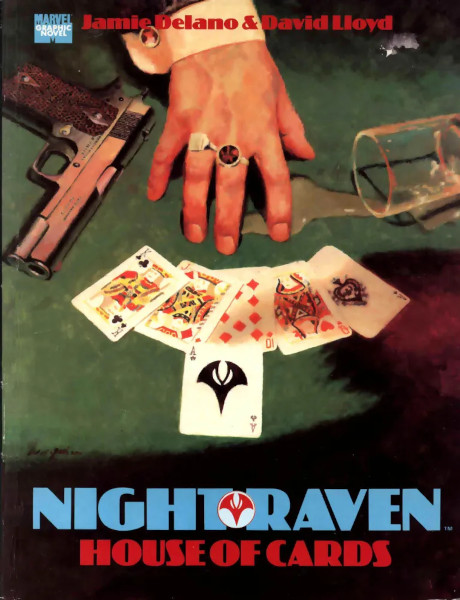 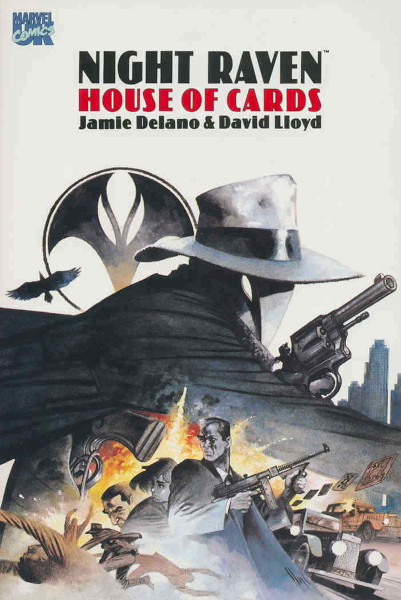 Title/issues:
Night Raven: House of Cards (1991) Title/issues:
Night Raven: House of Cards (1991)
Where: U.K.
Featuring: Night Raven
616?: Yes.
Summary: To follow
Reprinted in U.S.?: Yes
Comments: As noted above, Strip#21 was supposed to host
the start of a new Night Raven comic story, which would then be
collected into a graphic novel, complementing the graphic novel of
Night Raven's original strips from Hulk Comic that had been
released in 1990. With Strip's cancellation as of #20, Marvel U.K.
simply fell back to the latter half of the plan, and released the
tale as a graphic novel. The A4-sized first edition with a green
cover depicting a hand of cards was released in 1991; a year later
a smaller, American comic sized, version was released with a new
cover by David Lloyd.
|
|
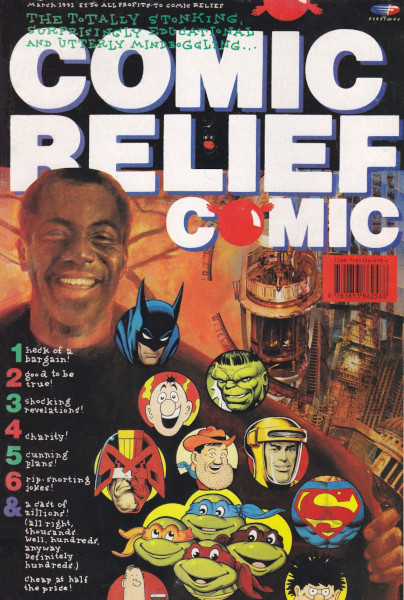 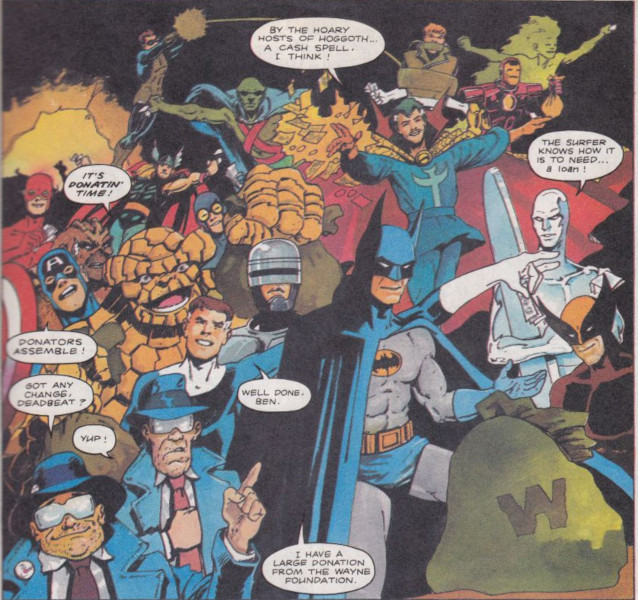 Title/issues:
The Totally Stonking, Surprisingly Educational
And Utterly Mindboggling Comic Relief Comic (March 1991) Title/issues:
The Totally Stonking, Surprisingly Educational
And Utterly Mindboggling Comic Relief Comic (March 1991)
Where: U.K.
Featuring: Captain America, Captain Britain, Hulk, Iron
Man, Mr. Fantastic, Silver Surfer, Sleeze Brothers, Spider-Man,
Thing, Thor, Wolverine
616?: Probably not, given the presence of non-Marvel
characters.
Summary: To follow
Reprinted in U.S.?: No
Comments: Published by Fleetway
(a comic company absorbed into IPC in the 1960s and reformed as a
separate company in 1987), the Comic Relief Comic was a tie-in to
the third Red Nose Day, a bi-annual fundraising event held by the
charity Comic Relief. The brainchild of Neil Gaiman, Grant
Morrison, Peter K. Hogan and filmmaker/Comic Relief co-founder
Richard Curtis, it featured contributions from dozens of prominent
comic writers and artists and appearances from both real world
individuals connected to the charity (such as the comedians who
presented the telethon) and characters from TV and comics, their
respective copyright holders giving permission for them to appear
alongside one another because it was raising money for a worthy
cause. Thus (as the example panels show) Marvel characters share
panels with DC, Fleetway and DC Thomson creations. Per
Neil Gaiman, though it sold out in minutes it was never
reprinted because DC had given permission to use their characters
only so long as they appeared in provided "standard poses" and the
comic had strayed from that guideline.
|
|
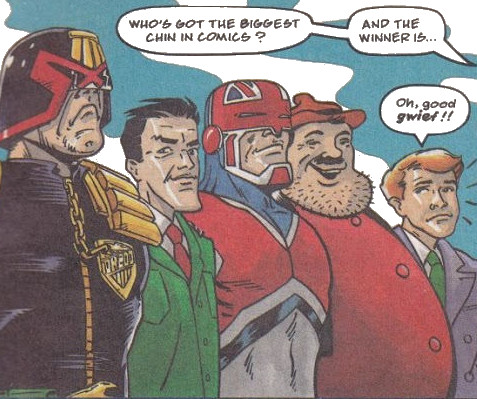
Judge Dredd, Dan
Dare, Captain Britain, Desperate
Dan and real-life comic fan and TV presenter Jonathan
Ross have a chin-off.
|
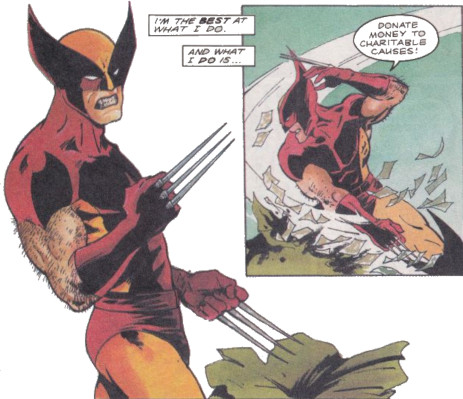
|
|
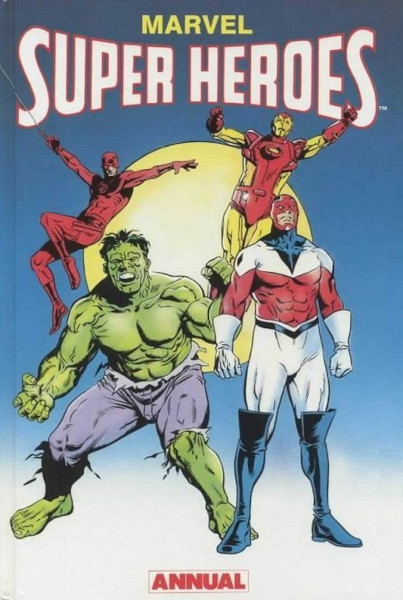 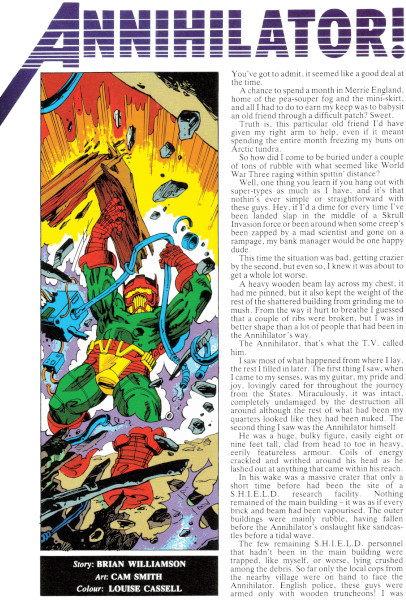 Title/issues:
Marvel Superheroes Annual 1992 Title/issues:
Marvel Superheroes Annual 1992
Where: U.K.
Featuring: Daredevil, Captain Britain
616?: Probably yes.
Summary: The Wild & The Blind
Annihilator
Reprinted in U.S.?: Daredevil, no; Captain Britain, yes,
in Hulk: From the UK Vaults
Comments: Another annual with new text tales to accompany
the comic strip reprints. In this case Daredevil and Wolverine
starred in the eight page "The Wild & the Blind," while
Captain Britain, the Hulk and others appeared in the nine page
"Annihilator."
|
|
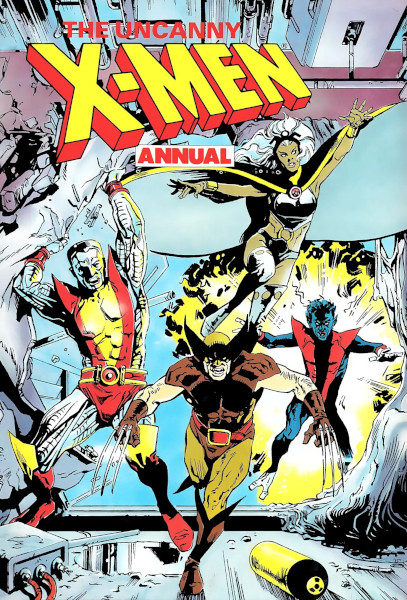 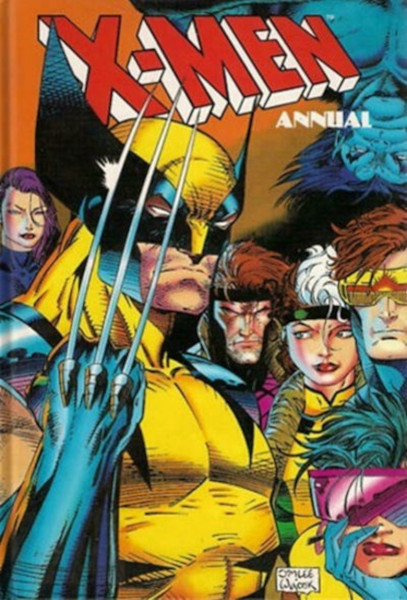 Title/issues:
Uncanny X-Men Annual 1992, X-Men Annual 1996 Title/issues:
Uncanny X-Men Annual 1992, X-Men Annual 1996
Where: U.K.
Featuring: X-Men
616?: Probably yes.
Summary: (1992) Professional Rivalry
(1996) Grave Danger
Reprinted in U.S.?: No
Comments: Having somehow skipped the new text story trend
despite having annuals released during the text tale heydays of
the 1980s, in 1991 the U.K.'s Uncanny X-Men Annual 1992 finally
joined the club with the twelve page story "Professional Rivalry";
there were no X-Men Annuals after that until 1995, which included
the five page "Grave Danger." Again, all British annuals for X-Men
can be seen at Tony's
Trading.
|
|
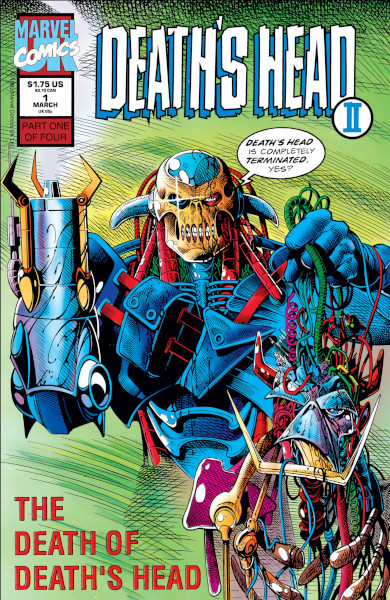 Title/issues:
Death's Head II#1-4 (March-May 1992) Title/issues:
Death's Head II#1-4 (March-May 1992)
Where: U.K.
Featuring: Death's Head II
616?: Among other realities visited, yes.
Summary: To follow
Reprinted in U.S.?: Yes
Comments: By 1992 Marvel U.K. was preparing for a huge
shake-up under the editorial leadership of Paul Neary. This
"Genesis: 92" planned to build on the previous American-formatted
projects and expand on them. The details are thoroughly summarized
by John Freeman on his site, Down the Tubes, and since I'm only
wanting to track what stories are out there, not the full
backstory behind their creations, and, more importantly, there's
little point in anyone reading my second-hand account of those
plans rather than his far better first-hand account, anyone
interested can read
more about them at this link.
Suffice to say the plan was to launch a number of
titles intended to be sold to the American market under the Marvel
U.K. reprint, while the same stories (more or less - see below)
would be reprinted in a more traditional to the U.K. anthology
title, Overkill, shortly thereafter. The headline star of this new
line was to be a revamped Death's Head, who was introduced in a
four issue miniseries a few months ahead of the other titles.
|
|
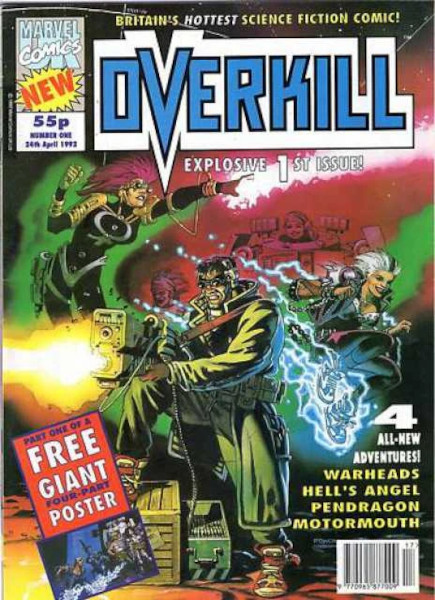 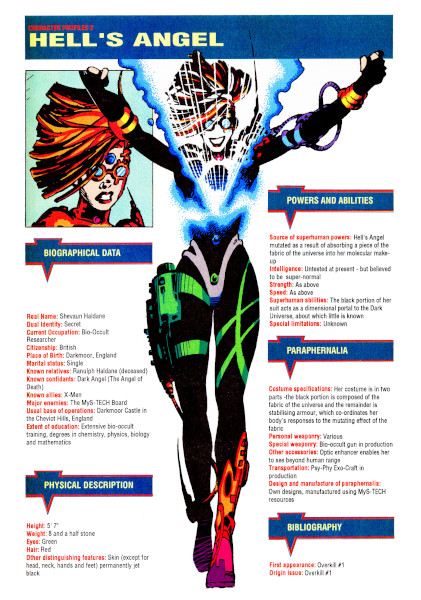 Title/issues:
Overkill#1-52 (April 1992-August 1994) Title/issues:
Overkill#1-52 (April 1992-August 1994)
Where: U.K.
Featuring:
- Dark Angel: #26
- Knights of Pendragon: #5
- Mys-Tech Board: #8
616?: Yes.
Summary: (Overkill#5) - no title -
(Overkill#8) - "Arcane Rites" -
(Overkill#25) - "Double Cross" -
Reprinted in U.S.?: Yes, except for the stories listed
above.
Comments: While the American-formatted comics were
intended to be marketed and sold in the U.S.A., they were not
originally intended to be sold in the U.K.; in fact, at the time
there were rumors going around at least the comic shops that I
went to that there would be an embargo on them coming into the
country. Instead British readers were expected to buy Overkill, a
weekly anthology that contained (more or less) the same stories,
but in a title that more closely matched the norm for British
comics. In the end the alleged embargo never happened, so fans who
bought their titles from specialist shops simply bought the
American-formatted versions, while those who purchased them in the
high street shops picked up Overkill instead - and honestly, that
isn't the worst marketing strategy, since the high street option
reaches more casual readers who either don't know or don't bother
with specialist shops. A few curious anomalies arose as a result
of this format double dipping:
Hoping to appeal to the same audience that continued
to make 2000A.D. a success, and believing that superhero stories
were not what they'd want to read, editor Paul Neary came up with
the idea of having each story written so that the superhero
sections could be excised for Overkill. Thus early stories were
written so that guest star superheroes would appear in roughly
half of each issue, but their segments could be cut and the story
would still make sense. In practice this tricky to follow remit
tended to produce slightly disjointed stories, and thankfully it
wasn't too long before market research revealed that readers were
quite happy to have superheroes in the title and this requirement
was dropped.
Given the sheer number of American-formatted titles,
not everything released in that format got reprinted in Overkill.
Conversely, though I say Overkill reprinted the American-formatted
titles, that's not completely accurate - a number of stories
appeared in Overkill first, such as Digitek, who debuted in
Overkill#2 (cover date 8th May 1992), several months ahead of his
American-formatted title being released (Digitek#1 was cover dated
December 1992, so probably released late September/early October).
Some short stories were commissioned specifically for Overkill;
many of them then went on to appear as back-up stories in the
American-formatted titles, but not all. For simplicity's sake, if
not accuracy's, I'm only listing here the stories that didn't also
appear in American-formatted titles, regardless of where they
appeared first. It is worth mentioning that several issues of
Overkill also included handbook-like features that didn't get
reprinted elsewhere (see right for an example); I'll probably get
round to cataloguing them at some point.
At least a couple of Warheads stories were
commissioned but never published anywhere - Paul Cornell and
Martin Geraghty's completed Needles, and an unnamed and at least
partially drawn tale by Nick Vince and "Smuzz."
|
|
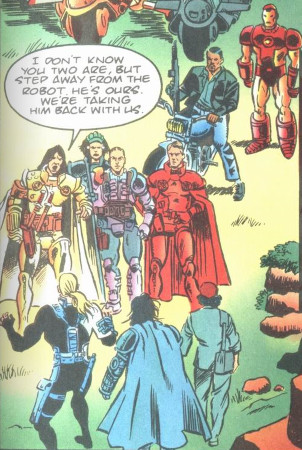
Knights of Pendragon II#3 - Iron Man and Rhodey, yes?
|
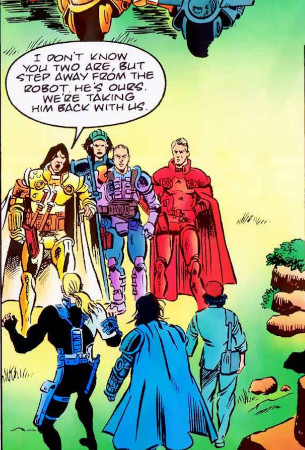
Overkill#6 - Iron Man and Rhodey, no.
|
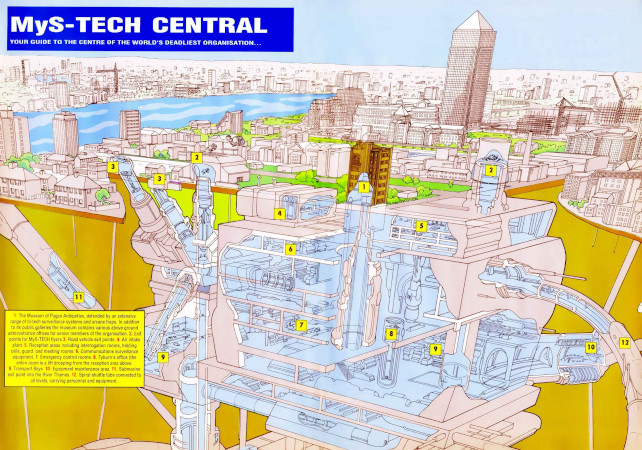
Overkill#22 - part one of a Mys-Tech Central diagram.
|
|
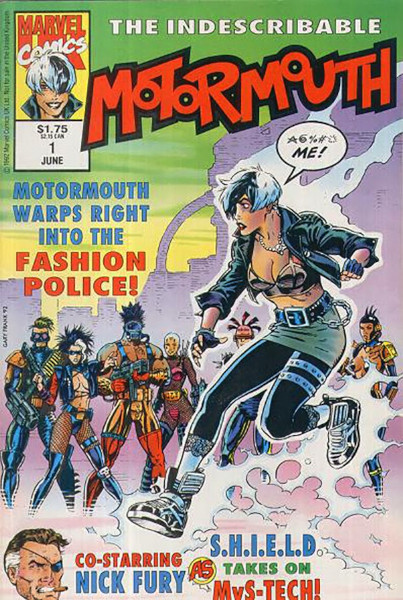 Title/issues:
Motormouth#1-4; Motormouth &
Killpower#5-10 (June 1992-May 1993) Title/issues:
Motormouth#1-4; Motormouth &
Killpower#5-10 (June 1992-May 1993)
Where: U.K.
Featuring: Motormouth, Killpower
616?: Yes (as well as other realities).
Summary: To follow
Reprinted in U.S.?: Yes
Comments: An ongoing series starring new characters
Motormouth and Killpower.
|
|
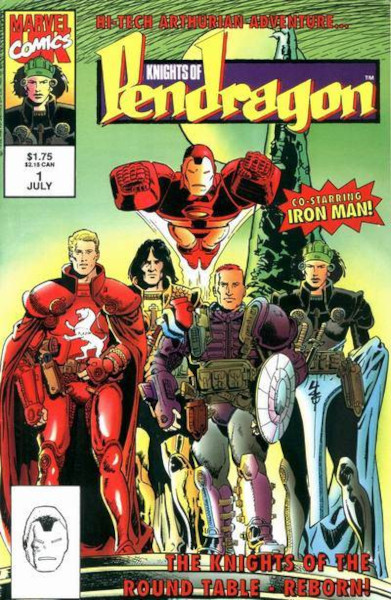 Title/issues:
Knights of Pendragon#1-15 (June 1992-September
1993) Title/issues:
Knights of Pendragon#1-15 (June 1992-September
1993)
Where: U.K.
Featuring: Knights of Pendragon
616?: Yes.
Summary: To follow
Reprinted in U.S.?: Yes
Comments: The revamped, more superheroic, Knights of
Pendragon.
|
|
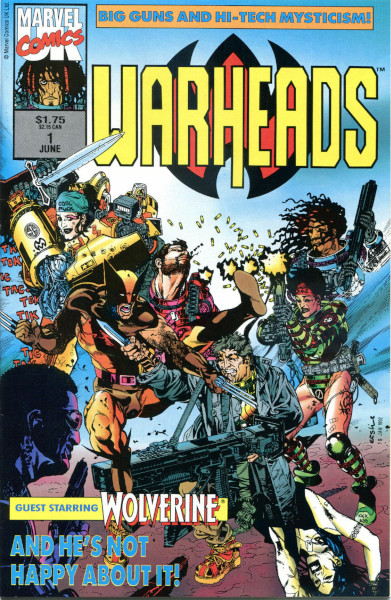 Title/issues:
Warheads#1-14 (June 1992-August 1993) Title/issues:
Warheads#1-14 (June 1992-August 1993)
Where: U.K.
Featuring: Warheads
616?: Yes (as well as other realities)
Summary: To follow
Reprinted in U.S.?: Yes
Comments: Inspired by Frederick Pohl's Gateway novels,
Warheads followed one of the mercenary troops working for Mys-Tech
to plunder the multiverse.
|
|
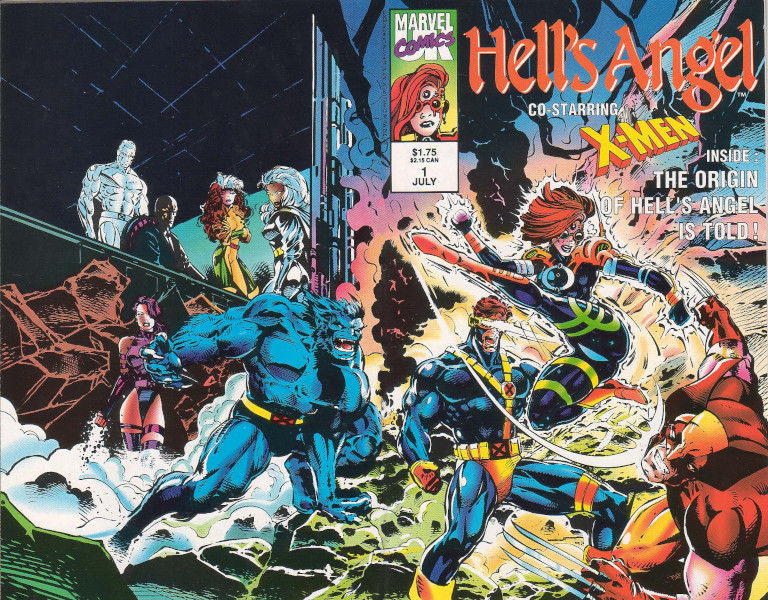 Title/issues:
Hell's Angel#1-5; Dark Angel#6-16 (July
1992-December 1993) Title/issues:
Hell's Angel#1-5; Dark Angel#6-16 (July
1992-December 1993)
Where: U.K.
Featuring: Dark Angel
616?: Yes.
Summary: To follow
Reprinted in U.S.?: Yes
Comments: Forced to change its name after five issues
because of complaints from the real world Hell's Angels
organization, the series starred the daughter of one the Mys-Tech
Board who accessed mystical powers to fight the evil organization.
|
|
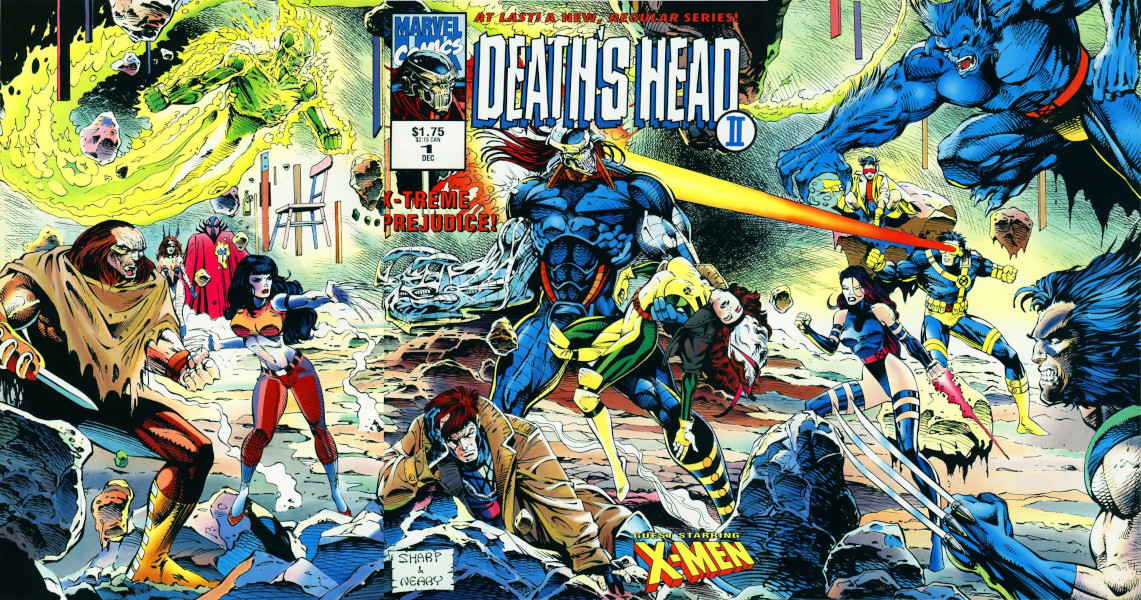 Title/issues:
Death's Head II#1-16 (October 1992-March 1994) Title/issues:
Death's Head II#1-16 (October 1992-March 1994)
Where: U.K.
Featuring: Death's Head II
616?: Yes, among other realities.
Summary: To follow
Reprinted in U.S.?: Yes
Comments: After the success of his miniseries Death's Head
II received an ongoing title, and would also become the defacto
main character of this Marvel U.K. subdivision of the Marvel
universe, his popularity with fans guaranteeing him numerous guest
appearances in the other Marvel U.K. titles.
|
|
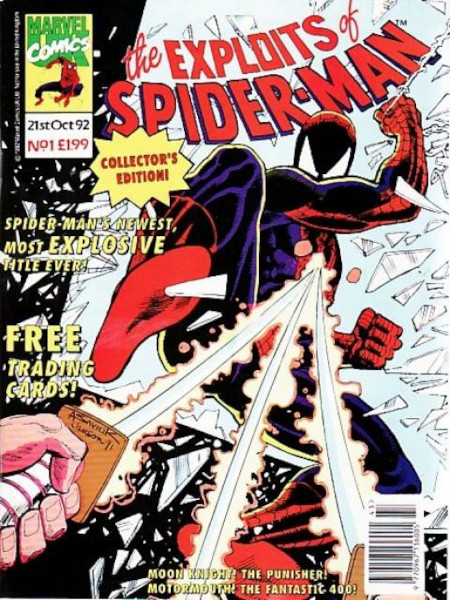 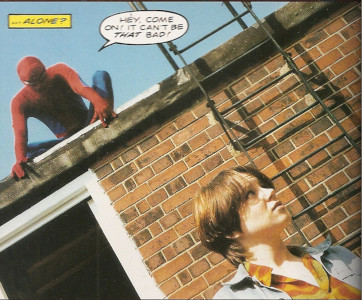 Title/issues:
Exploits of Spider-Man#1-22, 24 (21st
October 1992-27th July 1994) Title/issues:
Exploits of Spider-Man#1-22, 24 (21st
October 1992-27th July 1994)
Where: U.K.
Featuring:
- Fantastic 400: #1-22, 24
- Spider-Man: #11
616?: Spider-Man, potentially yes. Fantastic 400 - no,
set on Earth 333333333
Summary: To follow
Reprinted in U.S.?: No
Comments: Exploits of Spider-Man was the latest venue for
Spider-Man stories to be reprinted, a hefty full color volume that
reprinted several entire American comics in each issue, alongside
Motormouth, a somewhat unusual choice given that the same tales
had been published in Overkill only a few months earlier. In
addition 23 out of the first 24 issues saw the return of Tim Quinn
and Dicky Howett's Fantastic 400 (rebranded from the second issue
as the Dark Fantastic 400, to reflect the 90s being a more gritty
decade than the 80s). While some of these episodes were completely
new, a number reused older Fantastic 400 scripts, albeit with the
art completely redone from scratch and now in full color.
Additionally, #11 carried a brand new two page
Spider-Man story, a fairly inconsequential tale of the hero's
encounter with a depressed girl atop a Manhattan roof. The only
thing that makes it stand out as unusual is that instead of being
drawn, it was told in photos, a method that had been used in
British girl's comics, the early issues of the 1980s IPC revival
of The Eagle, or Italian fumetti comics.
|
|
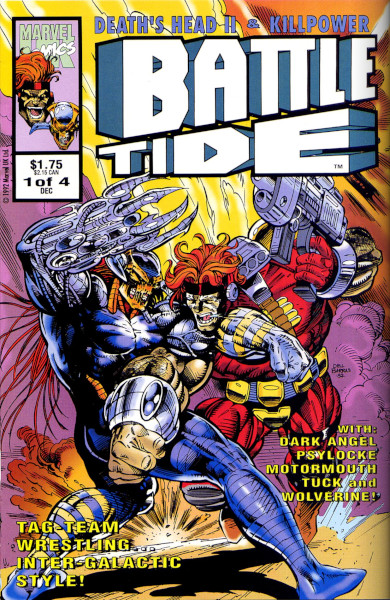 Title/issues:
Battletide#1-4 (December 1992-March
1993) Title/issues:
Battletide#1-4 (December 1992-March
1993)
Where: U.K.
Featuring: Death's Head II, Killpower
616?: Yes.
Summary: To follow
Reprinted in U.S.?: Yes
Comments: A crossover tale between Death's Head II and
Killpower, both forced to participate in alien death match.
|
|
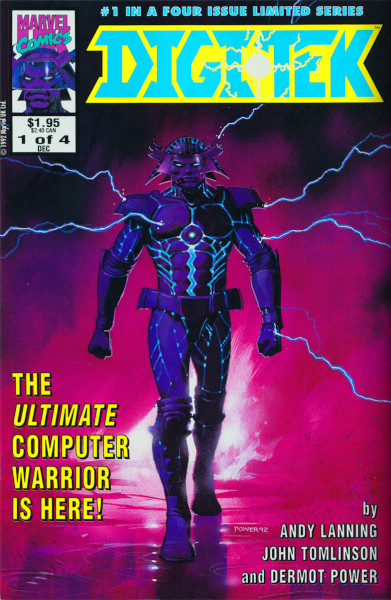 Title/issues:
Digitek#1-4 (December 1992-March 1993) Title/issues:
Digitek#1-4 (December 1992-March 1993)
Where: U.K.
Featuring: Digitek
616?: Yes.
Summary: To follow
Reprinted in U.S.?: Yes
Comments: Introducing the computerized hero Digitek.
|
|
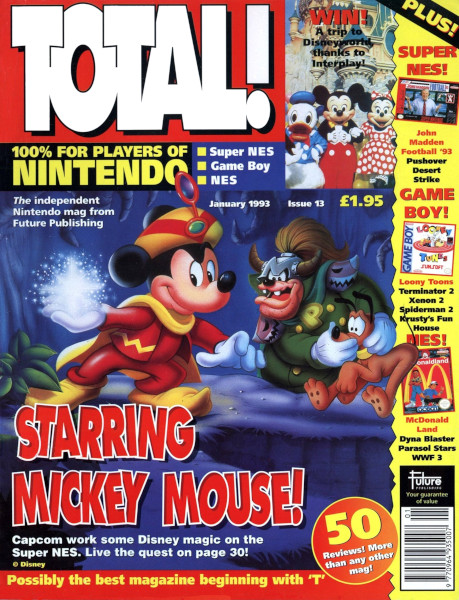 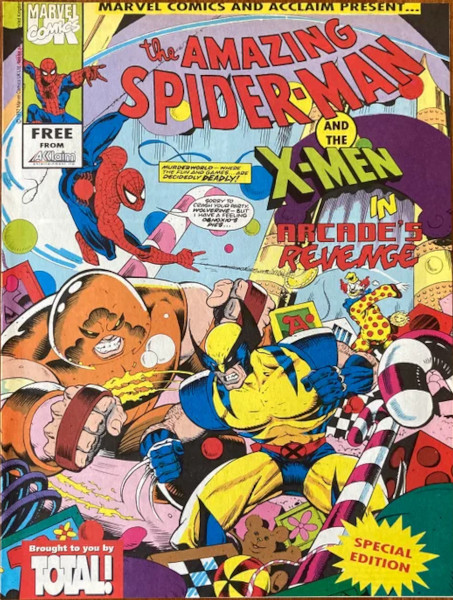 Title/issues:
Total#13 (January 1993) Title/issues:
Total#13 (January 1993)
Where: U.K.
Featuring: Spider-Man, X-Men
616?: Probably yes.
Summary: (Total#13) - Amazing Spider-Man and the X-Men
in Arcade's Revenge
Reprinted in U.S.?: No
Comments: Total!#13, a computer gamer magazine covering
Nintendo, included a pull-out 8 page Spidey and X-Men
UK-originated comic tied into the game Arcade's Revenge.
|
|
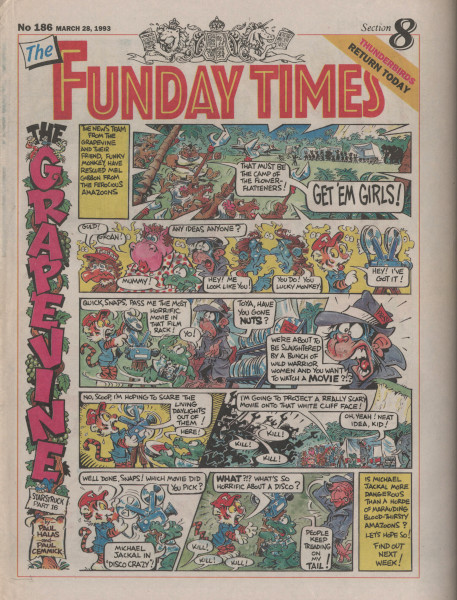 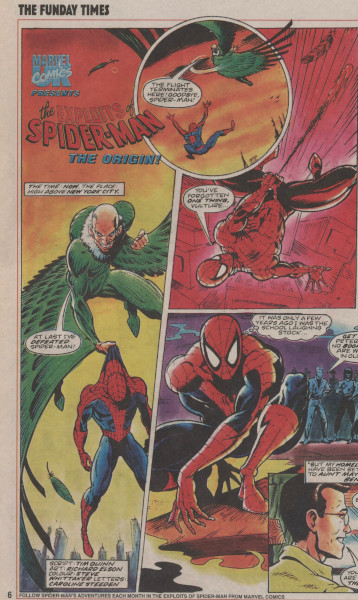 Title/issues:
Funday Times#186-189 (1993), 1995, 2001 Title/issues:
Funday Times#186-189 (1993), 1995, 2001
Where: U.K.
Featuring: Spider-Man
616?: Probably yes.
Summary: To follow
Reprinted in U.S.?: No
Comments: The Funday Times was a 16 page newsprint comics
supplement included with the U.K. newspaper The Sunday Times
between 1989 and 2006. It featured a variety of strips, including
on a number of occasions, new two-page Spider-Man stories. I've
only been able to confirm the exact issues for the first batch
from 1993, but there were apparently further strips in (at
minimum) 1995 and 2001.
|
|
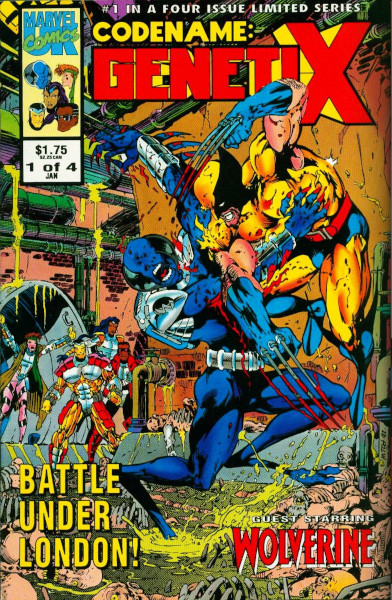 Title/issues:
Codename: Genetix#1-4 (January-May 1993) Title/issues:
Codename: Genetix#1-4 (January-May 1993)
Where: U.K.
Featuring: Genetix
616?: Yes.
Summary: To follow
Reprinted in U.S.?: Yes
Comments: With sales of the Genesis 92 titles proving
encouraging, Marvel U.S. asked for additional titles, sparking a
second wave of new characters and titles to expand Marvel U.K's
American-format line. One of the first of these was the miniseries
Codename: Genetix, originally intended to be called Team Helix.
|
|
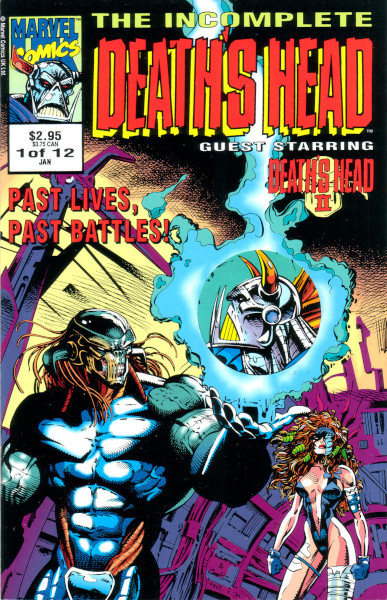  Title/issues: Incomplete
Death's Head#1-12 (January-December 1993) Title/issues: Incomplete
Death's Head#1-12 (January-December 1993)
Where: U.K.
Featuring: Death's Head, Death's Head II
616?: Yes, among other realities visited.
Summary: To follow
Reprinted in U.S.?: Yes
Comments: Death's Head's early stories were also
repackaged to introduce the character to American audiences who
had missed the prior incarnation. What makes this notable for this
listing of new material was the framing sequences that involved
Death's Head II and Tuck, and eventually looped in both the prior
Death's Head and the Doctor from Doctor Who.
|
|
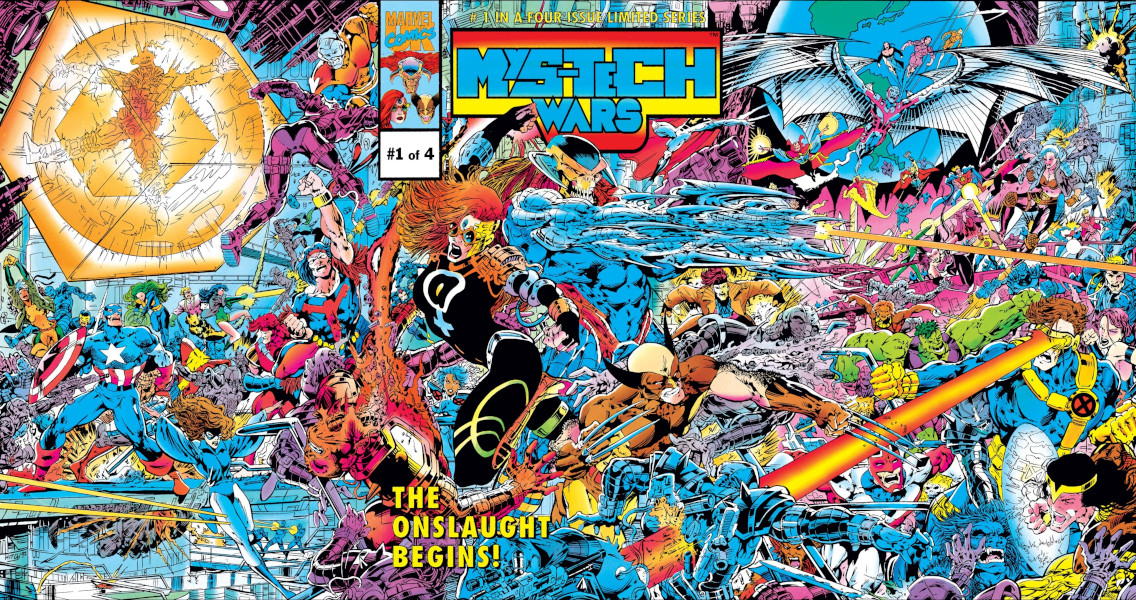 Title/issues:
Mys-Tech Wars#1-4 (March-June 1994) Title/issues:
Mys-Tech Wars#1-4 (March-June 1994)
Where: U.K.
Featuring: Everyone
616?: Yes.
Summary: To follow
Reprinted in U.S.?: Yes
Comments: A climax if not a conclusion to the Mys-Tech
storyline that had been building across all the Marvel U.K. line,
Mys-Tech Wars was a grand crossover which roped in guest stars
from mainline Marvel as well.
|
|
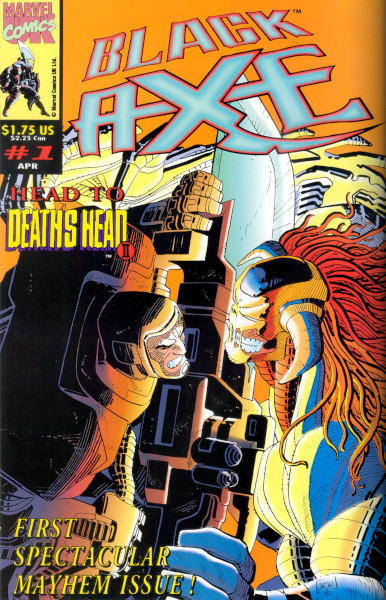 Title/issues:
Black Axe#1-7 (April-October 1993) Title/issues:
Black Axe#1-7 (April-October 1993)
Where: U.K.
Featuring: Black Axe
616?: Yes.
Summary: To follow
Reprinted in U.S.?: Yes
Comments: Another American-format title, this time
featuring a 10,000 year old mercenary. From this juncture Marvel
U.K. pounded out several new series, unaware that the direct sales
market was about to crash in 1994.
|
|
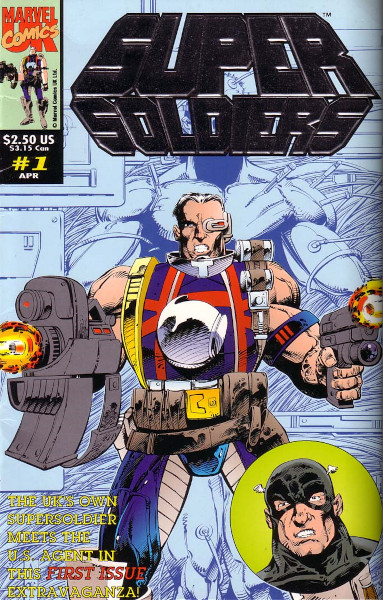 Title/issues:
Super Soldiers#1-8 (April-November 1993) Title/issues:
Super Soldiers#1-8 (April-November 1993)
Where: U.K.
Featuring: Super Soldiers
616?: Yes.
Summary: To follow
Reprinted in U.S.?: Yes
Comments: Another American-format title, featuring British
Super Soldiers.
|
|
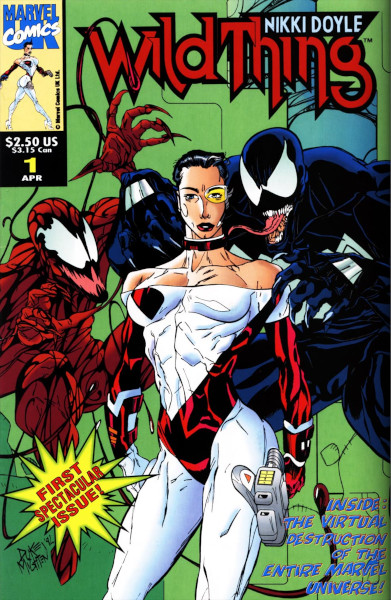 Title/issues:
Wild Thing#1-7 (April-October 1993) Title/issues:
Wild Thing#1-7 (April-October 1993)
Where: U.K.
Featuring: Wild Thing
616?: No.
Summary: To follow
Reprinted in U.S.?: Yes
Comments: Another American-format title, set in the then
future of 2020 and starring cyberspace hacker Wild Thing.
|
|
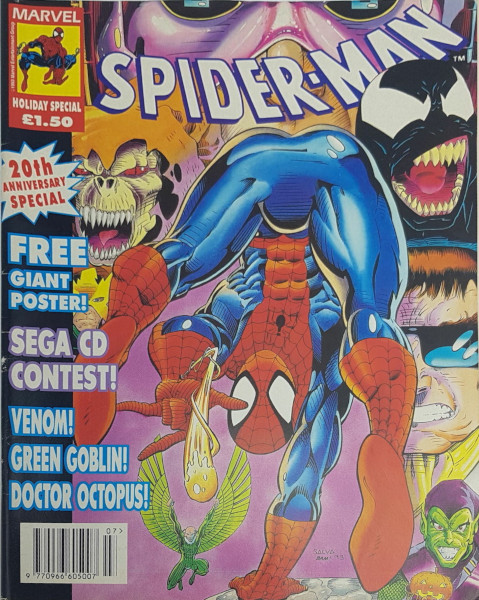 Title/issues:
Spider-Man Holiday Special (1993) Title/issues:
Spider-Man Holiday Special (1993)
Where: U.K.
Featuring: Spider-Man
616?: Probably yes.
Summary: To follow
Reprinted in U.S.?: No
Comments: To mark the 20th anniversary of Marvel U.K.'s
Spider-Man titles, a holiday special was released, which included
a new two page photo story, similar to the one included in
Exploits of Spider-Man#11 (above).
|
|
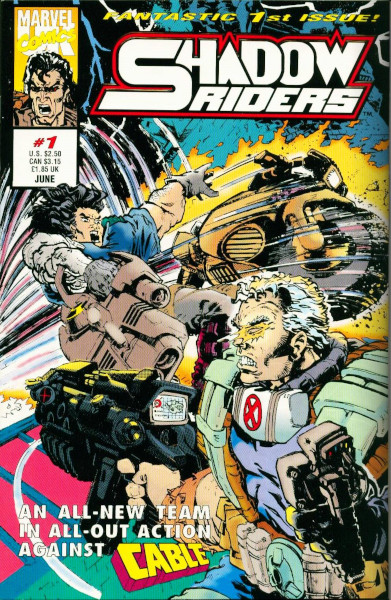 Title/issues:
Shadow Riders#1-4 (June-September 1993) Title/issues:
Shadow Riders#1-4 (June-September 1993)
Where: U.K.
Featuring: Shadow Riders
616?: Yes.
Summary: To follow
Reprinted in U.S.?: Yes
Comments: And another American-format title.
|
|
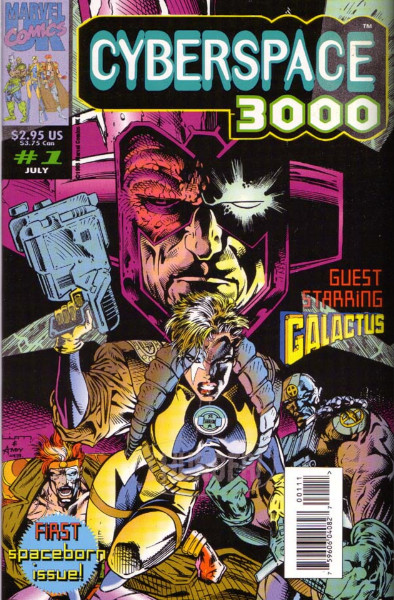 Title/issues:
Cyberspace 3000#1-8 (July 1993-February
1994) Title/issues:
Cyberspace 3000#1-8 (July 1993-February
1994)
Where: U.K.
Featuring: Sol III crew
616?: No.
Summary: To follow
Reprinted in U.S.?: Yes
Comments: Set in the distant future, the next
American-format title went into deep space.
|
|
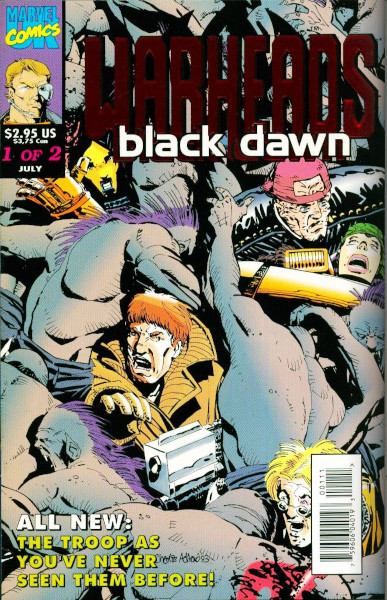 Title/issues:
Warheads: Black Dawn#1-2 (July-August 1993) Title/issues:
Warheads: Black Dawn#1-2 (July-August 1993)
Where: U.K.
Featuring: Warheads
616?: Not in this miniseries.
Summary: To follow
Reprinted in U.S.?: Yes
Comments: A miniseries to accompany the main Warheads
title.
|
|
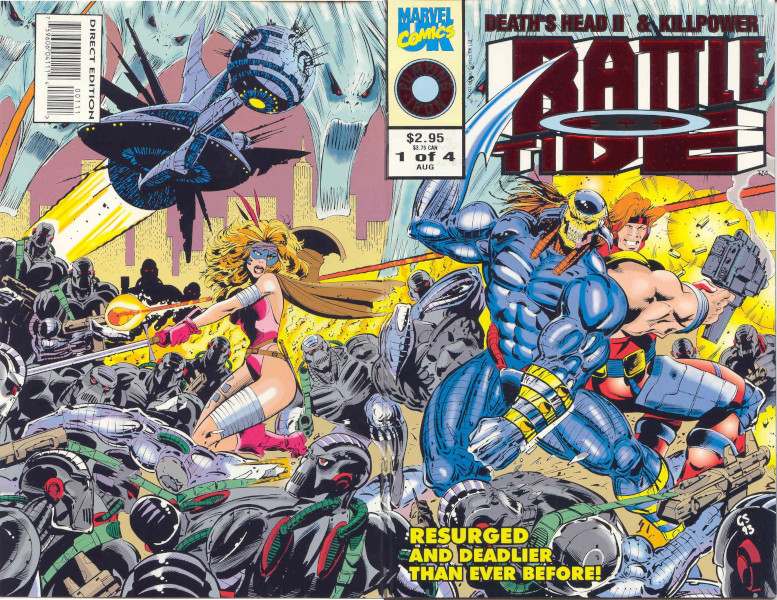 Title/issues:
Battletide#1-4 (August-November 1993) Title/issues:
Battletide#1-4 (August-November 1993)
Where: U.K.
Featuring: Death's Head II, Killpower
616?: Yes.
Summary: To follow
Reprinted in U.S.?: Yes
Comments: After the success of the first Battletide
miniseries a second was almost inevitable.
|
|
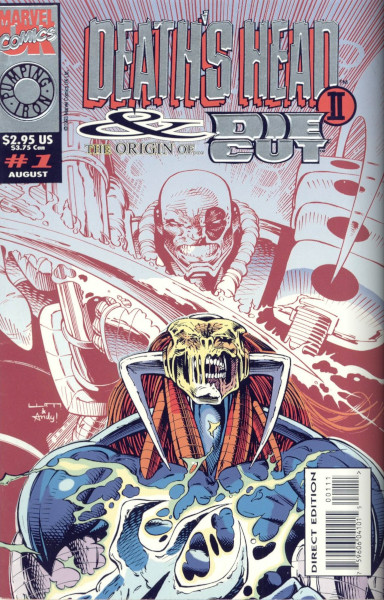 Title/issues:
Death's Head & the Origins of Die-Cut#1-2
(August-September 1993) Title/issues:
Death's Head & the Origins of Die-Cut#1-2
(August-September 1993)
Where: U.K.
Featuring: Death's Head II, Die-Cut
616?: Yes
Summary: To follow
Reprinted in U.S.?: Yes
Comments: A two issue miniseries to introduce a new
character, Die-Cut, with help from Marvel U.K. MVP Death's Head
II.
|
|
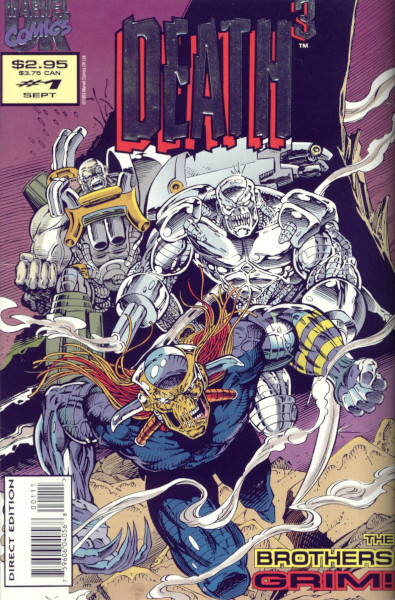 Title/issues:
Death3#1-4 (September-December
1993) Title/issues:
Death3#1-4 (September-December
1993)
Where: U.K.
Featuring: Death's Head II, Death Metal, Death Wreck
616?: Linked to 616, but I don't think any part of the
story takes place there.
Summary: To follow
Reprinted in U.S.?: Yes
Comments: If one Death's Head is a fan-favorite and top
seller, then clearly three versions would be even better. Thus
Marvel U.K. introduced his "brothers," the prototype Death Wreck
and the new and improved model, Death Metal.
|
|
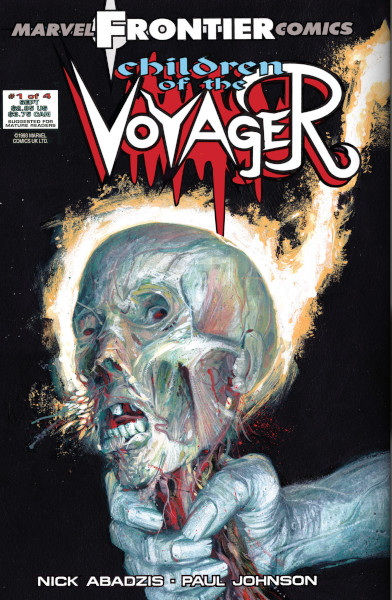 Title/issues:
Children of Voyager#1-4 (September-December
1993) Title/issues:
Children of Voyager#1-4 (September-December
1993)
Where: U.K.
Featuring: Voyager
616?: Yes.
Summary: To follow
Reprinted in U.S.?: Yes
Comments: With the ongoing success of their main line,
Marvel U.K. created another line, Frontier Comics, aimed at more
mature storylines, their answer to DC's Vertigo line. One of these
was Children of the Voyager, about a mysterious entity known as
the Voyager.
|
|
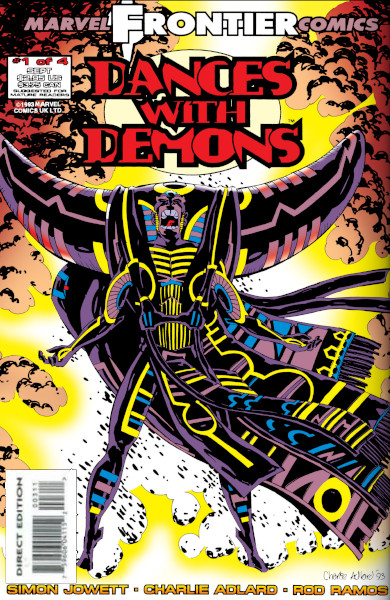 Title/issues:
Dances with Demons#1-4 (September-December
1993) Title/issues:
Dances with Demons#1-4 (September-December
1993)
Where: U.K.
Featuring: Ghost Dancer
616?: Yes.
Summary: To follow
Reprinted in U.S.?: Yes
Comments: Another Frontier Comics title.
|
|
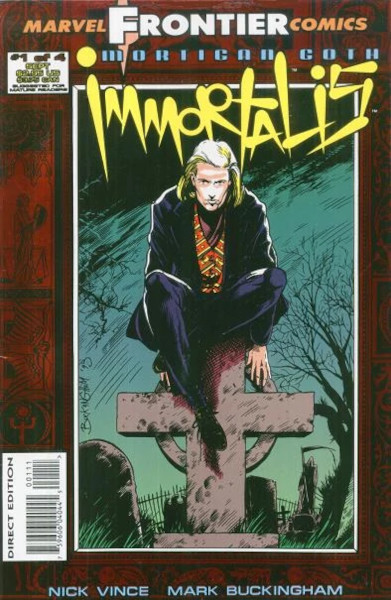 Title/issues:
Immortalis#1-4 (September 1993-March
1994) Title/issues:
Immortalis#1-4 (September 1993-March
1994)
Where: U.K.
Featuring: Mortigan Goth
616?: Yes.
Summary: To follow
Reprinted in U.S.?: Yes
Comments: Another Frontier Comics title.
|
|
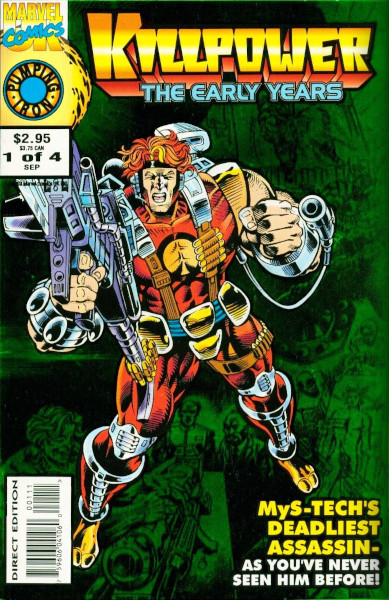 Title/issues:
Killpower: The Early Years#1-4
(September-December 1993) Title/issues:
Killpower: The Early Years#1-4
(September-December 1993)
Where: U.K.
Featuring: Killpower
616?: Yes.
Summary: To follow
Reprinted in U.S.?: Yes
Comments: A miniseries covering the origins of Killpower.
|
|
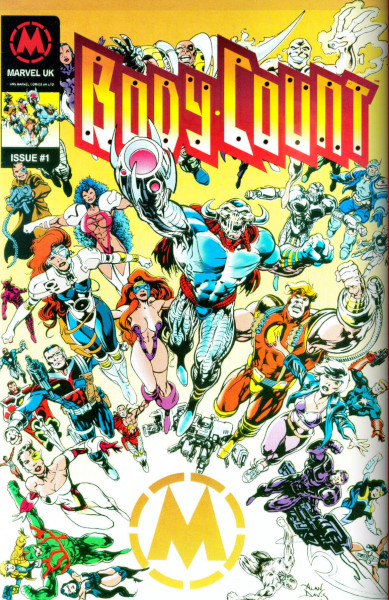 Title/issues:
Body Count (October 1993) Title/issues:
Body Count (October 1993)
Where: U.K.
Featuring: Various
616?: Yes.
Summary: To follow
Reprinted in U.S.?: Yes
Comments: Not a story, but a preview title discussing
forthcoming series, Body Count is most of interest for the
tantalizing glimpses of titles that ultimately were never
published thanks to Marvel U.K.'s collapse a few months later. The
cover alone includes at least half a dozen characters who were
intended to feature in new comics that didn't make it to the shop
shelves.
|
|
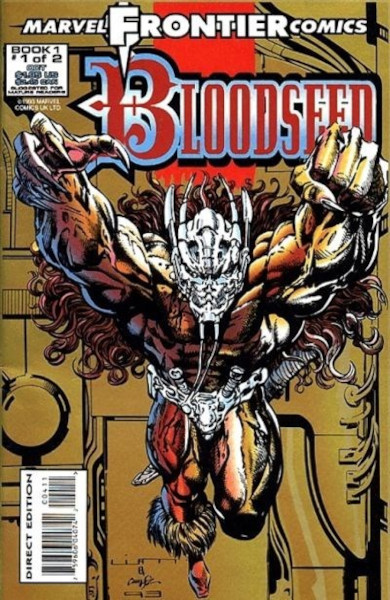 Title/issues:
Bloodseed#1-2 (October-November 1993) Title/issues:
Bloodseed#1-2 (October-November 1993)
Where: U.K.
Featuring: Bloodseed
616?: No.
Summary: To follow
Reprinted in U.S.?: Yes
Comments: The fourth Frontier Comics miniseries.
|
|
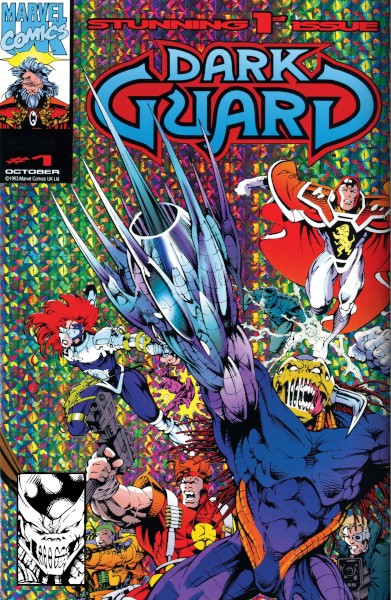 Title/issues:
Dark Guard#1-4 (October 1993-January 1994) Title/issues:
Dark Guard#1-4 (October 1993-January 1994)
Where: U.K.
Featuring: Dark Guard
616?: Yes.
Summary: To follow
Reprinted in U.S.?: Yes
Comments: A team book bringing together some of Marvel
U.K's most popular characters.
|
|
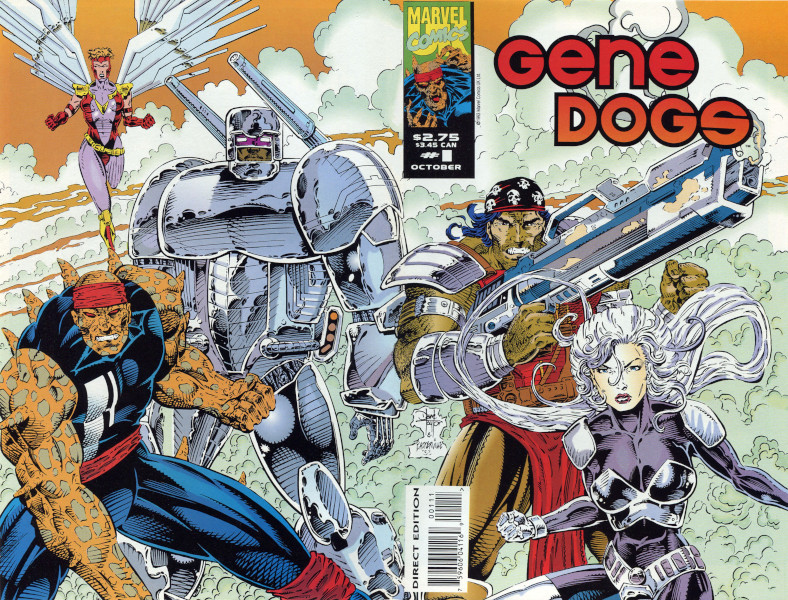 Title/issues:
Gene Dogs#1-4 (October 1993-January 1994) Title/issues:
Gene Dogs#1-4 (October 1993-January 1994)
Where: U.K.
Featuring: Gene Dogs
616?: Yes.
Summary: To follow
Reprinted in U.S.?: Yes
Comments: Another team book, Gene Dogs was intended to
evoke the style of the X-Men.
|
|
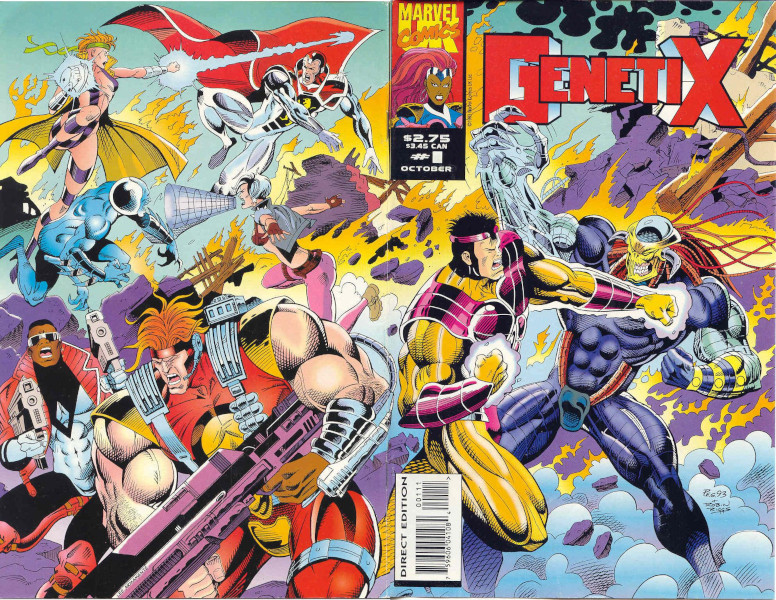 Title/issues:
Genetix#1-6 (October 1993-March 1994) Title/issues:
Genetix#1-6 (October 1993-March 1994)
Where: U.K.
Featuring: Genetix
616?: Yes.
Summary: To follow
Reprinted in U.S.?: Yes
Comments: After their previous miniseries Genetix returned
for a second, longer miniseries.
|
|
 Title/issues:
Gun Runner#16 (October 1993-March 1994) Title/issues:
Gun Runner#16 (October 1993-March 1994)
Where: U.K.
Featuring: Gun Runner
616?: Yes.
Summary: To follow
Reprinted in U.S.?: Yes
Comments: Another miniseries, this time involving alien
warrior Gun Runner.
|
|
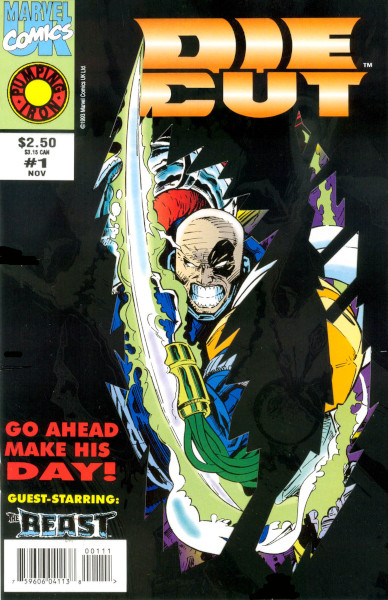 Title/issues:
Die-Cut#1-4 (November 1993-February 1994) Title/issues:
Die-Cut#1-4 (November 1993-February 1994)
Where: U.K.
Featuring: Die-Cut
616?: Yes.
Summary: To follow
Reprinted in U.S.?: Yes
Comments: After being introduced alongside Death's Head
II, Die-Cut graduated to his own solo miniseries.
|
|
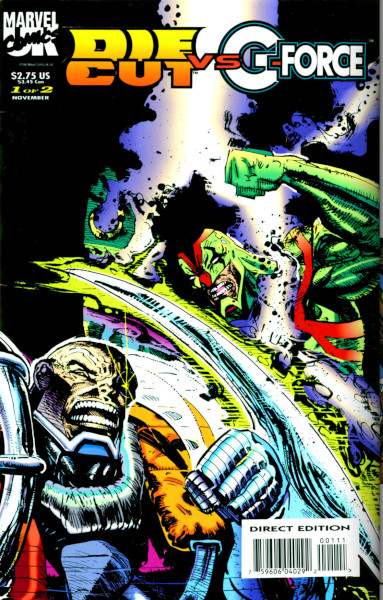 Title/issues:
Die-Cut vs G-Force#1-2 (November-December
1993) Title/issues:
Die-Cut vs G-Force#1-2 (November-December
1993)
Where: U.K.
Featuring: Die-Cut, G-Force
616?: Yes.
Summary: To follow
Reprinted in U.S.?: Yes
Comments: Die-Cut also enjoyed a short miniseries battling
new character G-Force, who would have then had his own miniseries,
had Marvel U.K. not collapsed.
|
|
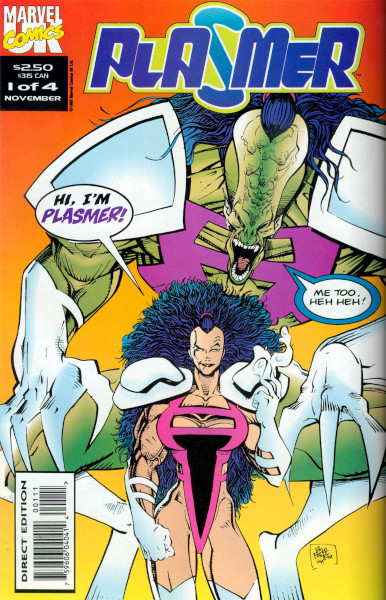 Title/issues:
Plasmer#1-4 (November 1993-February 1994) Title/issues:
Plasmer#1-4 (November 1993-February 1994)
Where: U.K.
Featuring: Plasmer
616?: Yes.
Summary: To follow
Reprinted in U.S.?: Yes
Comments: Another miniseries, Plasmer featured established
Marvel U.K. villain and mad scientist Oonagh Mullarkey as she
accidentally split herself in two, creating a heroic doppelganger,
the titular Plasmer.
|
|
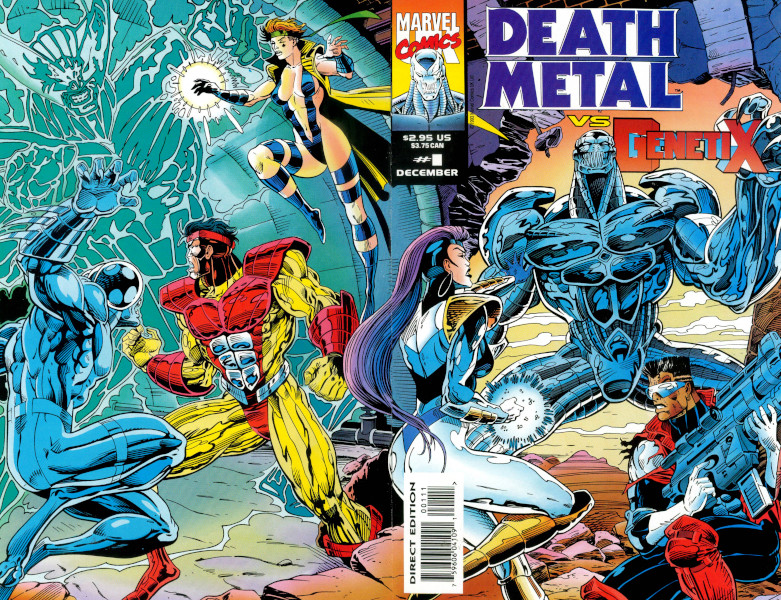 Title/issues:
Death Metal vs Genetix#1-2 (December
1993-January 1994) Title/issues:
Death Metal vs Genetix#1-2 (December
1993-January 1994)
Where: U.K.
Featuring: Death Metal, Genetix
616?: Yes.
Summary: To follow
Reprinted in U.S.?: Yes
Comments: Another miniseries, this time pitting Genetix
against the sometimes villainous Death Metal.
|
|
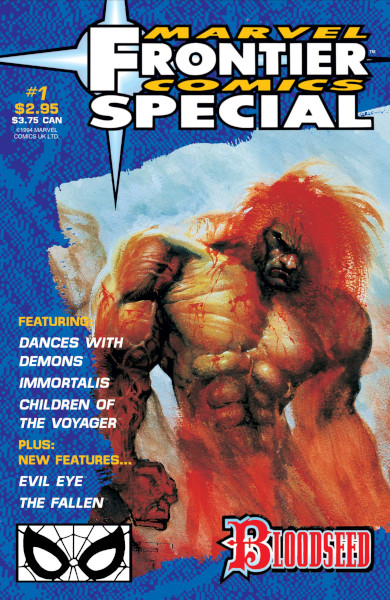 Title/issues:
Marvel Frontier Comics (January 1994) Title/issues:
Marvel Frontier Comics (January 1994)
Where: U.K.
Featuring: Bloodseed, Ghost Dancer, Mortigan Goth, Charles
Gray, Children of Voyager
616?: Yes.
Summary: To follow
Reprinted in U.S.?: Yes
Comments: A one-shot anthology title in the Frontier
Comics line.
|
|
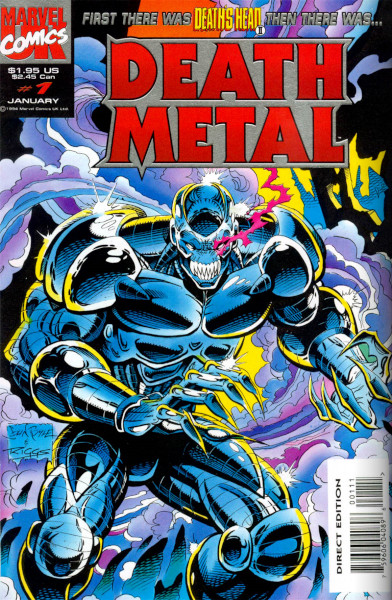 Title/issues:
Death Metal#1-4 (January-April 1994) Title/issues:
Death Metal#1-4 (January-April 1994)
Where: U.K.
Featuring: Death Metal
616?: Yes
Summary: To follow
Reprinted in U.S.?: Yes
Comments: Having shared the headline with others, Death
Metal finally got his own miniseries.
|
|
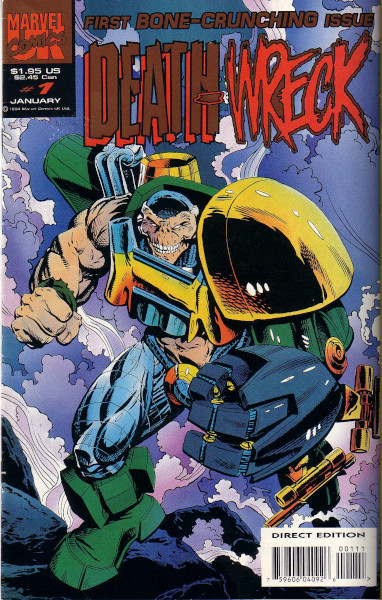 Title/issues:
Death Wreck#1-4 (January-April 1994) Title/issues:
Death Wreck#1-4 (January-April 1994)
Where: U.K.
Featuring: Death Wreck
616?: Yes
Summary: To follow
Reprinted in U.S.?: Yes
Comments: Originally intended to be called Death Rattle,
Death Wreck was the "older" brother of Death's Head II, last seen
sharing a title with his siblings in Death3.
|
|
Many more titles were planned and in development when the comics
market collapsed in 1994. Marvel U.K. was forced to abruptly
cancel all its line, with some issues pulled even though they were
completed and already at the printers. Titles that were due out
imminently include 'Roid Rage, Death Duty and Bloodrush, all
intended to be four issue miniseries taking part in a crossover
storyline called Red Mist. Another miniseries, Wild Things,
instead got published by Marvel Italia, a couple transferred to
Marvel U.S. (see below), but most have sadly been lost, probably
forever, except for odd pages that have resurfaced online. Since
they weren't released, I'm not going to make this already lengthy
list even longer by covering them all here (at least for the
moment), but details of them can be found on Down
the Tubes or scattered across profiles for some of the
intended stars of these projects on the Appendix.
|
|
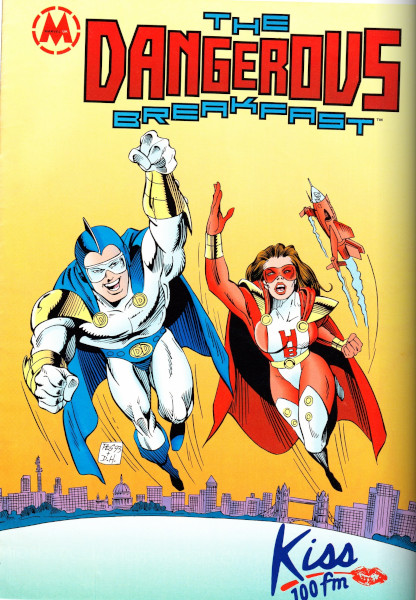 Title/issues:
Dangerous Breakfast (1994) Title/issues:
Dangerous Breakfast (1994)
Where: U.K.
Featuring: Dangerous Dave, Super HB
616?: Potentially.
Summary: To follow
Reprinted in U.S.?: No
Comments: Produced by Marvel for London-based radio
station Kiss-100 FM to celebrate the station's third birthday, The
Dangerous Breakfast comic featured the real world presenters, Dave
Pearce and Sarah HB, of the titular morning radio show as
superheroes, Dangerous Dave and Super HB, taking on the villainous
Rude Boy. The comic was sixteen pages, not including the covers.
|
|
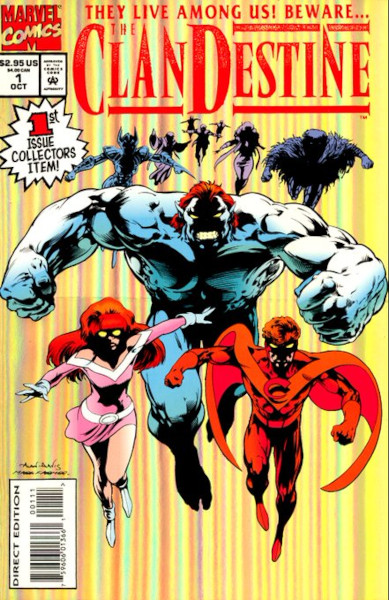 Title/issues:
ClanDestine#1-12 (October 1994-September 1995) Title/issues:
ClanDestine#1-12 (October 1994-September 1995)
Where: U.K.
Featuring: Destine family
616?: Yes.
Summary: To follow
Reprinted in U.S.?: Yes
Comments: As evidenced by their presence in Body Count,
Alan Davis' ClanDestine was originally intended for release by
Marvel U.K. The comic market collapse claimed most of that
branch's planned output but luckily Davis had sufficient star
power that Marvel U.S. took up the series.
|
|
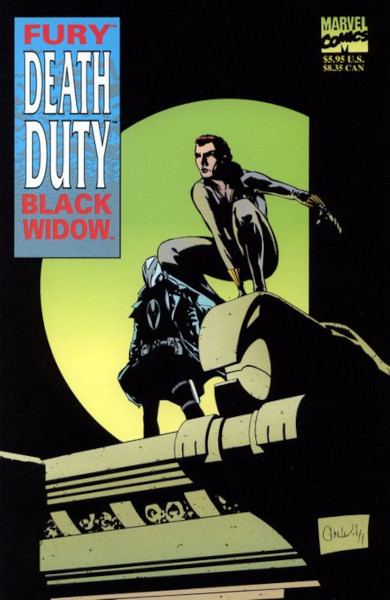 Title/issues:
Fury & Black Widow (February 1995) Title/issues:
Fury & Black Widow (February 1995)
Where: U.K.
Featuring: Black Widow, Night Raven
616?: Yes.
Summary: To follow
Reprinted in U.S.?: Yes
Comments: A one-shot title bringing back Night Raven, this
was apparently another title originally planned by Marvel U.K.
that survived the collapse by transferring to Marvel U.S, and saw
Night Raven directly interacting with characters from the
mainstream Marvel universe.
|
|
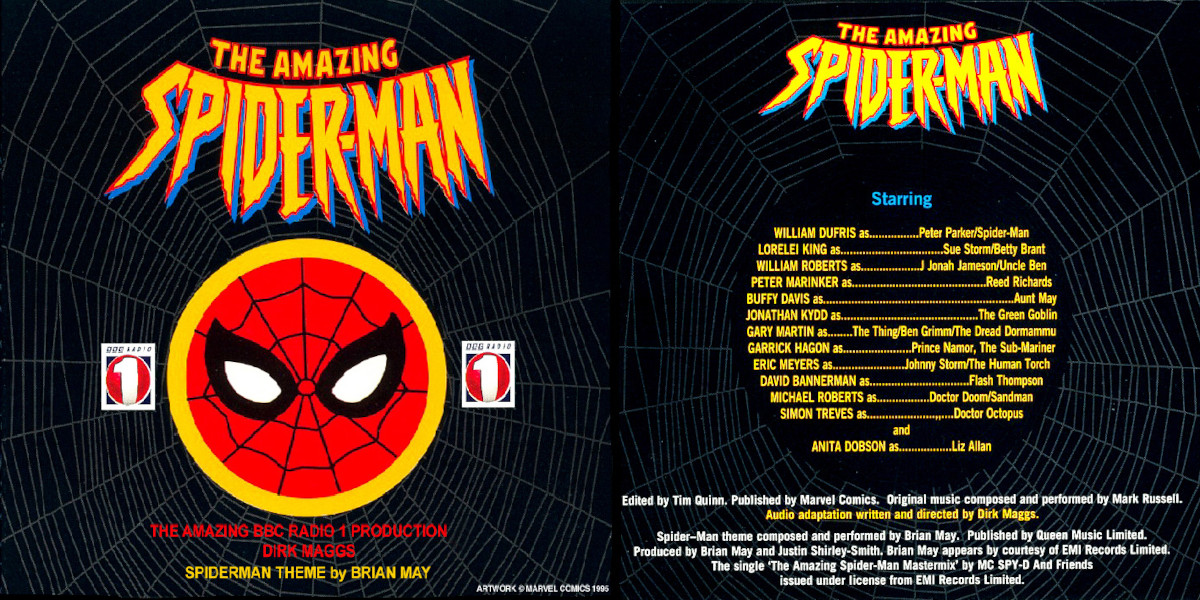 Title/issues:
Amazing Spider-Man (BBC Radio 1,
January-March 1995) Title/issues:
Amazing Spider-Man (BBC Radio 1,
January-March 1995)
Where: U.K.
Featuring: Spider-Man
616?: No, set in an alternate reality.
Summary: To follow
Available in U.S.?: Yes
Comments: The Amazing Spider-Man radio series was
originally broadcast in fifty three minute episodes on BBC Radio 1
from January 1995. The initial idea came from Tim Quinn while he
was an editor at Marvel U.K., and he convinced composer (and Queen
guitarist) Brian May to come up with a new Spider-Man theme. Dirk
Maggs, who already had a strong pedigree adapting comic characters
to audio with Superman and Batman, produced the series, with actor
William Dufris playing the lead role. May's wife, actress Anita
Dobson, was cast as Liz Allen, and even posed for publicity
photos, as did May (as can be seen on Down
the Tubes' article about the audio).
|
|
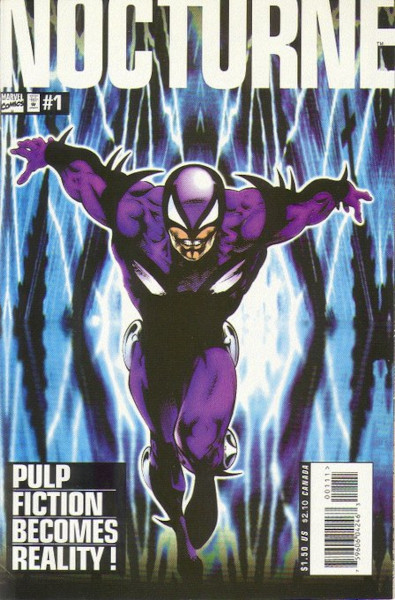 Title/issues:
Nocturne#1-4 (1995) Title/issues:
Nocturne#1-4 (1995)
Where: U.K.
Featuring: Nocturne, Night Raven
616?: No.
Summary: To follow
Reprinted in U.S.?: Yes
Comments: Another series apparently originally planned for
Marvel U.K. but published by Marvel U.S. after the comic market
collapse, Nocturne was intended as a reboot of Night Raven. Given
that it's depiction of the noir vigilante's fate contradicts the
one seen in Death Duty and elsewhere, it's considered an alternate
reality tale.
|
|
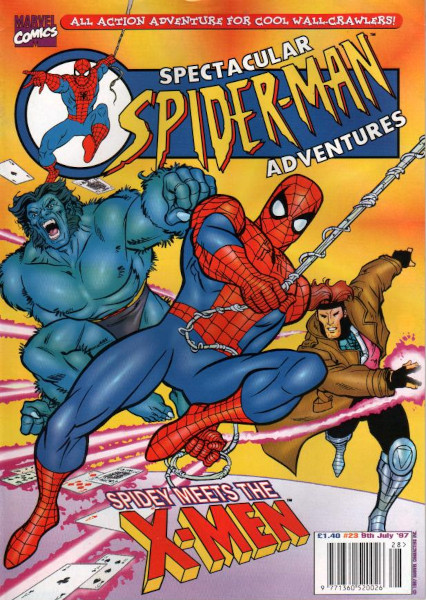 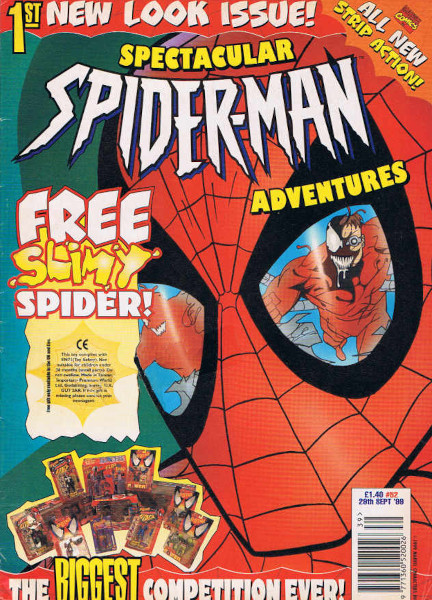 Title/issues:
Spectacular Spider-Man Adventures#23
(9th July 1997); Spectacular Spider-Man Adventures#52-95;
Spectacular Spider-Man#95-226 (29th September 1999-28th September
2011) Title/issues:
Spectacular Spider-Man Adventures#23
(9th July 1997); Spectacular Spider-Man Adventures#52-95;
Spectacular Spider-Man#95-226 (29th September 1999-28th September
2011)
Where: U.K.
Featuring: (#23) X-Men; (all other issues) Spider-Man
616?: No.
Summary: To follow
Reprinted in U.S.?: Only #114.
Comments: In 1995 Marvel U.S., having bought Figurine
Panini, merged the offices of Marvel U.K. and Panini U.K. and put
the Panini editors in charge of Marvel U.K. operations. That same
year Marvel U.K. launched another new Spider-Man reprint title,
Spectacular Spider-Man Adventures. Initially this carried no new
material, barring #23 which carried a two page comic by Glenn
Dakin and Adrian Salmon "X-Men: Investigating the World of
Mutants" to supplement that issue's reprinting of Adventures of
the X-Men#3. In 1999 as part of Marvel U.S.' Chapter 11 bankruptcy
settlement they had to divest themselves of a number of
acquisitions, one of which was Panini. Thus at the end of that
year Marvel U.K. was no longer owned by Marvel U.S. but by Panini,
who now controlled (and continue to control as of this writing)
the vast majority of Marvel reprint publications across Europe.
Perhaps not coincidentally, at the end of September 1999
Spider-Man Adventures#52 contained the first of what was to prove
an unbroken 12 year run of new Spider-Man stories, during which
time the comic dropped the word Adventures from its title, and
which only ended when Disney took over Marvel in 2011 and ordered
Panini to stop producing home grown material. A total of 175
issues, it marks the longest single run of new Marvel stories
produced outside of the U.S.A. (not counting Doctor Who Magazine,
since it's a licensed title). Some issues (I'm not sure which)
also apparently included Lew Stringer's Mini Marvel strips.
|
|
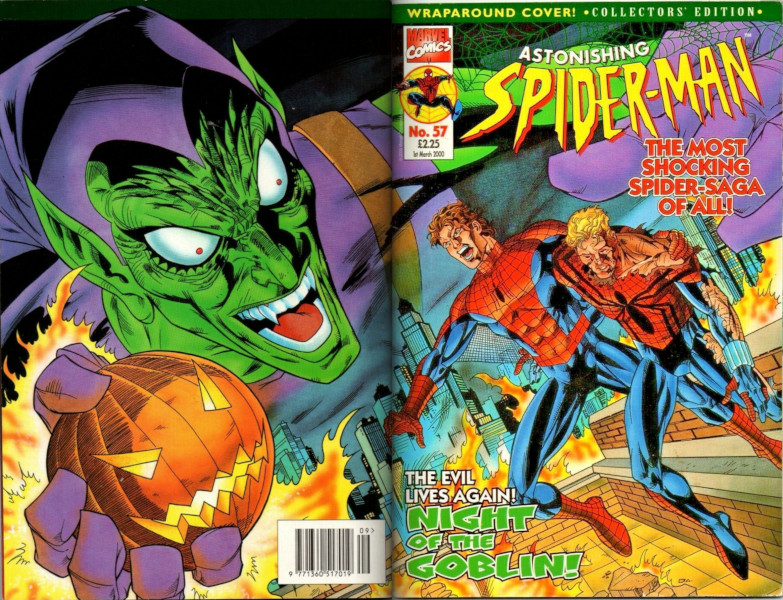 Title/issues:
Astonishing Spider-Man#57 (1st March
2000), 140-148 (12 July 2006-21st February 2007) Title/issues:
Astonishing Spider-Man#57 (1st March
2000), 140-148 (12 July 2006-21st February 2007)
Where: U.K.
Featuring:
- Spider-Man: #57
- Mini-Marvels: #140-148
616?: Spider-Man, yes. Mini-Marvels, no.
Summary: To follow
Reprinted in U.S.?: No
Comments: Yet another Panini title reprinting American
Spider-Man stories, Astonishing Spider-Man#57 included a new text
epilogue to the Clone Saga's Revelations storyline. Additionally,
a number of later issues carried Lew Stringer's Mini-Marvels humor
strip.
|
|
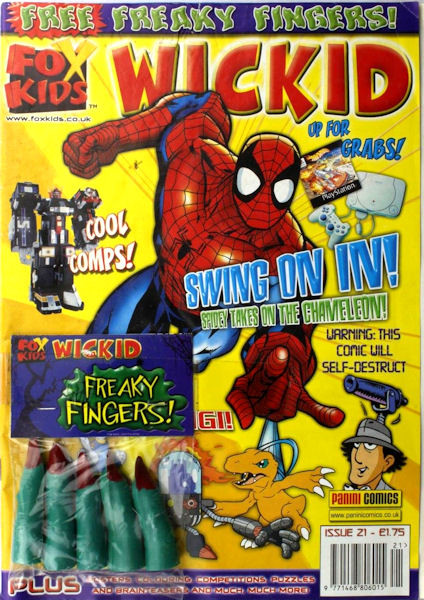 Title/issues:
Wickid#5-9, 11, 21, 23, 25, 28, 42-43, 49,
53-54 (July 2001-August 2004?) Title/issues:
Wickid#5-9, 11, 21, 23, 25, 28, 42-43, 49,
53-54 (July 2001-August 2004?)
Where: U.K.
Featuring:
- Fantastic Four: #7-8
- Hulk: #5, 9, 11, 25, 43, 49
- Spider-Man: #21, 28, 42, 53-54
- X-Men: #6, 23
616?: No, set in the realty of the Fox Kid
Cartoons versions.
Summary: To follow
Reprinted in U.S.?: No
Comments: Published by Panini, Wickid was a licensed
magazine covering Fox Kids cartoons. Because those included
several Marvel cartoons, during its 54 issue run Wickid featured a
number of new Marvel stories.
|
|
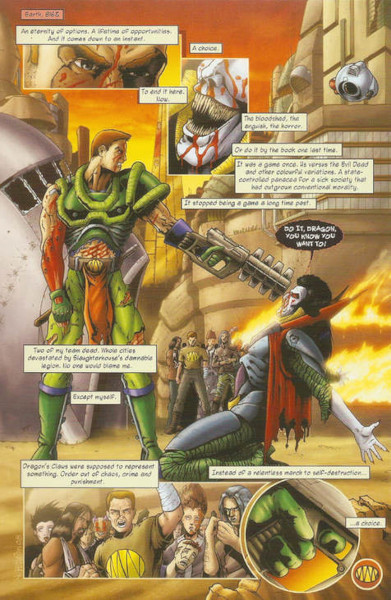 Title/issues:
Just 1 Page: Brits (2003) Title/issues:
Just 1 Page: Brits (2003)
Where: U.K.
Featuring: Dragon
616?: No, set on Earth-5555
Summary: To follow
Reprinted in U.S.?: No
Comments: Just 1 Page was a charity comics anthology
produced for the U.K.'s Comic Festival in Bristol. Four issues
were produced, in 2001, 2003, 2005 and 2006 respectively, each
featuring single page contributions from a range of writers and
artists. Some of these contributions were just artwork, but others
were short stories, including one written by Dragon's Claws scribe
Simon Furman and drawn by Paul Ridgon, depicting a final
confrontation between team leader Dragon and his foe
Slaughterhouse, serving as a coda to the original comic run.
Though the original charity comic is ridiculously
rare and hard to come by, it was later redrawn and recolored for
inclusion in the 2008 Panini Dragon's Claws collection.
|
|
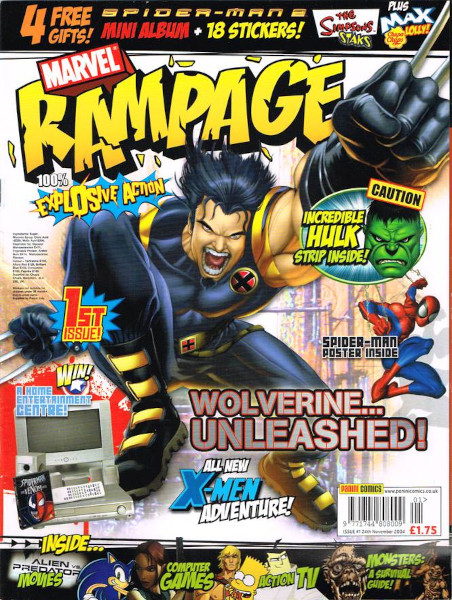 Title/issues:
Rampage (Panini)#1-24, 30 (November
2004-February2007) Title/issues:
Rampage (Panini)#1-24, 30 (November
2004-February2007)
Where: U.K.
Featuring: X-Men, Spider-Man, Hulk, others
616?: No.
Summary: To follow
Reprinted in U.S.?: No
Comments: Another Panini magazine, the monthly Rampage
(not to be confused with the similarly named title from the 1980s)
featured new strips for the first 23 issues, before switching to
being mostly reprints. Rampage#21-30 also included some of the
Mini-Marvel strips that had previously appeared in Astonishing
Spider-Man, here rebranded as Marvel Mini Toons, but the Mini
Toons in #24 and 30 were not reprints but brand new (or at least,
previously unpublished) ones.
|
|
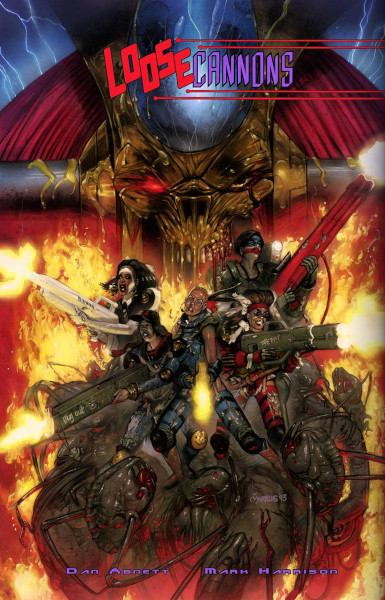 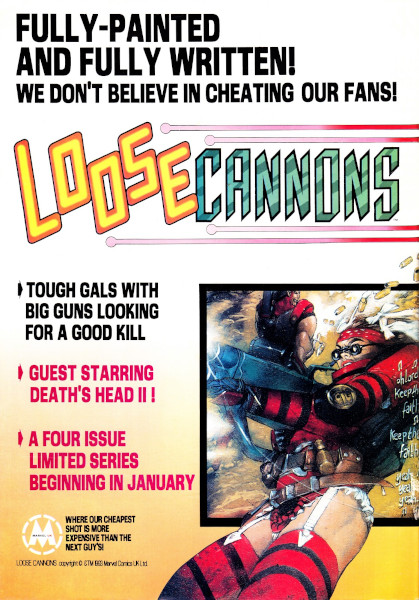 Title/issues:
Loose Cannons#1-4 (April 2005) Title/issues:
Loose Cannons#1-4 (April 2005)
Where: U.K.
Featuring: Virago Troop Warheads
616?: Yes, among other realties
Summary: To follow
Reprinted in U.S.?: Available
online
Comments: Loose Cannons was originally intended to be a
four issue Marvel U.K. miniseries released in January through
April 1994, per their listing in November 1993's Previews
Magazine. It was to feature Virago Troop, an all-female Warheads
unit. Like many series it was a casualty of the collapse of Marvel
U.K., with the plug pulled despite the story being almost
completely drawn and with less than a month to go before the first
issue went to press. Luckily for fans, artist Mark Harrison kept
all the artwork and in April 2005 released it online.
Additionally, one survivor of Virago Troop later showed up in
Marvel's Revolutionary War: Warheads, which also made a passing
reference to this story.
|
|
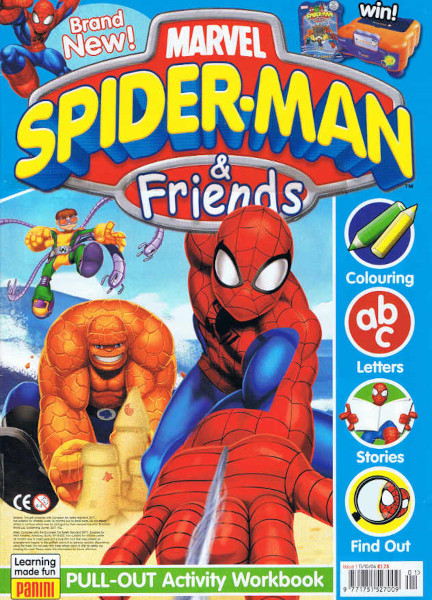 Title/issues:
Spider-Man & Friends#1-66 (October
2006-October 2011) Title/issues:
Spider-Man & Friends#1-66 (October
2006-October 2011)
Where: U.K.
Featuring: Spider-Man, others
616?: No
Summary: To follow
Reprinted in U.S.?: No
Comments: Aimed at much younger children (aged 3-9
approximately), Spider-Man & Friends was another Panini
magazine that told new stories featuring Spider-Man and a range of
other Marvel characters, all depicted as kids using a mangaesque
"super deformed" style of appearance. It lasted for 66 issues, and
was only cancelled because of Disney withdrawing Panini's license
to produce new stories.
|
|
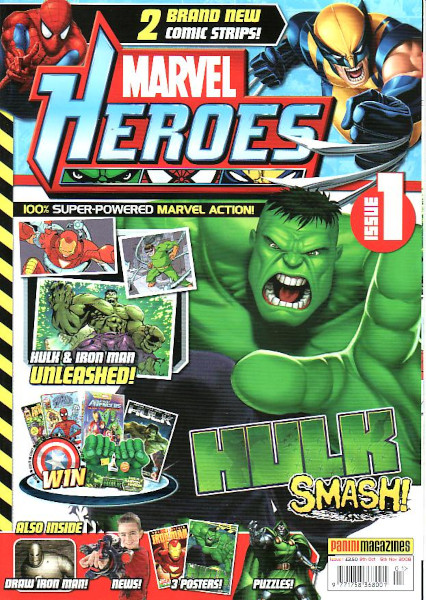 Title/issues:
Marvel Heroes#1-35 (November 2008-June
2011) Title/issues:
Marvel Heroes#1-35 (November 2008-June
2011)
Where: U.K.
Featuring: Spider-Man, Hulk, Captain Britain, Wolverine,
others
616?: No
Summary: To follow
Reprinted in U.S.?: No, apart from #33's Death's Head vs.
Hulk story, which was reprinted in the Death's Head TPB.
Comments: Another Panini magazine that included new
stories, Marvel Heroes lasted 35 issues before being forced to
switch to purely reprints because of Disney's edict.
|
|
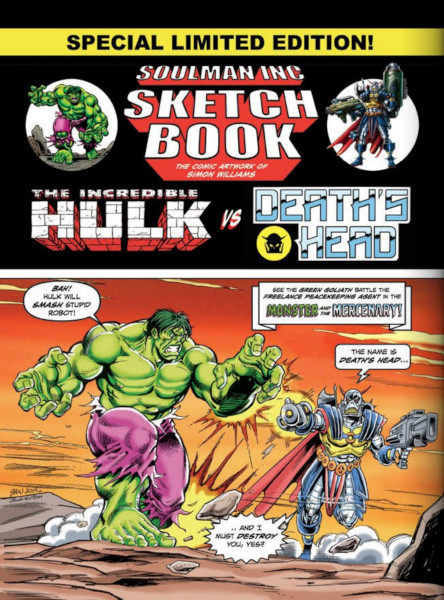 Title/issues:
Soulman Inc. Sketchbook (2009) Title/issues:
Soulman Inc. Sketchbook (2009)
Where: U.K.
Featuring: Death's Head, Hulk
616?: Yes
Summary: To follow
Reprinted in U.S.?: No
Comments: A professional artist who had drawn multiple
Marvel stories for Panini, Simon Williams (no relation to the
comic character of the same name) produced a crossover story
between the Hulk and Death's Head (and some other surprise guest
stars) as a homage to Marvel U.K. comics. It was later given a
very limited print run to raise money for charity at Auto Assembly
2009, a Transformers fan convention.
|
|
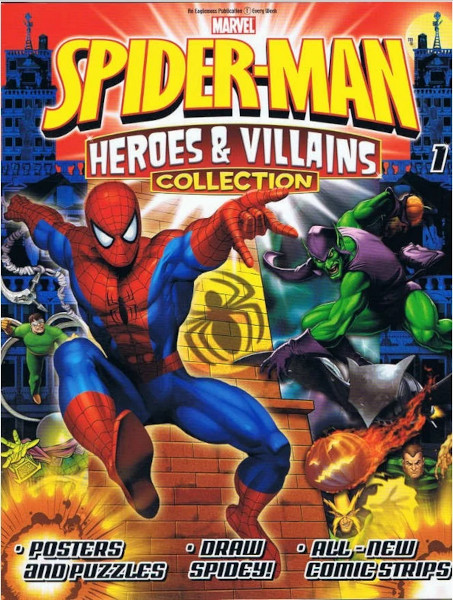 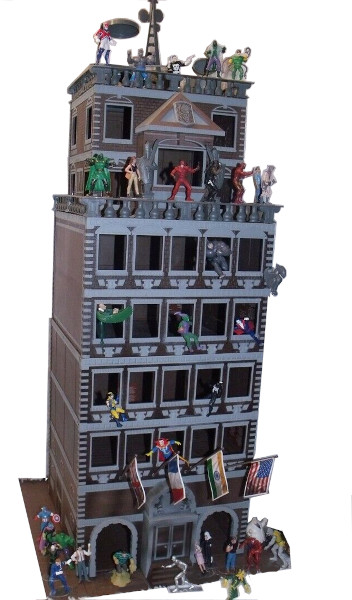 Title/issues:
Spider-Man: Tower of Power/Heroes and Villains
Collection#1-60 or 80? (2008-2011) Title/issues:
Spider-Man: Tower of Power/Heroes and Villains
Collection#1-60 or 80? (2008-2011)
Where: U.K.
Featuring: Spider-Man
616?: Potentially at least some, but others definitely
no.
Summary: To follow
Reprinted in U.S.?: No
Comments: Called Spider-Man: Tower of Power to begin with,
and then later renamed Spider-Man: Heroes and Villains Collection,
this was a title with new stories published by Eaglemoss rather
than Panini. Arguably this entry might belong in the French
section, as though developed by Britain's Alan Cowsill and Rob
Green, and written and drawn mostly by British creators, it was
apparently developed for Eaglemoss' French division, but was also
published in the U.K. and several other countries. Eaglemoss was
best known for partworks magazines, which is to say magazines
where each issue carried a piece of an overall collection. Thus
Tower of Power carried segments of a literal tower that could be
built if you bought the entire run. However, in some territories
it was sold with trading cards instead, despite retaining the
Tower of Power name. In France it appears to have remained called
The Tower of Power for its entire run, and per at least one
auction site offering a full set it appears to have run to 80
issues. On the other hand, in Australia it was called Heroes and
Villains Collection from the outset, and apparently only ran to 60
issues. Since I have copies of later U.K. issues called Heroes and
Villains Collection and earlier ones called Tower of Power I'm
assuming it changed title in the U.K., but I am working from at
best incomplete information.
|
|
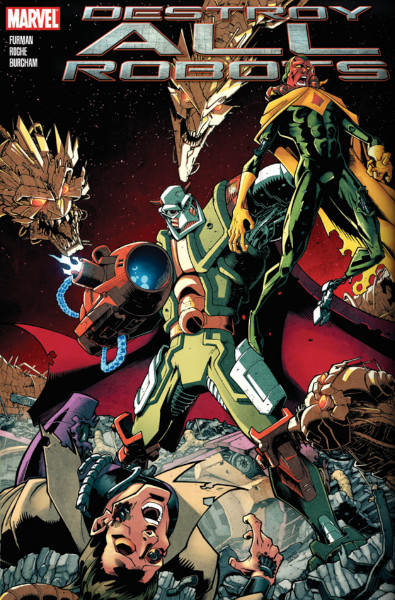 Title/issues:
Destroy All Robots (2011) Title/issues:
Destroy All Robots (2011)
Where: U.K.
Featuring: Death's Head
616?: Yes.
Summary: To follow
Reprinted in U.S.?: No
Comments: Written by Simon Furman and illustrated by Nick
Roche and Josh Burcham, Destroy All Robots was a pitch made by
those creators to Marvel for a new series. Though Marvel passed at
the time, a one page story based on the pitch later appeared in
2019's anthology Marvel Comics#1001, and the creators have shared
the first four pages of the original pitch online.
|
|
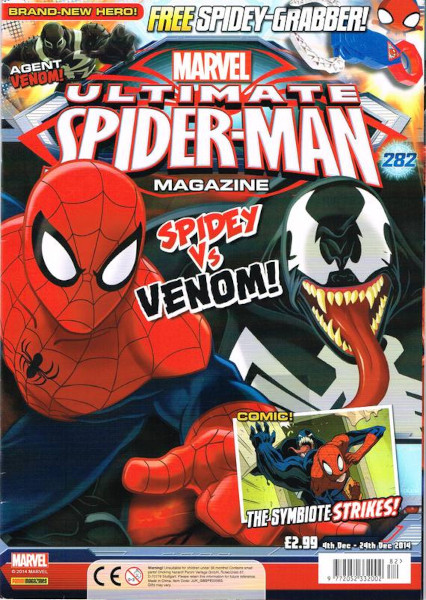 Title/issues:
Ultimate Spider-Man#282, 284-285, 293-296,
298-299 (24th December 2014-23rd December 2015) Title/issues:
Ultimate Spider-Man#282, 284-285, 293-296,
298-299 (24th December 2014-23rd December 2015)
Where: U.K.
Featuring: Spider-Man
616?: No
Summary: To follow
Reprinted in U.S.?: No
Comments: Though Disney mandated no new U.K. stories back
in 2011, the Panini title Ultimate Spider-Man (the new name for
Spectacular Spider-Man) has apparently included a number of new
tales. Per the excellent and usually reliable Spiderfan,
these are by Jim Zub, a Canadian writer and artist, so while they
don't appear to have been published in the U.S. (before or since),
it's feasible they were actually written for an American title and
then not used there for some reason
|
|
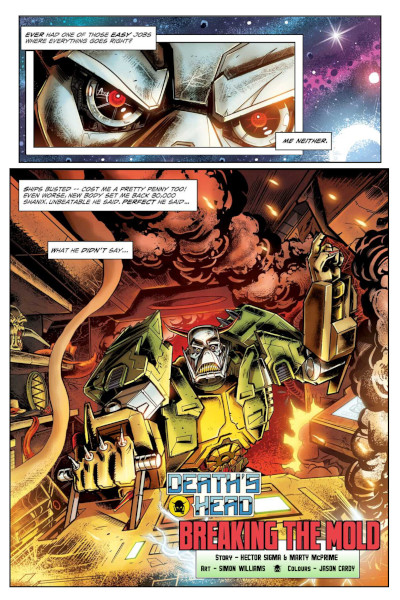 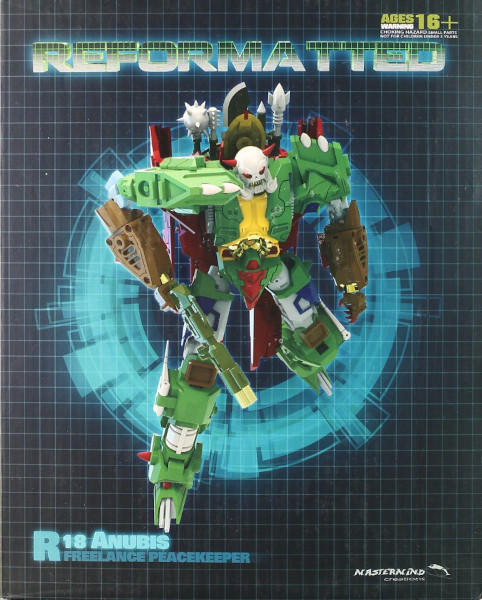 Title/issues:
Anubis "Breaking the Mold" (2016) Title/issues:
Anubis "Breaking the Mold" (2016)
Where: U.K.
Featuring: Death's Head
616?: No, set in the Transformers reality, though it is
the same DH who also visited 616.
Summary: To follow
Reprinted in U.S.?: Yes
Comments: Strictly speaking this one's not a U.K. title,
but since the artist and character both are, I'm listing it for
completeness' sake. Mastermind Creations produce "third party"
Transformers toys - that's to say, toys that are not actually
called Transformers because they aren't licensed, but let's be
honest, if it looks like a truck and transforms like a truck... At
the 2016 TFCon Chicago they released a limited edition figure
"Anubis" who was a "freelance peacekeeper." If there was any doubt
as to who this was really intended to be, the box included a new 6
page Death's Head comic drawn by Simon Williams, wherein the
freelance peacekeeping agent had acquired himself a new,
transforming body that looked just like the Anubis toy.
|
|
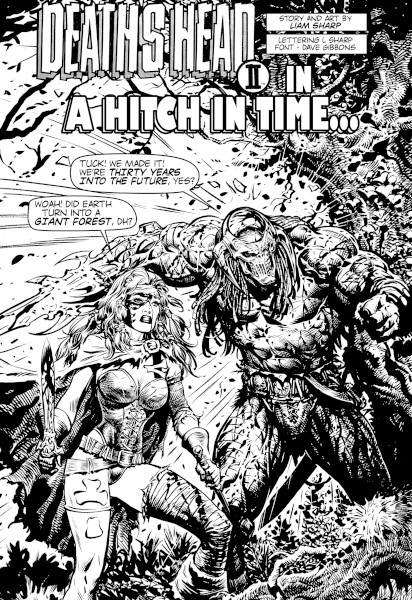 Title/issues:
Death's Head II: A Hitch in Time (2022) Title/issues:
Death's Head II: A Hitch in Time (2022)
Where: U.K.
Featuring: Death's Head II
616?: Probably no.
Summary: To follow
Reprinted in U.S.?: Available online
Comments: To celebrate the 30th anniversary of Death's
Head II#'s debut, the character's original artist Liam Sharp
produced a two page story for the character which he published
online.
|
Honorable
mentions
None of these were Marvel U.K. titles, nor published first in the U.K.,
but these were Marvel titles set in the U.K. and written/drawn by British
creators.
|
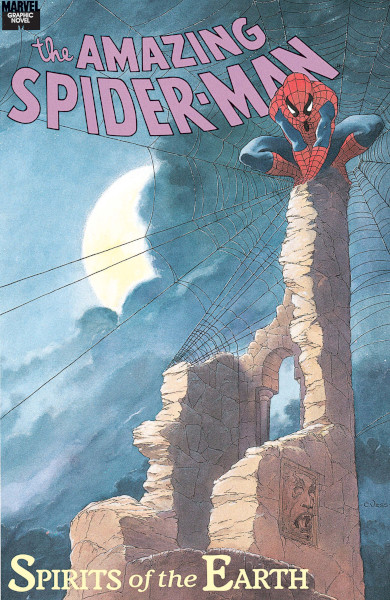
Spider-Man: Spirits of the Earth (1990)
|
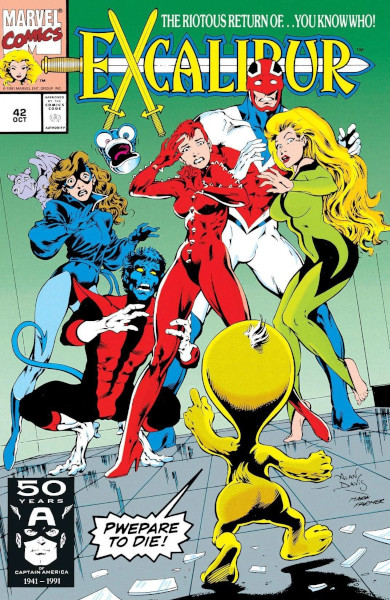
Excalibur#42-67 (October 1991-July 1993) - the Alan Davis run
|
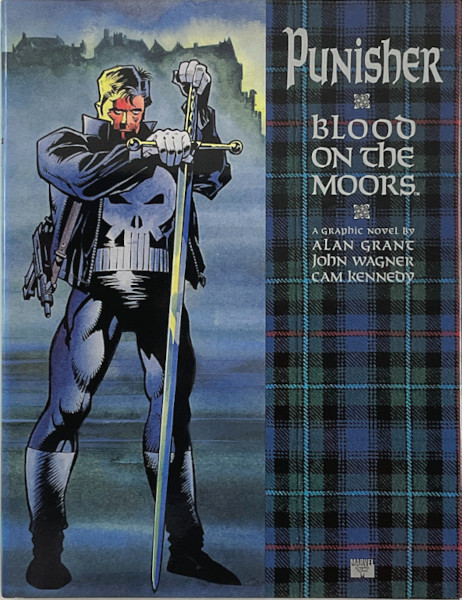
Punisher: Blood on the Moors (1991)
|
|
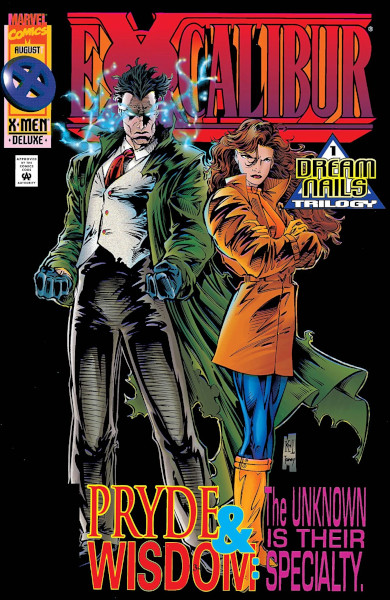
Excalibur#83-103 (November 1994-November 1996) - the Warren Ellis
run
|
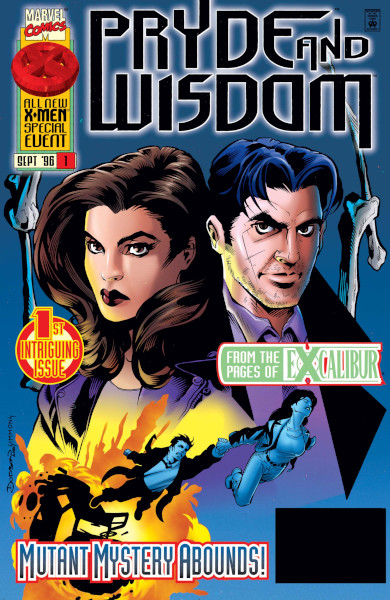
Pryde & Wisdom#1-3 (September-November 1996)
|
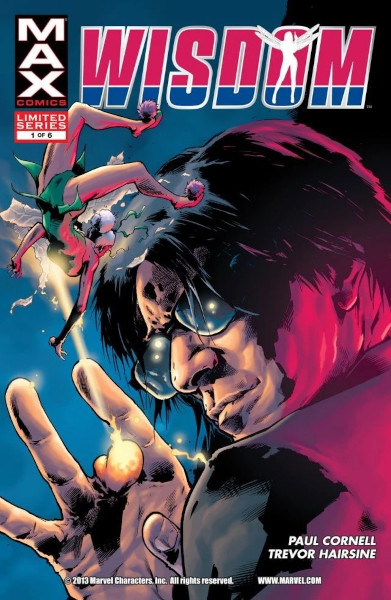
Wisdom#1-6 (January-July 2007)
|
|
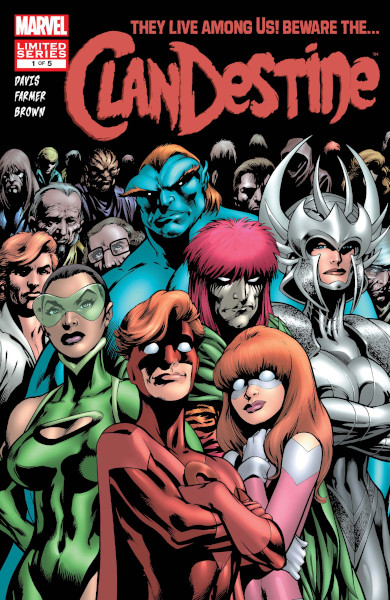
Clan Destine II#1-5 (April-August 2008)
|

Captain Britain and MI-13#1-15, Annual#1 (July 2008-September
2009)
|
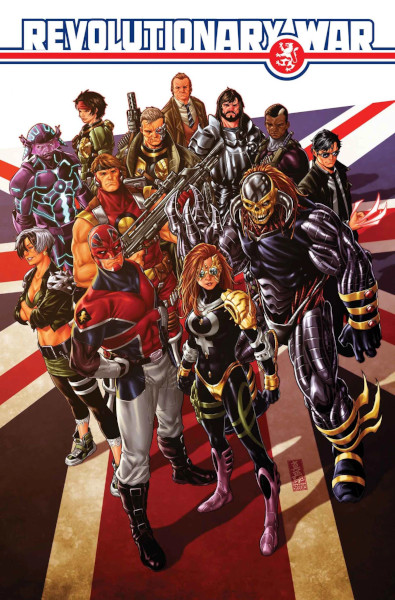
Revolutionary War (March-May 2014)
|
|
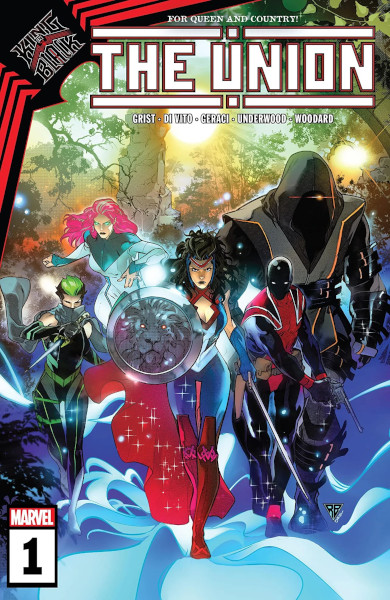
The Union#1-5 (February-July 2021)
|
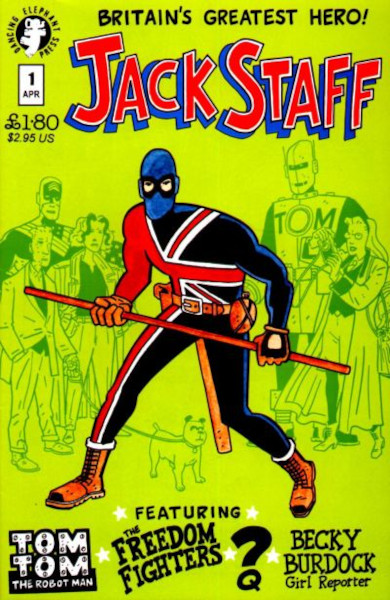 Doubly
Honorable mention: Jack Staff#1-12; Jack Staff II#1-20;
Weird World of Jack Staff Special; Jack Staff Special; Weird World
of Jack Staff#1-6 Doubly
Honorable mention: Jack Staff#1-12; Jack Staff II#1-20;
Weird World of Jack Staff Special; Jack Staff Special; Weird World
of Jack Staff#1-6
Jack Staff was a self-published title by British writer/artist
Paul Grist, that was then taken up by Image for wider
distribution. However, it started out as a pitch for a Union Jack
comic; when Marvel rejected it, Grist developed it into something
very different, though the Marvel connection can still be felt,
especially in the early issues, which introduce Jack's World War
II allies and their greatest enemy, who clearly resemble the
Invaders and Baron Blood.
|
Lists by Loki,
with invaluable assistance from Zuckdy1,
Stephen Rizzo, Rob Kirby, Giant Ant at the MCP, and the many others who
directly or indirectly informed me of one or more of these tales but
whose names I've shamefully forgotten.
First Posted: 04/11/2023
Last updated: 05/01/2023
Any Additions/Corrections? please let me know.
Non-Marvel
Copyright
info
All other characters mentioned or pictured are ™ and © 1941-2099 Marvel
Characters, Inc. All Rights Reserved. If you like this stuff, you should
check out the real thing!
Please visit The Marvel Official Site at: http://www.marvel.com
Special Thanks to www.g-mart.com
for hosting the Appendix, Master List, etc.!
Back
to
Items

 A preamble: Of all the countries
outside the United States, the U.K. is probably the most well known for
producing new stories, largely because the British branch of the company,
Marvel U.K. not only produced some iconic tales by noted writers and
artists (c.f. Moore and Davis' Captain Britain) that were then referred
back to in the American comics, but also because they had an entire line
of comics that were distributed in the States. However, the history of
Marvel comics in the U.K. goes back further than the 1970s founding of
Marvel U.K., and is far more extensive than most people realize. Having
now tried to catalogue all the new material related to Marvel that was
produced all around the world, and discovered that there was so much more
than most people were aware of, I think it's still fair to say that the
U.K. has generated more new Marvel-related content than any other country
outside the U.S.A., and possibly more than all the other non-U.S.
countries combined.
A preamble: Of all the countries
outside the United States, the U.K. is probably the most well known for
producing new stories, largely because the British branch of the company,
Marvel U.K. not only produced some iconic tales by noted writers and
artists (c.f. Moore and Davis' Captain Britain) that were then referred
back to in the American comics, but also because they had an entire line
of comics that were distributed in the States. However, the history of
Marvel comics in the U.K. goes back further than the 1970s founding of
Marvel U.K., and is far more extensive than most people realize. Having
now tried to catalogue all the new material related to Marvel that was
produced all around the world, and discovered that there was so much more
than most people were aware of, I think it's still fair to say that the
U.K. has generated more new Marvel-related content than any other country
outside the U.S.A., and possibly more than all the other non-U.S.
countries combined. 
 Title/issues:
Title/issues:
 Title/issues:
Title/issues:
 Summary:
To follow
Summary:
To follow Title/issues:
Title/issues:
 Title/issues:
Title/issues:

 Title/issues:
Title/issues:

 Title/issues:
Title/issues:  Title/issues:
Title/issues:

 A
quick note: At launch Odhams' Fantastic had the highest
percentage of of Marvel reprints of any of the Power Pack, with
Thor, the X-Men and Iron Man taking up three quarters of the
title. The final story was the
A
quick note: At launch Odhams' Fantastic had the highest
percentage of of Marvel reprints of any of the Power Pack, with
Thor, the X-Men and Iron Man taking up three quarters of the
title. The final story was the 

 With the arrival of Marvel U.K. in 1972 far more
of Marvel's output began to be reprinted in Britain. Although the
Marvel universe (not counting the pre-FF Timely and Atlas era
material) had a ten year head start on the British titles
reprinting them, the weekly schedules of the British anthologies
still meant that it wouldn't be long before some titles would
begin to run short of available reprint materials, the same
problem that had prompted so many other overseas publishers to
begin producing their own stories.
With the arrival of Marvel U.K. in 1972 far more
of Marvel's output began to be reprinted in Britain. Although the
Marvel universe (not counting the pre-FF Timely and Atlas era
material) had a ten year head start on the British titles
reprinting them, the weekly schedules of the British anthologies
still meant that it wouldn't be long before some titles would
begin to run short of available reprint materials, the same
problem that had prompted so many other overseas publishers to
begin producing their own stories. 
 On other occasions changes were made to
avoid confusing the U.K. audience. For example, when Mighty World
of Marvel#15 reprinted the Hulk story from Tales
to Astonish I#62, Marvel U.K. had not yet reprinted the
Avengers stories where the Hulk's pal Rick Jones left the Hulk's
side to become Captain America's sidekick. Thus a panel where Rick
tells a supportive Captain America of his need to take a break in
order to rush to the aid of the Hulk was deemed potentially
confusing to readers who might not even know who Captain America
was. Thus instead of having a costumed character the readers might
not recognize and references to Rick having joined a team that
readers might not have heard of, the editors decided to suggest
Rick had left the Hulk's side to attend college, a much more
mundane scenario that could be explained to readers in minimal
time.
On other occasions changes were made to
avoid confusing the U.K. audience. For example, when Mighty World
of Marvel#15 reprinted the Hulk story from Tales
to Astonish I#62, Marvel U.K. had not yet reprinted the
Avengers stories where the Hulk's pal Rick Jones left the Hulk's
side to become Captain America's sidekick. Thus a panel where Rick
tells a supportive Captain America of his need to take a break in
order to rush to the aid of the Hulk was deemed potentially
confusing to readers who might not even know who Captain America
was. Thus instead of having a costumed character the readers might
not recognize and references to Rick having joined a team that
readers might not have heard of, the editors decided to suggest
Rick had left the Hulk's side to attend college, a much more
mundane scenario that could be explained to readers in minimal
time.


 Title/issues:
Title/issues: 
 Title/issues:
Title/issues:
 Title/issues:
Title/issues:
 Title/issues:
Title/issues:
 Where:
U.K.
Where:
U.K.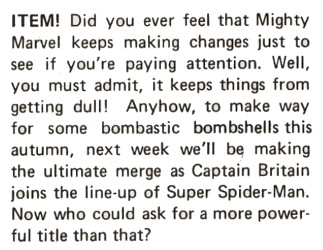
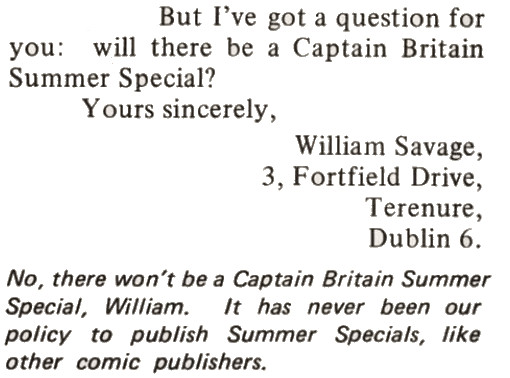


 Title/issues:
Title/issues:
 Title/issues:
Title/issues:













 Title/issues:
Title/issues:
 Title/issues:
Captain Britain Summer Special (1980)
Title/issues:
Captain Britain Summer Special (1980)
 Title/issues:
Title/issues:
















 Title/issues:
Title/issues: 






 Title/issues:
Title/issues:

 Title/issues:
Title/issues:

 Title/issues:
Title/issues:
 Actual new material began appearing in Forces in Combat#12, with
the arrival of Quinn and Howett's I Was Adolf's Double, featuring
the misadventures of the unfortunate Winston S. Quaill thanks to
his resemblance to the Nazi dictator. Each episode was a full
page, for a total run of 13 pages when it concluded. As the cover
for Forces in Combat#12 boasted, the strip was initially in full
color, but this only lasted for the first four installments, after
which it switched to black and white. The entire story was later
collected and reprinted in the Channel 33 1/3 Special (see below).
Actual new material began appearing in Forces in Combat#12, with
the arrival of Quinn and Howett's I Was Adolf's Double, featuring
the misadventures of the unfortunate Winston S. Quaill thanks to
his resemblance to the Nazi dictator. Each episode was a full
page, for a total run of 13 pages when it concluded. As the cover
for Forces in Combat#12 boasted, the strip was initially in full
color, but this only lasted for the first four installments, after
which it switched to black and white. The entire story was later
collected and reprinted in the Channel 33 1/3 Special (see below).
 Title/issues:
Title/issues:  Title/issues:
Title/issues:

 Title/issues:
Title/issues:
 With The Concise History of the Galaxy having concluded in #39,
#40 carried a one-off brand new one-page strip, Whacker's Worlds,
parodying a well established U.K. documentary series, Whicker's
World. Whether it might have continued is unknown, as Future Tense
ended with #41.
With The Concise History of the Galaxy having concluded in #39,
#40 carried a one-off brand new one-page strip, Whacker's Worlds,
parodying a well established U.K. documentary series, Whicker's
World. Whether it might have continued is unknown, as Future Tense
ended with #41. Title/issues:
Title/issues:

 Title/issues:
Title/issues:
 Title/issues:
Title/issues:
 Title/issues:
Title/issues:
 Title/issues:
Title/issues:

 Title/issues:
Title/issues:
 Title/issues:
Title/issues:

 Title/issues:
Title/issues: 
 Title/issues:
Title/issues:



 Title/issues:
Title/issues:
 Title/issues:
Not the World Cup (1982)
Title/issues:
Not the World Cup (1982)
 Title/issues:
Title/issues:
 Title/issues:
Title/issues:

 Title/issues:
Title/issues:

 Title/issues:
The Daredevils#1-11 (January 1983-November 1983)
Title/issues:
The Daredevils#1-11 (January 1983-November 1983)


 Title/issues:
Mighty World of Marvel Special (1983)
Title/issues:
Mighty World of Marvel Special (1983) Title/issues:
Title/issues:

 Title/issues:
Title/issues:
 Title/issues:
Channel 33 1/3 (July 1983)
Title/issues:
Channel 33 1/3 (July 1983)
 Title/issues:
Title/issues:

 Title/issues:
Title/issues:

 Title/issues:
Title/issues:  Title/issues:
Title/issues:

 Title/issues:
Title/issues:

 Title/issues:
Title/issues:

 Title/issues:
Title/issues: 
 Title/issues:
Title/issues:




 Title/issues:
Title/issues:

 Title/issues:
Title/issues:

 Title/issues:
Title/issues:

 Title/issues:
Title/issues:

 Title/issues:
Title/issues:

 Title/issues:
Title/issues:

 Title/issues:
Title/issues:

 Title/issues:
Title/issues:  Title/issues:
Title/issues:

 Title/issues:
Title/issues:

 Title/issues:
Title/issues:

 Title/issues:
Title/issues:

 Title/issues:
Title/issues:
 Title/issues:
Title/issues:
 Title/issues:
Title/issues:
 Title/issues:
Title/issues:

 Title/issues:
Title/issues:

 Title/issues:
Title/issues:


 Title/issues:
Title/issues: 










 Title/issues:
Title/issues:
 Title/issues:
Title/issues:











 Title/issues:
Title/issues: 










 Title/issues:
Title/issues:

 Title/issues:
Title/issues:

 Title/issues:
Title/issues:
 Title/issues:
Title/issues:
 Title/issues:
Title/issues:

 Title/issues:
Title/issues:

 Title/issues:
Title/issues:



 Title/issues:
Title/issues:

 Title/issues:
Title/issues:
 Title/issues:
Title/issues:

 Title/issues:
Title/issues:



 Title/issues:
Title/issues:
 Title/issues:
Title/issues:
 Title/issues:
Title/issues:
 Title/issues:
Title/issues:
 Title/issues:
Title/issues:

 Title/issues:
Title/issues:
 Title/issues:
Title/issues:
 Title/issues:
Title/issues:

 Title/issues:
Title/issues:

 Title/issues:
Title/issues:
 Title/issues:
Title/issues:

 Title/issues:
Title/issues:  Title/issues:
Title/issues:
 Title/issues:
Title/issues:
 Title/issues:
Title/issues:
 Title/issues:
Title/issues:
 Title/issues:
Title/issues:
 Title/issues:
Title/issues:
 Title/issues:
Title/issues:
 Title/issues:
Title/issues:
 Title/issues:
Title/issues:
 Title/issues:
Title/issues:
 Title/issues:
Title/issues:
 Title/issues:
Title/issues:
 Title/issues:
Title/issues:
 Title/issues:
Title/issues:
 Title/issues:
Title/issues:
 Title/issues:
Body Count (October 1993)
Title/issues:
Body Count (October 1993) Title/issues:
Title/issues:
 Title/issues:
Title/issues:
 Title/issues:
Title/issues:
 Title/issues:
Title/issues:
 Title/issues:
Title/issues:
 Title/issues:
Title/issues:
 Title/issues:
Title/issues:
 Title/issues:
Title/issues:
 Title/issues:
Title/issues:
 Title/issues:
Title/issues:
 Title/issues:
Title/issues:
 Title/issues:
Title/issues:
 Title/issues:
Title/issues:
 Title/issues:
Title/issues:
 Title/issues:
Title/issues:
 Title/issues:
Title/issues:
 Title/issues:
Title/issues:

 Title/issues:
Title/issues:
 Title/issues:
Title/issues:
 Title/issues:
Title/issues:
 Title/issues:
Title/issues:
 Title/issues:
Title/issues:

 Title/issues:
Title/issues:
 Title/issues:
Title/issues:
 Title/issues:
Title/issues:
 Title/issues:
Title/issues:

 Title/issues:
Title/issues:
 Title/issues:
Title/issues:
 Title/issues:
Title/issues:

 Title/issues:
Title/issues:
 Title/issues:
Title/issues:










 Doubly
Honorable mention: Jack Staff#1-12; Jack Staff II#1-20;
Weird World of Jack Staff Special; Jack Staff Special; Weird World
of Jack Staff#1-6
Doubly
Honorable mention: Jack Staff#1-12; Jack Staff II#1-20;
Weird World of Jack Staff Special; Jack Staff Special; Weird World
of Jack Staff#1-6